inbox and environment news: Issue 589
June 25 - July 15 2023: Issue 589
Liquid Amber Seed Pod/Fruits On Roads + Verges At Present: Please Clear These To Prevent Bird Road Deaths - Australian Wildlife Now Eating Fruits - Seeds Of Imported Species
Residents have asked that everyone be aware that the north American liquid amber tree is shedding its seed pod/fruits at present and our native galahs, pigeons and the rainbow lorikeet will descend on these as a flock to eat them. When these trees have been planted on verges the seed pods attract large numbers of these other local residents into roads where they will sit there eating and be susceptible to car strikes. Each year we lose numerous local birds due to this.
To help reduce the mortalities, please sweep the seed pods from the road if you have these outside your place.
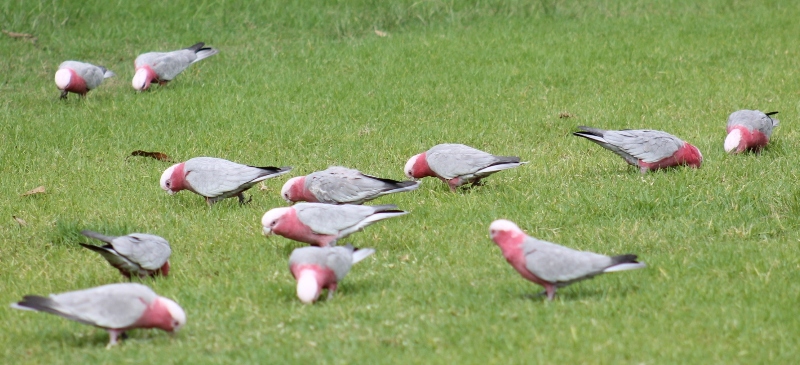
American sweetgum (Liquidambar styraciflua) is a deciduous tree in the genus Liquidambar native to warm temperate areas of eastern North America and tropical montane regions of Mexico and Central America. Sweetgum is one of the main valuable forest trees in the southeastern United States, and is a popular ornamental tree in temperate climates. The distinctive compound fruit is hard, dry, and globose, 25–40 mm (1–1+1⁄2 in) in diameter, composed of numerous (40–60) capsules.[14] Each capsule, containing one to two small seeds, has a pair of terminal spikes (for a total of 80–120 spikes). When the fruit opens and the seeds are released, each capsule is associated with a small hole (40–60 of these) in the compound fruit.
_--_Liquidambar_styraciflua.jpg?timestamp=1686254086507)
American sweetgum tree ball (spiny seed pod). Photo: Jim Evans
It is one of a those imported trees that produces seeds and fruits that Australian native birds have taken to eating.
People with olive trees report these being favoured by local parrots, including former Bayview and Narrabeen resident Ken 'Sava' Lloyd:
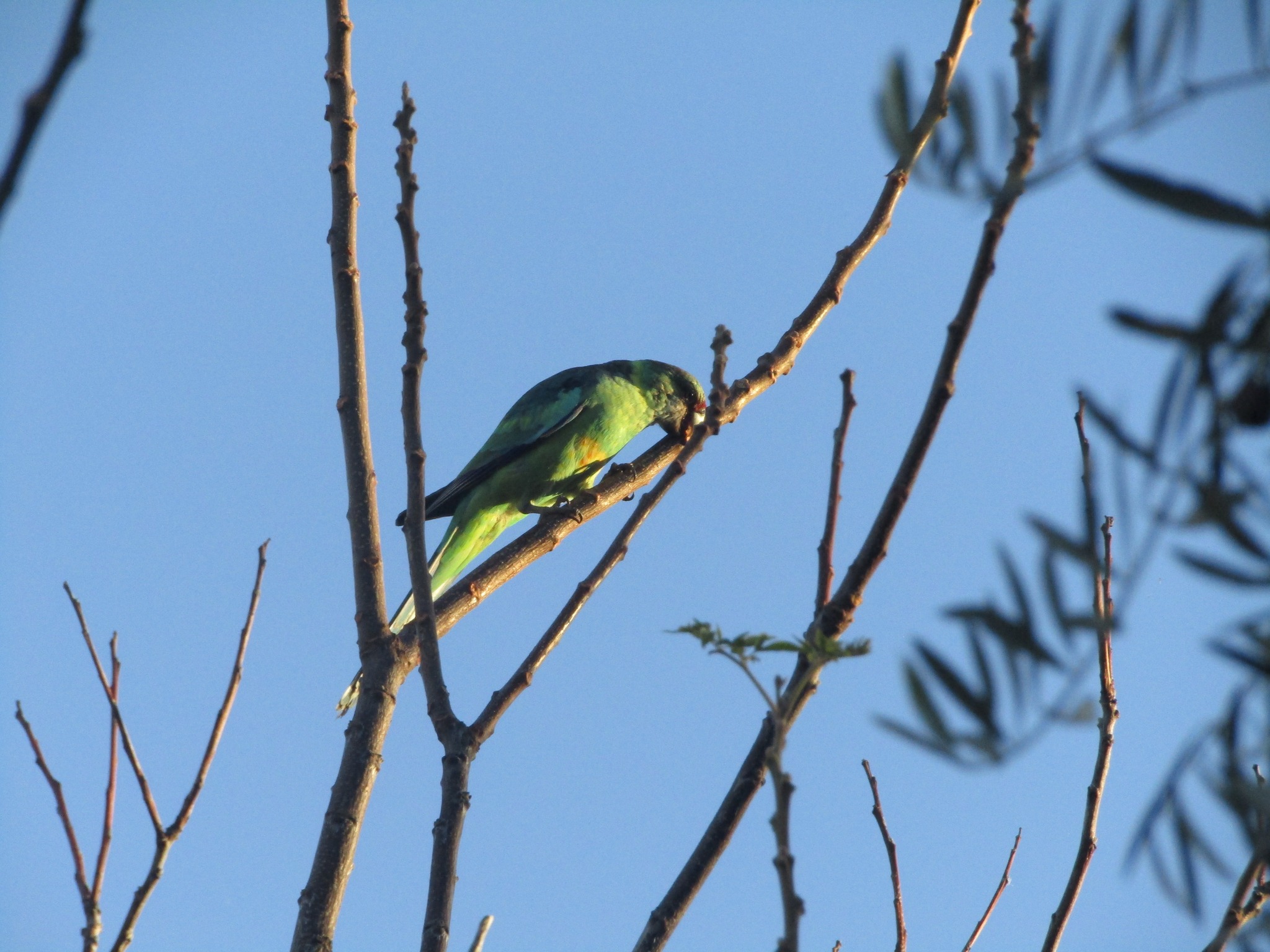
''I Interrupted this Mallee Ringneck Parrot from eating my olives, and she is not happy. All Types of Parrots are here at Gunnedah eating my Olives.'' - Ken Sava Lloyd, June 3, 2023
The Australian ringneck (Barnardius zonarius) is a parrot native to Australia. Except for extreme tropical and highland areas, the species has adapted to all conditions. Treatments of genus Barnardius have previously recognised two species, the Port Lincoln parrot (Barnardius zonarius) and the mallee ringneck (Barnardius barnardi) but due to these readily interbreeding at the contact zone they are usually regarded as a single species B. zonarius with subspecific descriptions. Currently, four subspecies are recognised, each with a distinct range. The Mallee Ringneck Parrot inhabits central and western New South Wales west of Dubbo, the southwestern corner Queensland west of St George, eastern South Australia and northwestern Victoria.
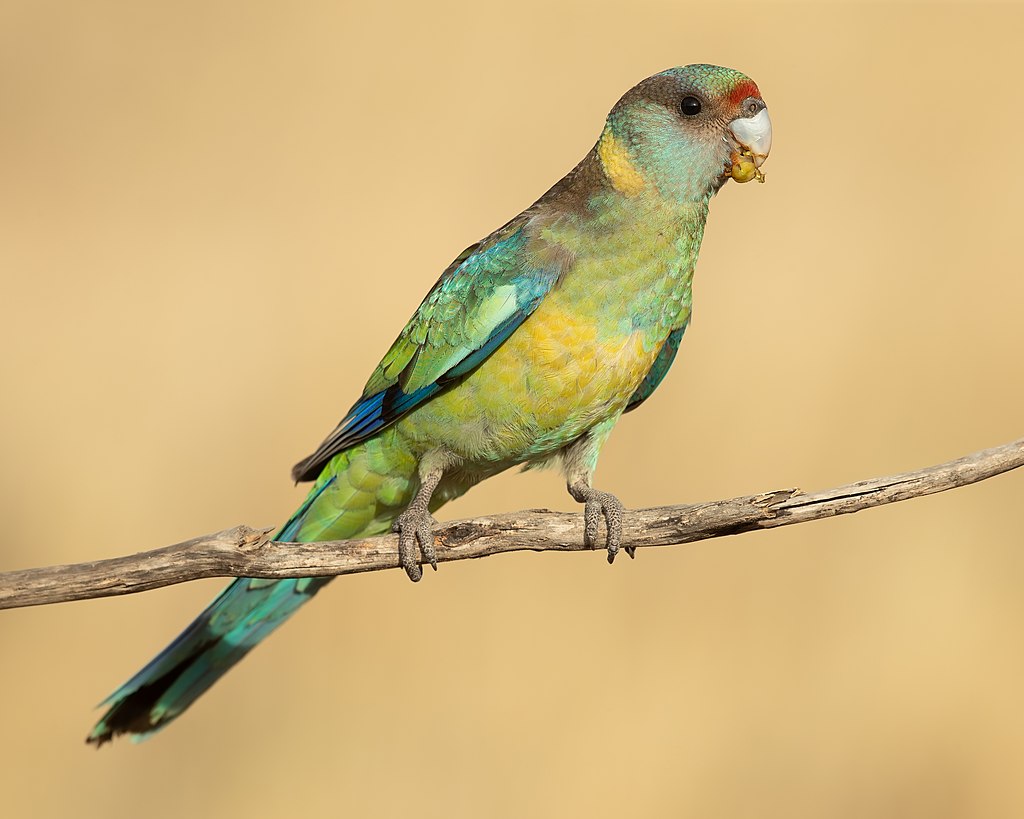
Mallee ringneck (Barnardius zonarius barnardi), Patchewollock Conservation Reserve, Victoria, Australia. Photo: JJ Harrison
The May 2023 round of the Ringtail Posse saw Nicole Romain, Founder Save The Northern Beaches Bushlands (Lizard Rock), choose the Yellow-Tailed Black Cockatoos Calyptorhynchus funereus as her favourite local wildlife species.
Yellow-tailed Black-Cockatoos were once content to feed on the seeds of native shrubs and trees, especially banksias, hakeas and casuarinas, as well as extracting the insect larvae that bore into the branches of wattles. Now, after the establishment of extensive plantations of exotic Monterey Pines, the cockatoos may feed more often by tearing open pine cones to extract the seeds in states further south where their preferred habitat and food trees have been destroyed. The population on South Australia’s Eyre Peninsula is now reliant on the seeds of the Aleppo Pine, a noxious weed, as its preferred habitat, as its Sugar Gum woodlands has become extensively fragmented.
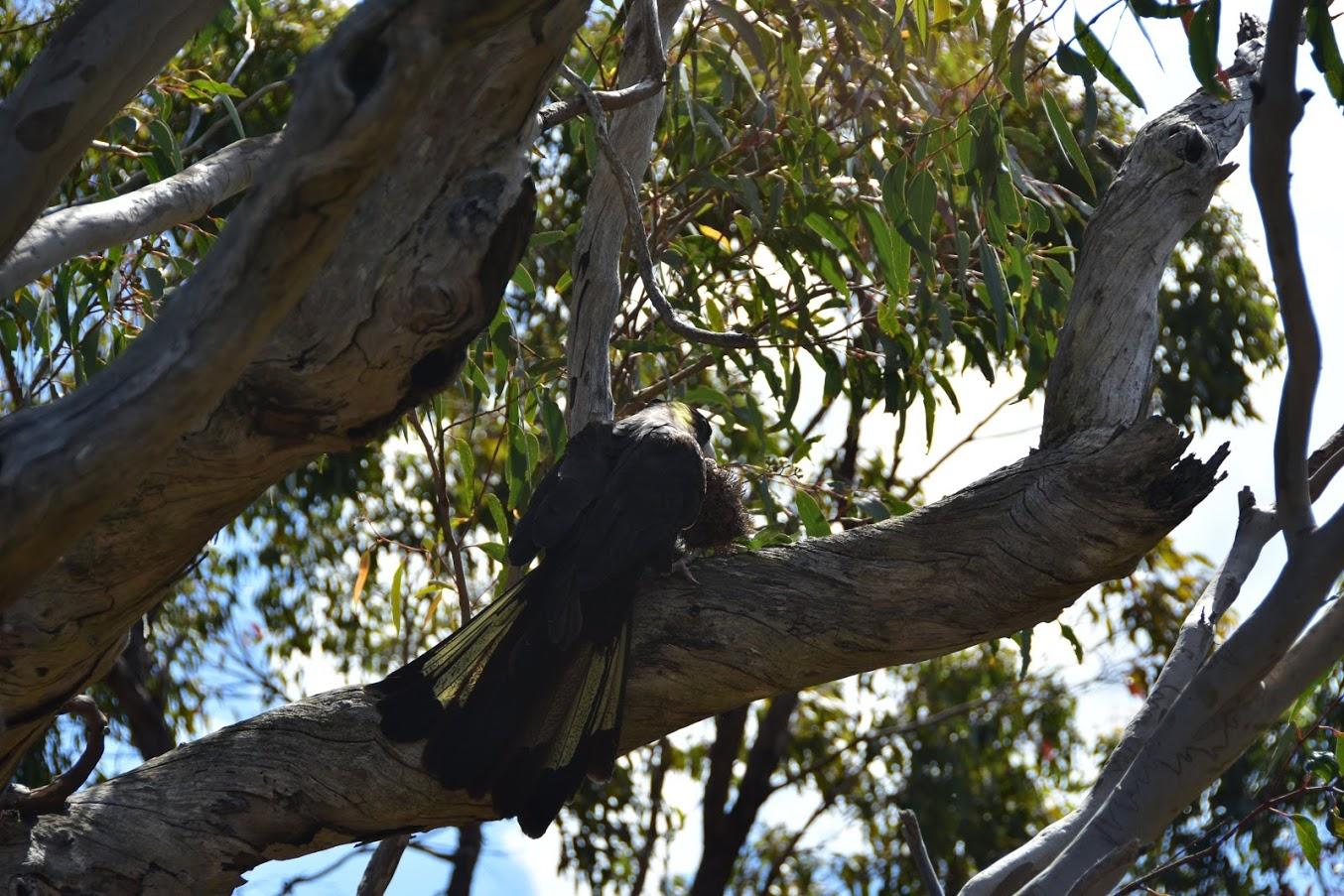
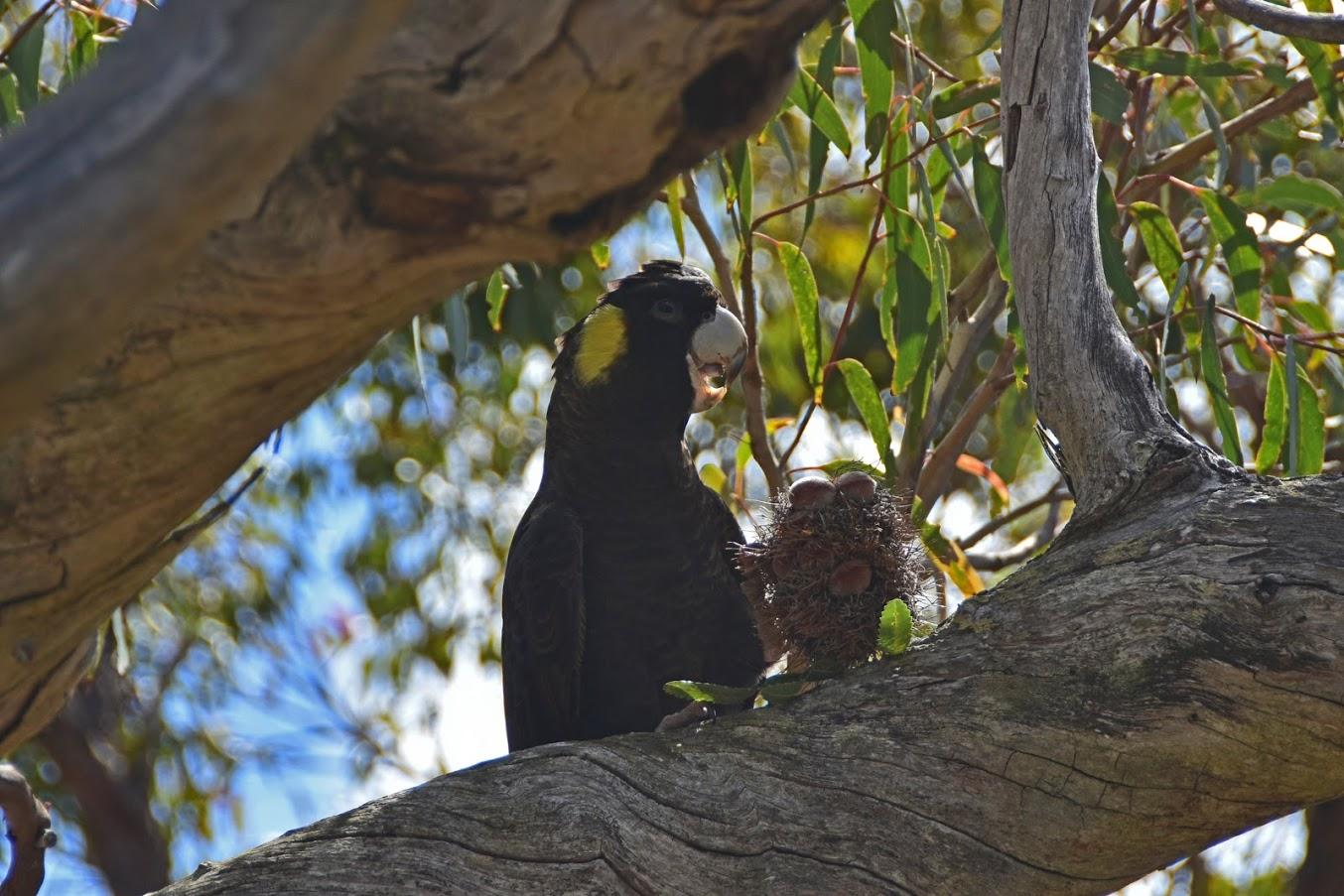
Yellow-tailed black cockatoos are one of two species of black cockatoos found in NSW. The other is the much less common south-eastern glossy black cockatoo, a species in decline, particularly after losing crucial habitat during the severe bushfires of 2019/2020, and listed as vulnerable nationally in August 2022.
The south-eastern glossy black cockatoo is a specialist eater and feeds on she oaks, which is why we will sometimes see them in Pittwater and why we need to stop cutting down their food; the trees.
Glossy Black-cockatoo, Calyptohynchus lathami, at Clareville - photo by Paul Wheeler, this species also visits McKay Reserve, Palm Beach, annually to feed on these trees
Areas Closed For West Head Lookout Upgrades
 NPWS advise that the following areas are closed from Monday 22 May to Thursday 30 November 2023 while West Head lookout upgrades are underway:
NPWS advise that the following areas are closed from Monday 22 May to Thursday 30 November 2023 while West Head lookout upgrades are underway:
- West Head lookout
- The loop section of West Head Road
- West Head Army track.
Vehicles, cyclists and pedestrians will have access to the Resolute picnic area and public toilets. Access is restricted past this point.
The following walking tracks remain open:
- Red Hands track
- Aboriginal Heritage track
- Resolute track, including access to Resolute Beach and West Head Beach
- Mackeral Beach track
- Koolewong track.
The West Head lookout cannot be accessed from any of these tracks.
Image: Visualisation of upcoming works, looking east from the ramp towards Barrenjoey Head Credit: DPE
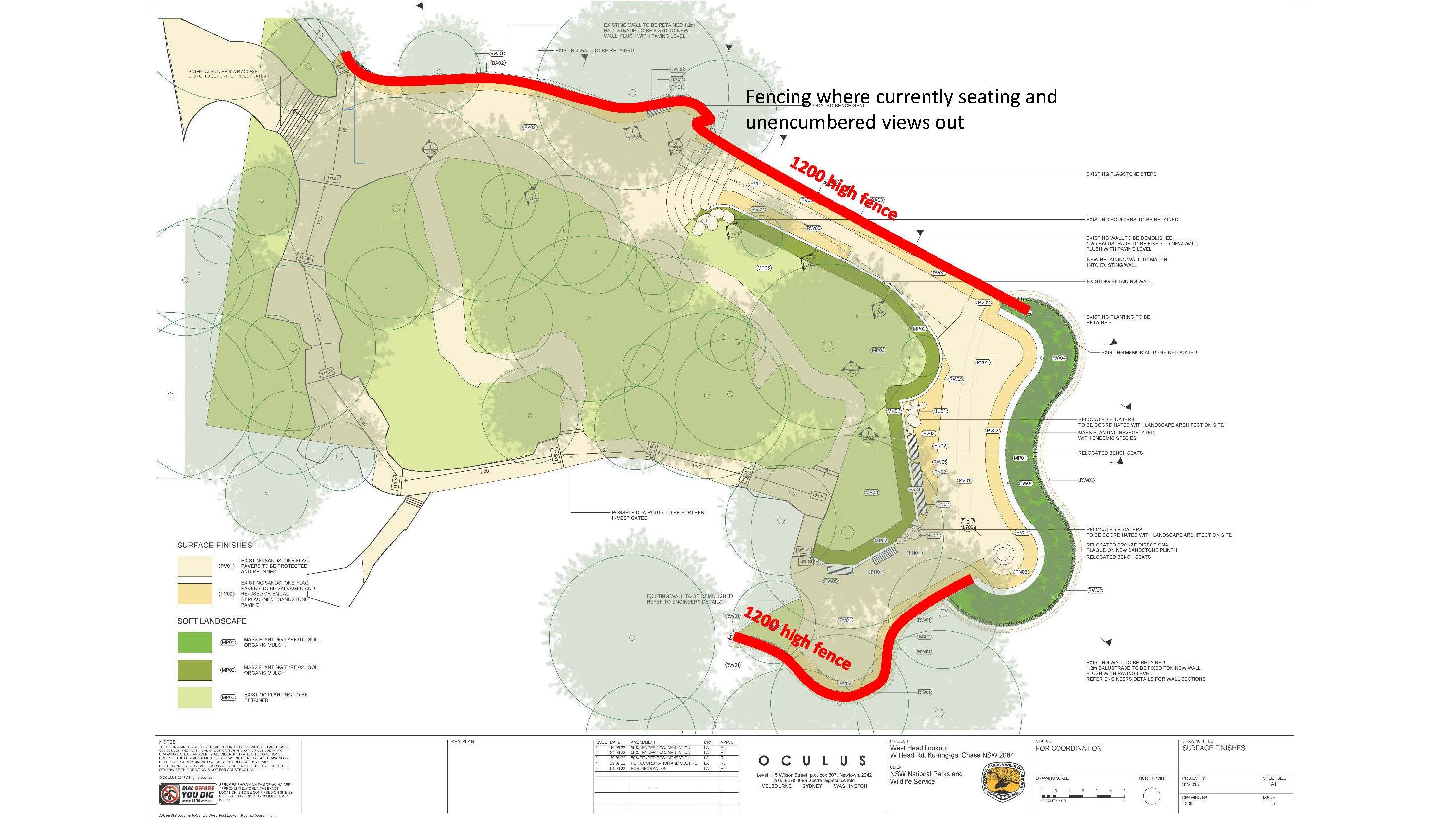
Avalon Dunes Bushcare: July 2023
Join us on Sunday July 2 for another satisfying morning making a difference while being in nature.
We meet on the first Sunday of each month at 8.30am
Facebook page for Avalon Dunes Bushcare where you can keep up to date with progress and find out how to get involved.
Visit: www.facebook.com/AvalonDunesBushcare
Photo: Salt tolerant tree Coast Banksia is in flower now. Unlike most Banksias, it sheds its seeds every summer, not relying on fire to open its seed capsules.
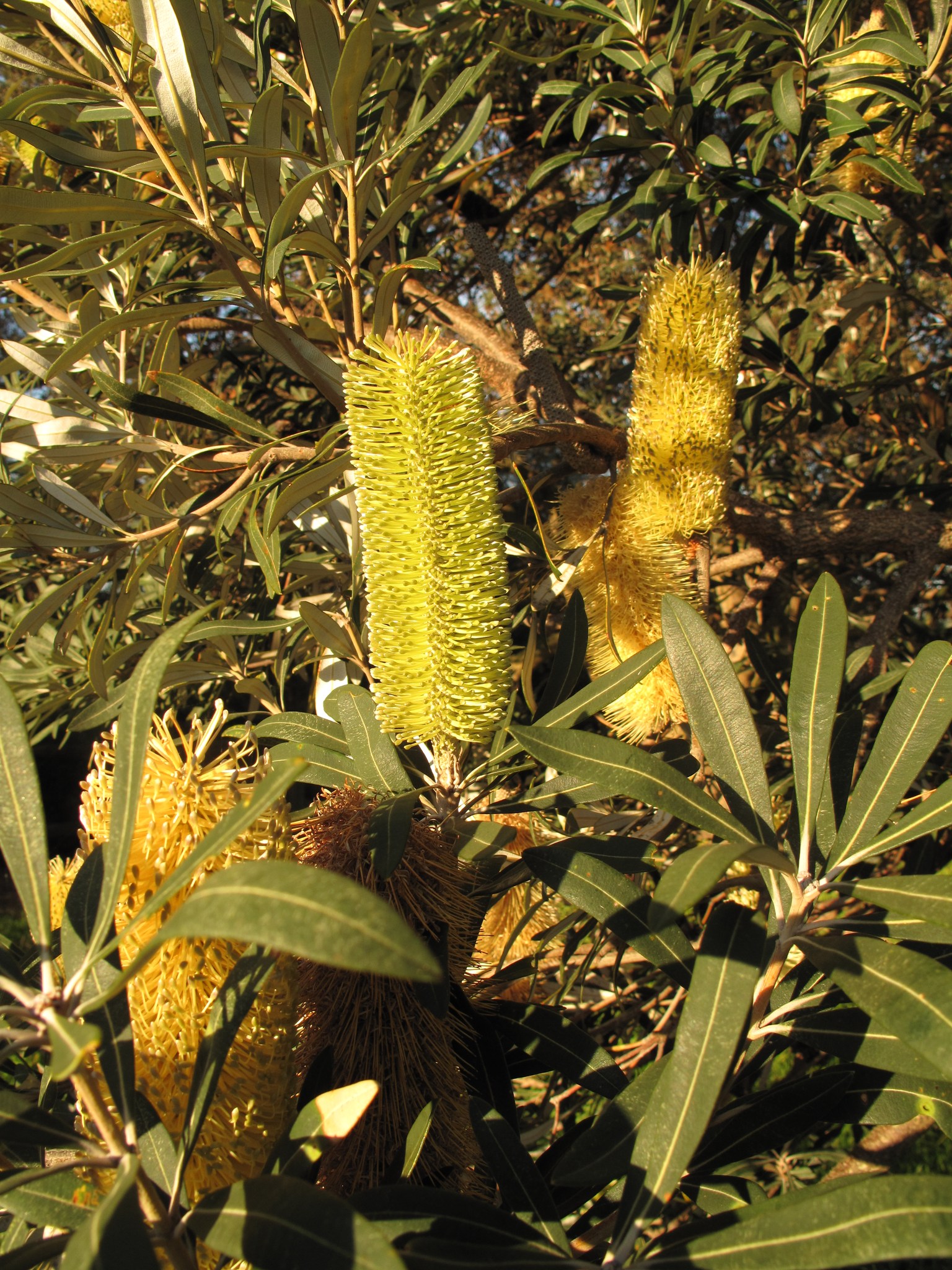
Time Of Burrugin
Cold and frosty; June-July
Echidna seeking mates - Burringoa flowering - Shellfish forbidden
This is the time when the male Burrugin (echidnas) form lines of up to ten as they follow the female through the woodlands in an effort to wear her down and mate with her. It is also the time when the Burringoa (Eucalyptus tereticornis) starts to produce flowers, indicating that it is time to collect the nectar of certain plants for the ceremonies which will begin to take place during the next season. It is also a warning not to eat shellfish again until the Boo'kerrikin (Acacia decurrens, commonly known as black wattle or early green wattle) blooms.
Eucalyptus tereticornis, commonly known as forest red gum, blue gum or red irongum, is a species of tree that is native to eastern Australia and southern New Guinea. It has smooth bark, lance-shaped to curved adult leaves, flower buds in groups of seven, nine or eleven, white flowers and hemispherical fruit.
Eucalyptus tereticornis was first formally described 1795 by James Edward Smith in A Specimen of the Botany of New Holland from specimens collected in 1793 from Port Jackson by First Fleet surgeon and naturalist John White. The specific epithet (tereticornis) is from the Latin words teres (becoming tereti- in the combined form) meaning "terete" and cornu meaning "horn", in reference to the horn-shaped operculum.
Habitat tree: Sclerophyll Forest.
Food tree: Natural stands are an important food tree for koalas and a wide variety of nectar-eating birds, fruit bats and possums.
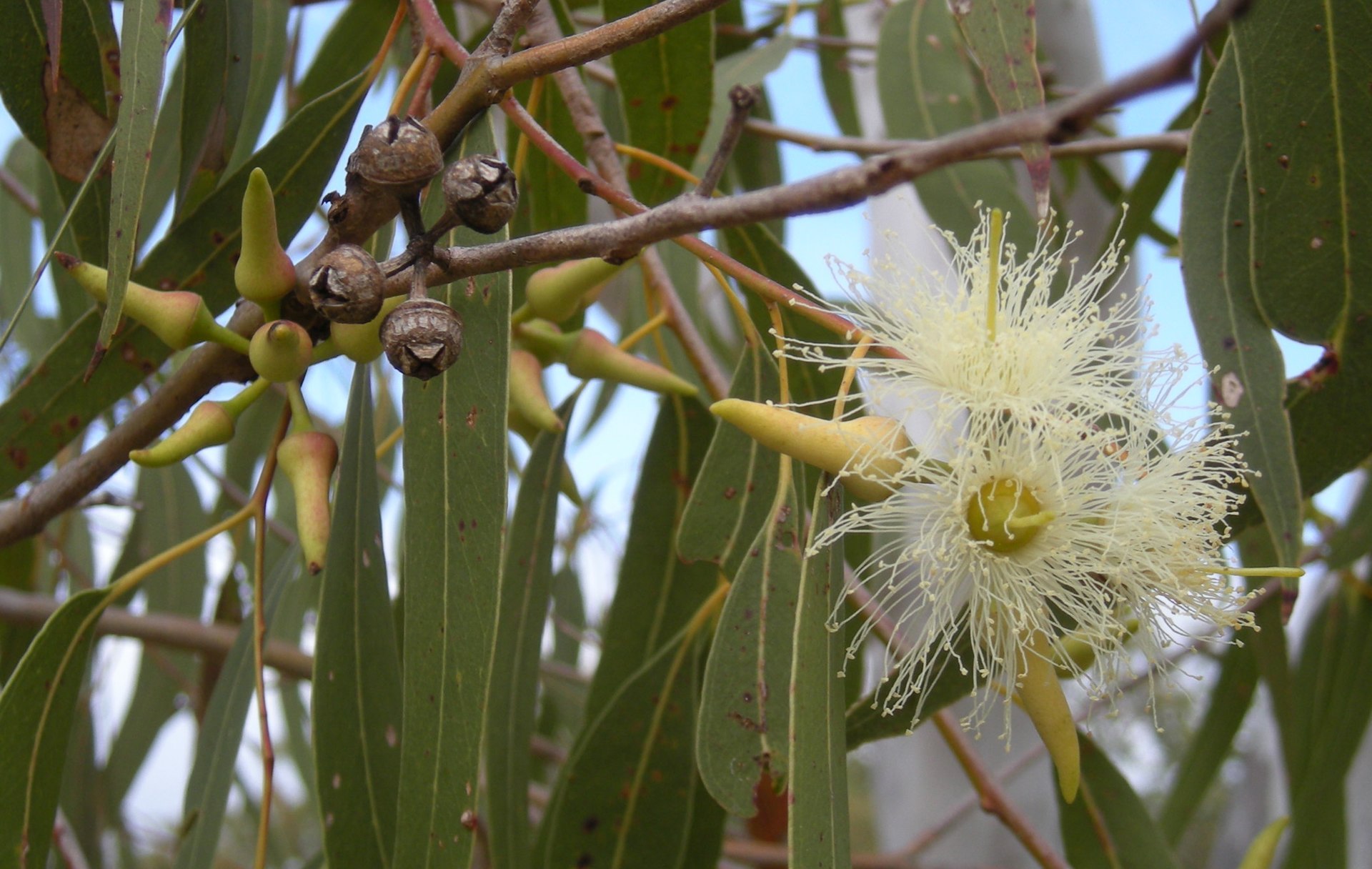
Eucalyptus tereticornis buds, capsules, flowers and foliage, Rockhampton, Queensland. Photo: Ethel Aardvark
Shelly Beach Echidna
Photos by Kevin Murray, taken late May 2023 who said, ''he/she was waddling across the road on the Shelly Beach headland, being harassed not so much by the bemused tourists, but by the Brush Turkeys who are plentiful there.''
Shelly Beach is located in Manly and forms part of Cabbage Tree Bay, a protected marine reserve which lies adjacent to North Head and Fairy Bower.
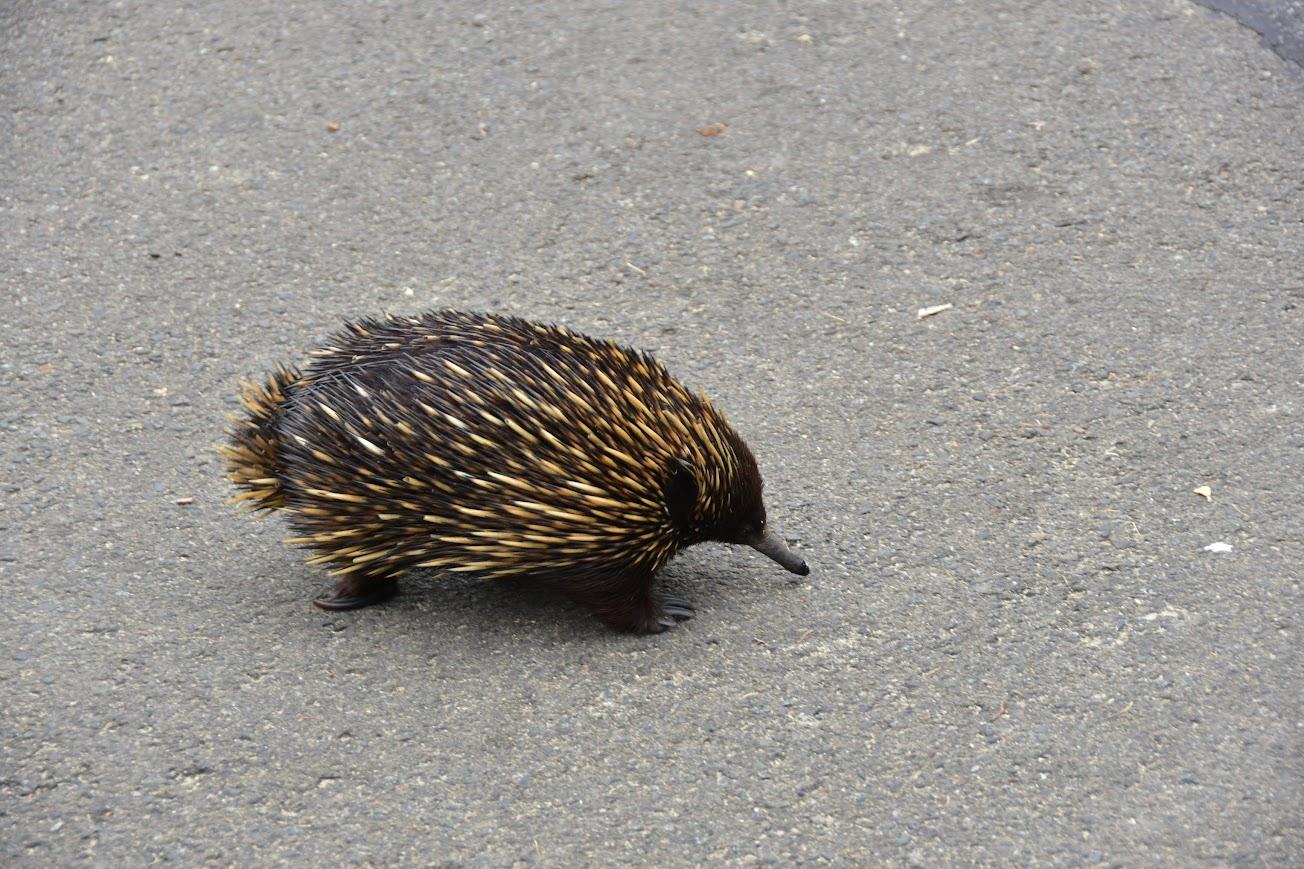
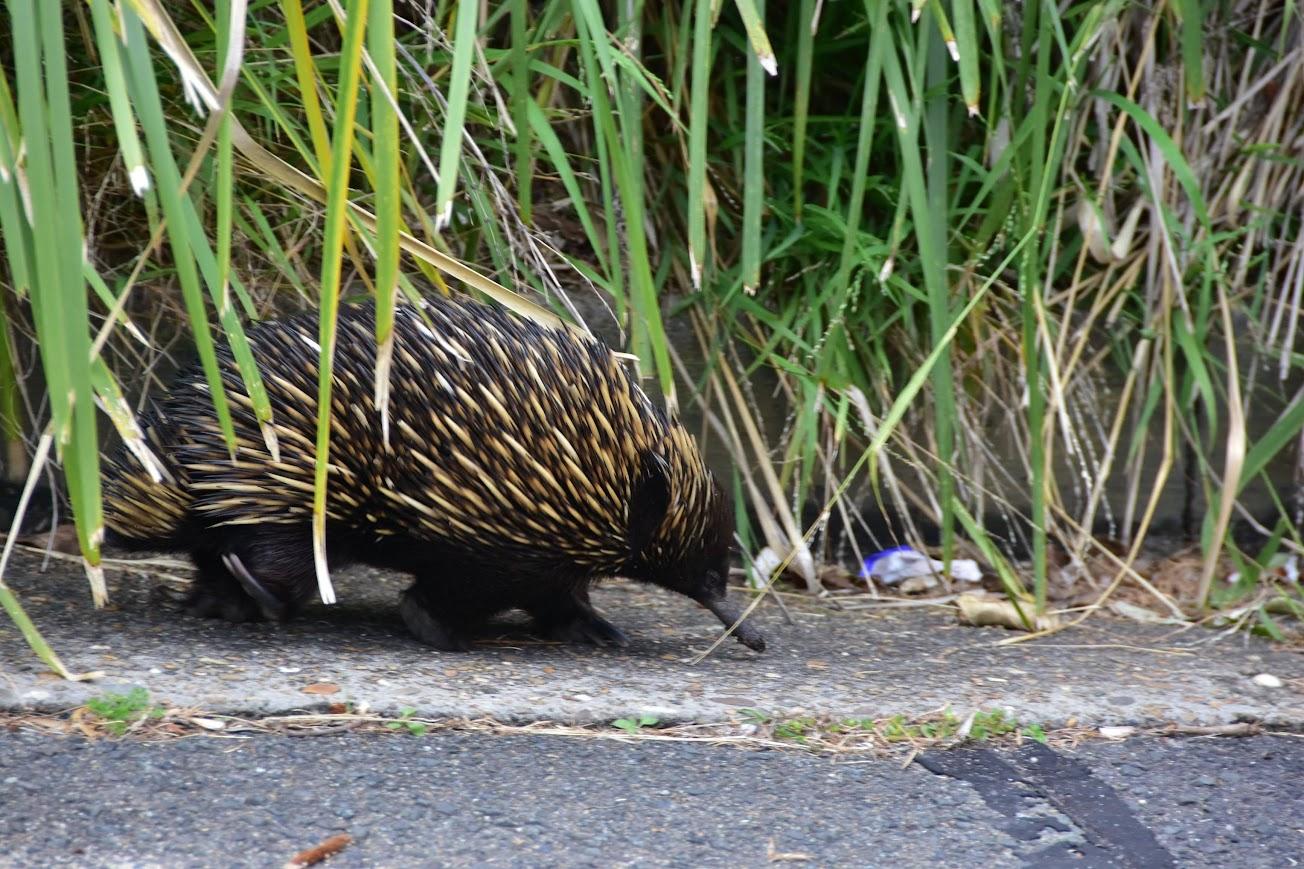
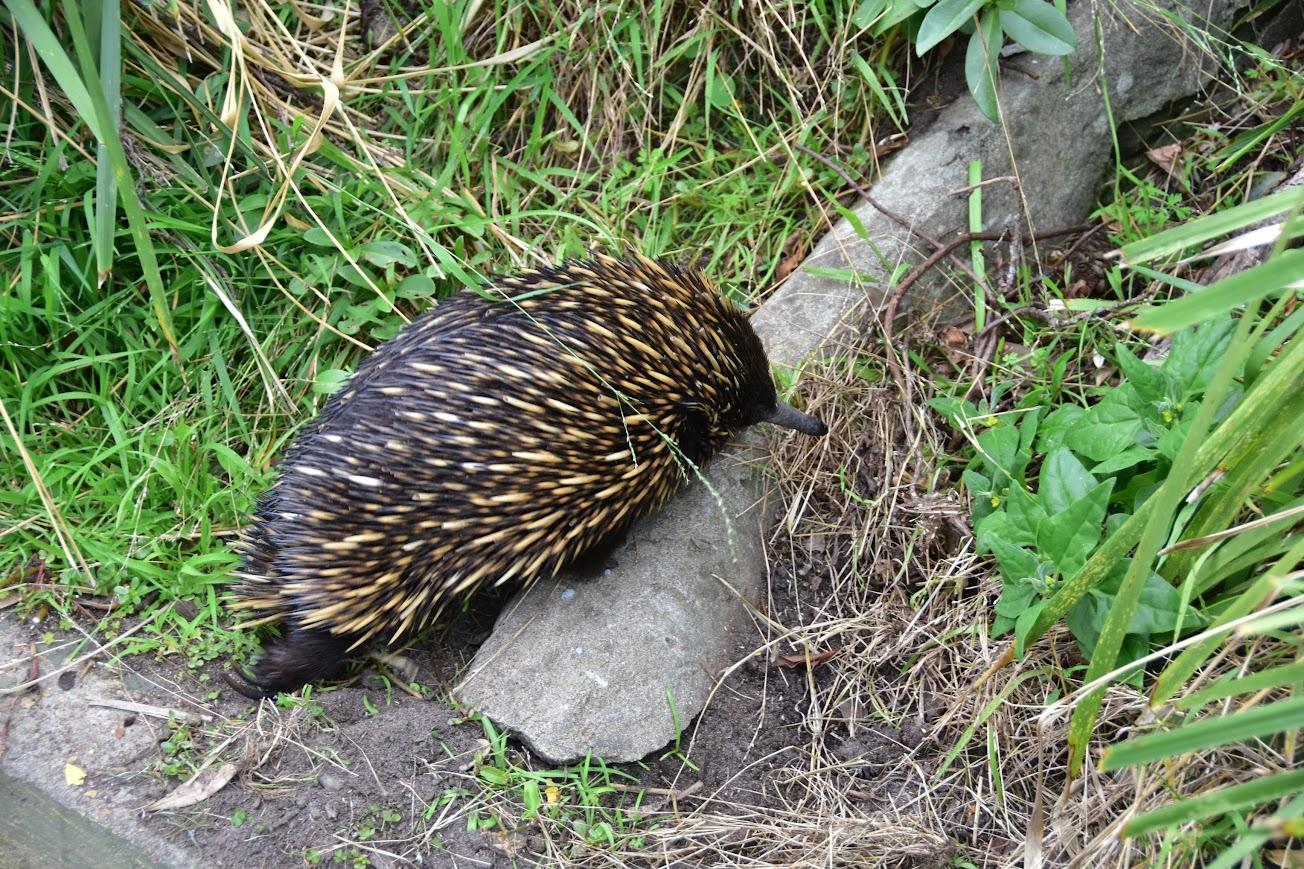
From the D'harawal calendar, BOM
D'harawal
The D'harawal Country and language area extends from the southern shores of Port Jackson (Sydney Harbour) to the northern shores of the Shoalhaven River, and from the eastern shores of the Wollondilly River system to the eastern seaboard.
Protect Mona Vale's Bongin Bongin Bay - Establish An Aquatic Reserve



Northern Beaches Clean Up Crew: June 25 Winnererremy Bay, Mona Vale
Come and join us for our family friendly June clean up, in Winnererremy Bay on the Sunday June 25th at 10am. We meet in the grass area close to 7 Eric Green Drive. We have gloves, bags, and buckets, and grabbers. We're trying to remove as much plastic and rubbish as possible before it enters the water. Some of us can focus on the bush area and sandy/rocky areas, and others can walk along the water and even clean up in the water (at own risk).
We will clean up until around 11.15, and after that, we will sort and count the rubbish so we can contribute to research by entering it into a marine debris database. The sorting and counting is normally finished around noon, and we'll often go for lunch together at our own expense. We understand if you cannot stay for this part, but are grateful if you can. We appreciate any help we can get, no matter how small or big.
No booking required - just show up on the day - we will be there no matter what weather. We're a friendly group of people, and everyone is welcome to this family friendly event. It's a nice community - make some new friends and do a good deed for the planet at the same time. For everyone to feel welcome, please leave political and religious messages at home - this includes t-shirts with political campaign messages. Message us on our social media or send us an email if you are lost.
All welcome - the more the merrier. Please invite your friends too!
All details in our Facebook event or on our website.
Northern Beaches Clean Up Crew Facebook page: www.facebook.com/NorthernBeachesCleanUpCrew
Northern Beaches Clean Up Crew website: www.northernbeachescleanupcrew.com

Freshwater Beach And Surrounds Clean Up
Done on Sunday May 28 2023
A huge thank you to everyone and cleaned up Freshwater Beach today. More than 100 people came and we are so happy and grateful to everyone who cares and helps making our beaches and local environment a better and cleaner place for all beings.
We had thousands of Styrofoam balls, about 30 single use coffee cups, nearly 90 plastic bottles, 164 glass bottles, 146 aluminium cans, 11 kilos of cardboard/paper, several surf boards, 127 cigarette butts, 3 broken plastic chairs, thousands of pieces of soft plastic and 22 balls among many of the items that we picked up.
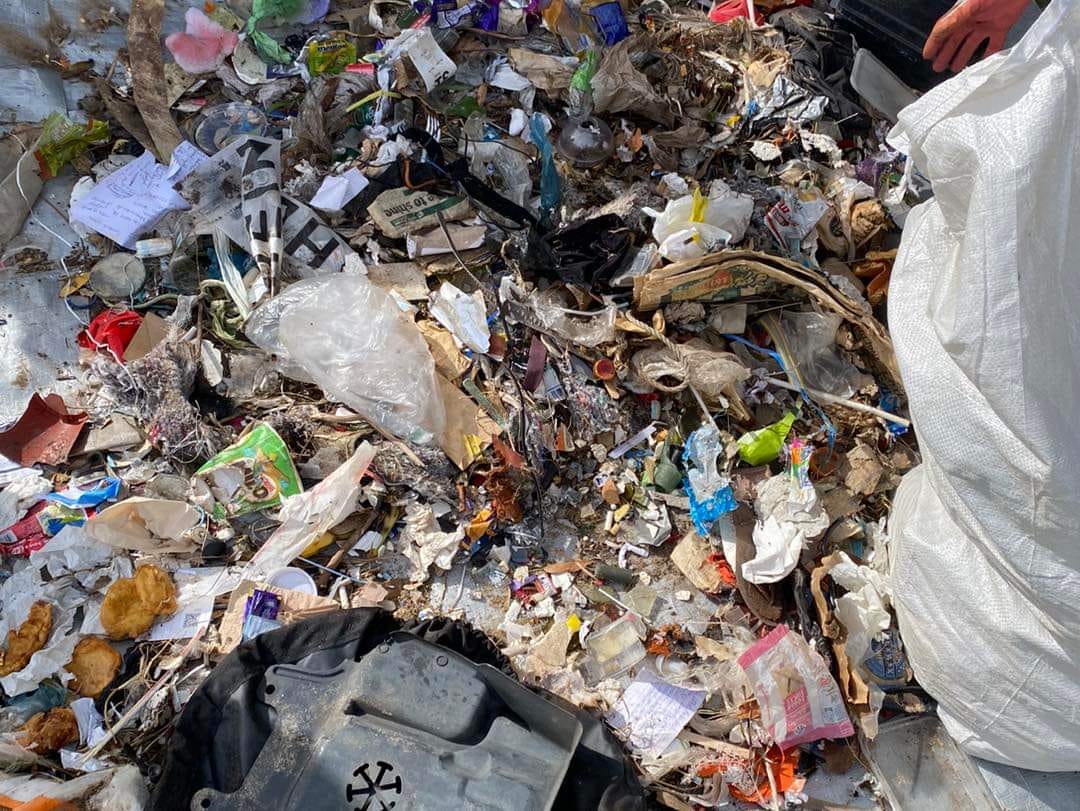
PNHA Guided Nature Walks 2023
Our walks are gentle strolls, enjoying and learning about the bush rather than aiming for destinations. Wear enclosed shoes. We welcome interested children over about 8 years old with carers. All Welcome.
Sunday June 25: Birdwatching and Bushland along Mullet Creek in Ingleside Chase Reserve
Swamp forest and coastal wetlands are rich habitat for fauna such as Swamp Wallaby and Diamond Python. Over 150 bird species have been recorded for the area. Red-Browed Finch is one.
Bring your binoculars and keep your ears pricked for bird calls. The track is mostly level, but with an optional steep climb near the Irrawong waterfall.
Meet: 8.30am near 31 Irrawong Rd North Narrabeen. Ends about 10.30.
So we know you’re coming please book by emailing: pnhainfo@gmail.com and include your phone number so we can contact you if weather is doubtful.
The whole PNHA 2023 Guided Nature Walks Program is available at: http://pnha.org.au/test-walks-and-talks/
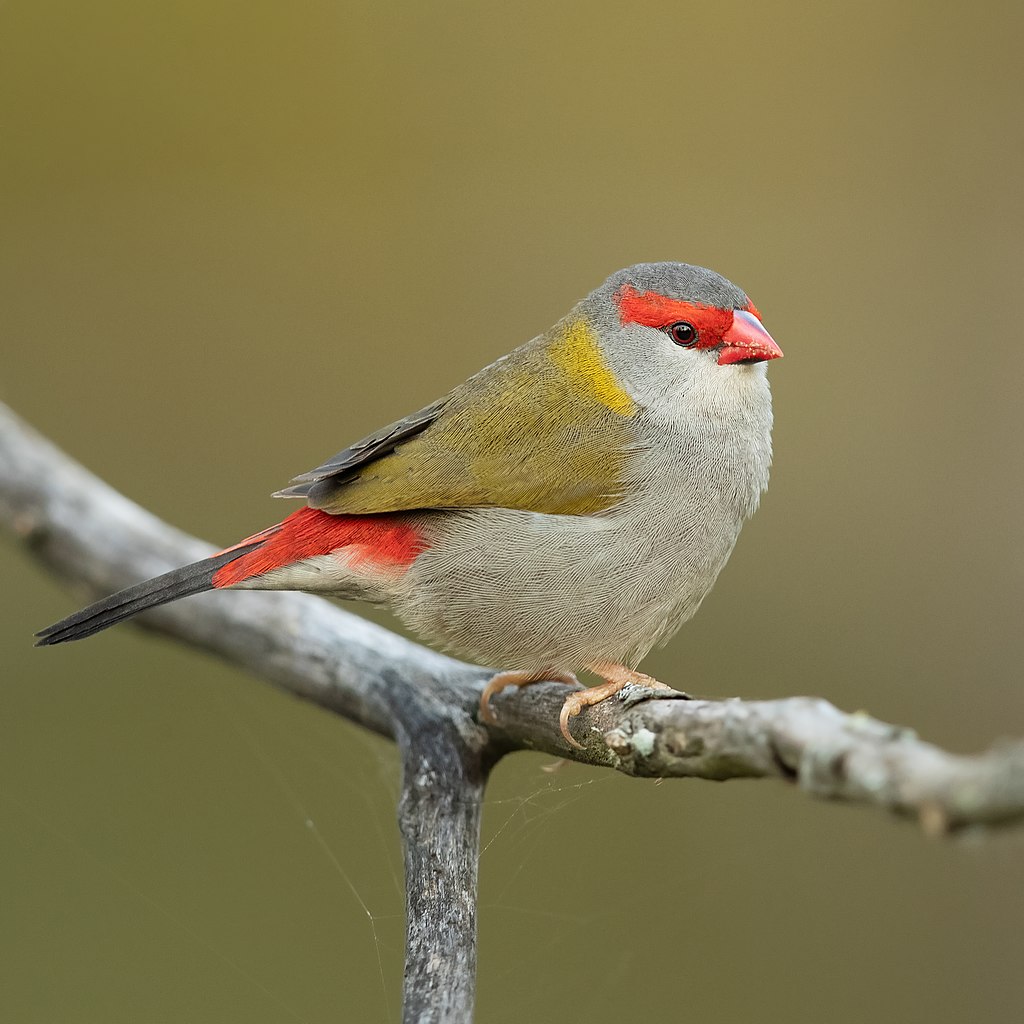
Red-browed finch (Neochmia temporalis). Photo: J J Harrison
Chemical CleanOut: June 2023
Mona Vale Beach Car Park: Sat 24, Sun 25 June 2023 - 9am-3:30pm
Surfview Road, Mona Vale
Only household quantities accepted. Maximum container size of 20kg or 20L per item.
*Up to 100L of paint (in 20L containers) now accepted at all Sydney, Hunter and Illawarra events.
Accepted:
Fluoro globes and tubes, Gas bottles and fire extinguishers, Household cleaners, Batteries, Paint*, Oils, Garden chemicals, Poisons, Smoke detectors.
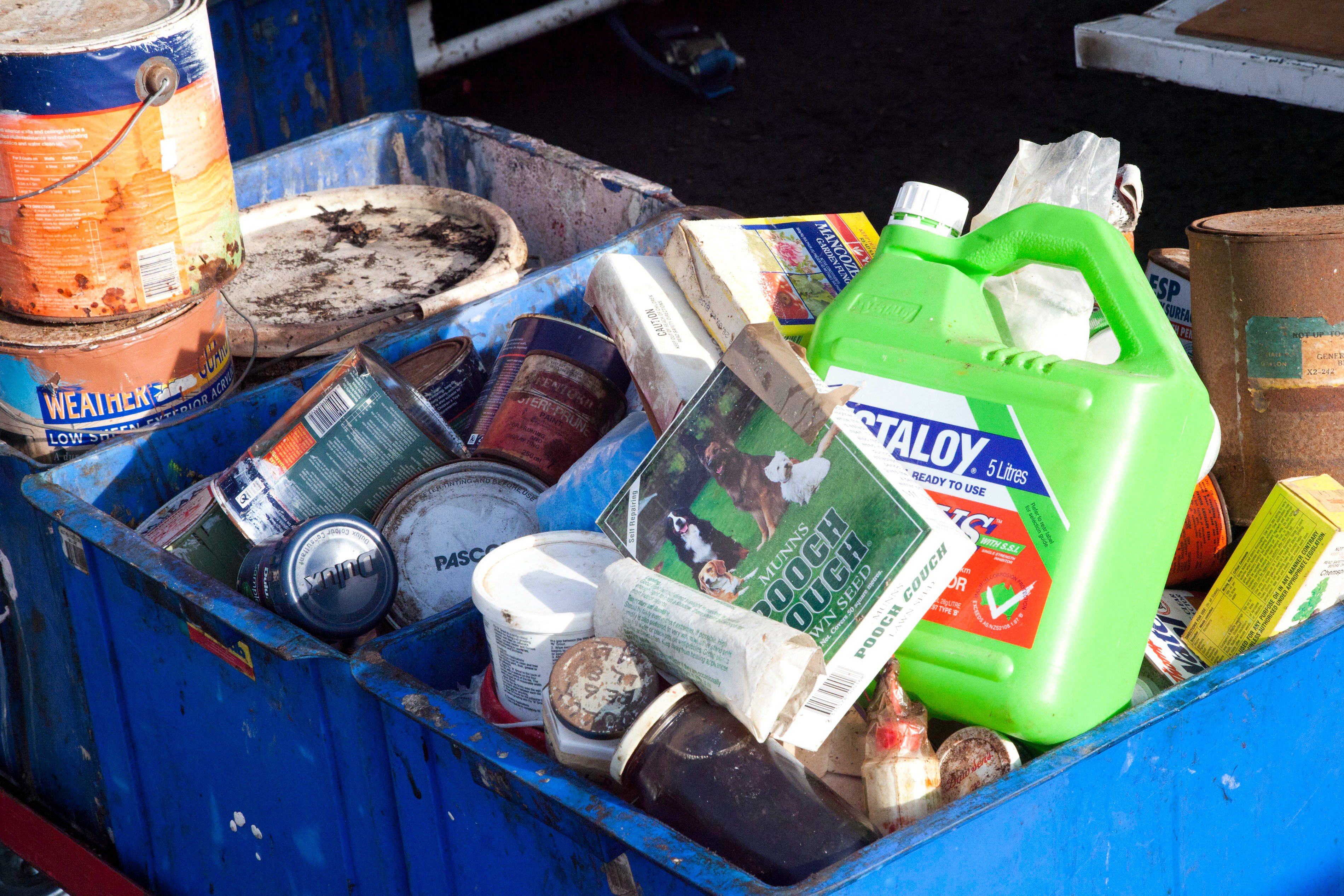
Permaculture NB: June To July 2023 Events
Permaculture Northern Beaches (PNB) is an active local group on Sydney's Northern Beaches working for ecological integrity and assisting you on a pathway to sustainability.
PNB holds monthly permaculture-related public meetings on the last Thursday of each month at the Narrabeen Tramshed Community & Arts Centre, Lakeview Room, 1395A Pittwater Road, Narrabeen. Buses stop directly at the centre and there is also car parking nearby. Doors open at 7:15 pm and meetings take place monthly from February to November.
Everyone is welcome!
We also hold a range of workshops, short courses, film and soup nights, practical garden tours, permabees (working bees), beehive installations, eco-product making sessions and much more.
CELEBRATING WORLD OCEANS DAY
Thursday, June 29, 2023: 7:30pm – 9:00pm
Narrabeen Tramshed Arts and Community Centre, Lakeview Room
1395A Pittwater Road, Narrabeen
Join us in World Oceans’ month to learn more about the Blue planet we live on.
Two great speakers will tell us the wonders and threats facing our oceans.
Australia Marine Conservation Society works on the big issues that risk our ocean wildlife - protecting critical ocean ecosystems with marine reserves around the nation, including Ningaloo and the Great Barrier Reef. As well as issues such as over-fishing and supertrawlers, and protecting threatened and endangered species like the Australian Sea Lion.
Surfrider Foundation is actively working to stop drilling and exploration for oil and gas off our coast (PEP2). The organisation works to protect our oceans, beaches and waves through a powerful activist network.
$5 entry by donation to pay for room hire. Organic teas and coffee are available at the night + swap table - bring plants, seeds, food, books and permaculture items to swap and share.

SEED SAVING CIRCLE
Saturday, July 8, 2023: 11:00am – 1:00pm
Balgowlah Community Garden
100 Griffiths Street, Balgowlah
Gather your seeds in winter for the coming spring. Share and swap seeds that are grown organically and locally. These seeds will be the best adapted you can find for the Northern Beaches climate and soils as many have been grown over generations.
Tap into the knowledge and the databank of seeds at Balgowlah Community Garden and PNB + share permaculture knowledge. This is an invaluable resource for the local community. Be part of the change - grow your own seeds and food.
Bring your non-alcoholic drinks and food to share on the day. The seed circle will be outdoors but under cover so dress weather-wise.
PLASTIC FREE JULY
Saturday, July 1, 2023 – Monday, July 31, 2023
Permaculture Northern Beaches is a part of the Plastic Free July challenge - Join Us!
The plastic bottles, bags and takeaway containers that we use for just a few minutes use a material that is designed to last forever. Every bit of plastic ever made still exists!
These plastics:
- Break up, not break down – becoming permanent pollution
- Are mostly made into low-grade products for just one more use or sent to a landfill
- End up in waterways and the ocean – where scientists predict there will be more tons of plastic than tons of fish by 2050
- Transfer to the food chain – carrying pollutants with them
- Increase our eco-footprint – plastic manufacturing consumes 6% of the world’s fossil fuels
Be part of the solution, by taking up these habits:
- Refusing plastic bags and packaging (choose your own alternatives)
- Reducing packaging where possible (opt for refills, remember your reusable shopping bags)
- Refusing plastics that escape as litter (e.g. straws, takeaway cups, utensils, balloons)
- Recycling what cannot be avoided by the use of alternatives.
Register to join 100,000 Australians and a million+ people worldwide stepping up in Plastic Free July www.plasticfreejuly.org
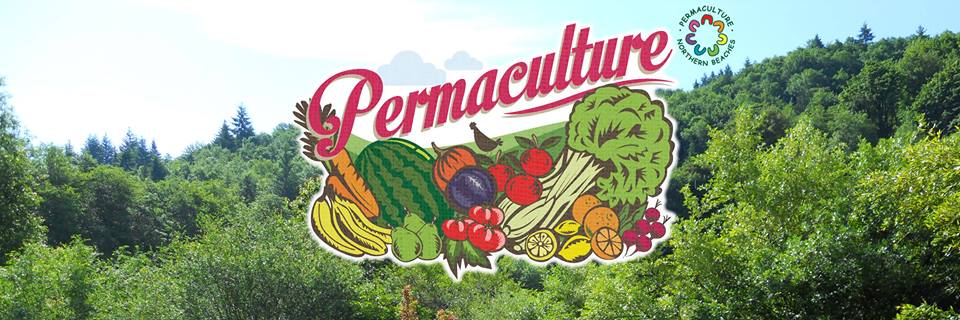
Bushcare In Pittwater
Where we work Which day What time
Avalon
Angophora Reserve 3rd Sunday 8:30 - 11:30am
Avalon Dunes 1st Sunday 8:30 - 11:30am
Avalon Golf Course 2nd Wednesday 3 - 5:30pm
Careel Creek 4th Saturday 8:30 - 11:30am
Toongari Reserve 3rd Saturday 9 - 12noon (8 - 11am in summer)
Bangalley Headland 2nd Sunday 9 to 12noon
Bayview
Winnererremy Bay 4th Sunday 9 to 12noon
Bilgola
North Bilgola Beach 3rd Monday 9 - 12noon
Algona Reserve 1st Saturday 9 - 12noon
Plateau Park 1st Friday 8:30 - 11:30am
Church Point
Browns Bay Reserve 1st Tuesday 9 - 12noon
McCarrs Creek Reserve Contact Bushcare Officer To be confirmed
Clareville
Old Wharf Reserve 3rd Saturday 8 - 11am
Elanora
Kundibah Reserve 4th Sunday 8:30 - 11:30am
 Mona Vale
Mona Vale Mona Vale Beach Basin 1st Saturday 8 - 11am
Mona Vale Dunes 2nd Saturday +3rd Thursday 8:30 - 11:30am
Newport
Bungan Beach 4th Sunday 9 - 12noon
Crescent Reserve 3rd Sunday 9 - 12noon
North Newport Beach 4th Saturday 8:30 - 11:30am
Porter Reserve 2nd Saturday 8 - 11am
North Narrabeen
Irrawong Reserve 2nd Saturday 2 - 5pm
Palm Beach
North Palm Beach Dunes 3rd Saturday 9 - 12noon
Scotland Island
Catherine Park 2nd Sunday 10 - 12:30pm
Elizabeth Park 1st Saturday 9 - 12noon
Pathilda Reserve 3rd Saturday 9 - 12noon
Warriewood
Warriewood Wetlands 1st Sunday 8:30 - 11:30am
Whale Beach
Norma Park 1st Friday 9 - 12noon
Western Foreshores
Coopers Point, Elvina Bay 2nd Sunday 10 - 1pm
Rocky Point, Elvina Bay 1st Monday 9 - 12noon
Friends Of Narrabeen Lagoon Catchment Activities

Gardens And Environment Groups And Organisations In Pittwater
Report Fox Sightings
%20(1).jpg?timestamp=1675893929686)
New Marine Wildlife Rescue Group On The Central Coast
A new wildlife group was launched on the Central Coast on Saturday, December 10, 2022.
Marine Wildlife Rescue Central Coast (MWRCC) had its official launch at The Entrance Boat Shed at 10am.
The group comprises current and former members of ASTR, ORRCA, Sea Shepherd, Greenpeace, WIRES and Wildlife ARC, as well as vets, academics, and people from all walks of life.
Well known marine wildlife advocate and activist Cathy Gilmore is spearheading the organisation.
“We believe that it is time the Central Coast looked after its own marine wildlife, and not be under the control or directed by groups that aren’t based locally,” Gilmore said.
“We have the local knowledge and are set up to respond and help injured animals more quickly.
“This also means that donations and money fundraised will go directly into helping our local marine creatures, and not get tied up elsewhere in the state.”
The organisation plans to have rehabilitation facilities and rescue kits placed in strategic locations around the region.
MWRCC will also be in touch with Indigenous groups to learn the traditional importance of the local marine environment and its inhabitants.
“We want to work with these groups and share knowledge between us,” Gilmore said.
“This is an opportunity to help save and protect our local marine wildlife, so if you have passion and commitment, then you are more than welcome to join us.”
Marine Wildlife Rescue Central Coast has a Facebook page where you may contact members. Visit: https://www.facebook.com/profile.php?id=100076317431064
- Ph: 0478 439 965
- Email: marinewildlifecc@gmail.com
- Instagram: marinewildliferescuecc

Watch Out - Shorebirds About
.JPG.opt1460x973o0,0s1460x973.jpg?timestamp=1663629195339)
Possums In Your Roof?: Do The Right Thing

Aviaries + Possum Release Sites Needed

97% of Australians want more action to stop extinctions and 72% want extra spending on the environment

Most Australians (97%) want more action to protect nature, even if they don’t know the full extent of the biodiversity crisis. That’s the startling finding emerging from our first national survey of 4,000 voters.
Biodiversity matters. We rely on nature for healthy food, clean air and water. Roughly half of the global economy depends on natural systems. But Australia is losing biodiversity at a cracking pace. Over the past 200 years, a species has become extinct every second year on average. This includes one in ten of Australia’s mammal species. Thousands of species that were once common and widespread are now rare.
Halting and reversing species loss requires the support of the whole community. So we wanted to find out what Australians think about these issues and the potential solutions.
We found most of the community strongly supports pro-nature policies, such as ending logging of native forests and requiring businesses to report their impacts on nature. We hope the results in our Biodiversity Council report released today will galvanise support for greater conservation action.
Understanding The Biodiversity Crisis
Biodiversity refers to the richness and diversity of plants, animals and other living things in nature. Australia has one of the most unique and diverse natural environments in the world.
However, the state of the Australian environment is declining. The effects of climate change, land clearing, invasive species, pollution and more are causing irreparable damage.
The pace of loss and its consequences are even greater than previously thought. For example, biodiversity loss reduces the availability of clean water and air, and may limit future discoveries of potential treatments for many diseases and health problems. The loss of wild pollinators threatens the production of food crops globally.
This has led the World Economic Forum to declare biodiversity loss as the third most severe threat humanity will face in the next ten years.
As with climate action, the involvement and support of the wider community is essential to tackling the issue and requires people to take personal action. We also need people to back policies that protect and restore biodiversity.
Australians Want Action
In late 2022, we conducted an online survey of more than 4,000 people across Australia. We had a representative sample across age, gender and location, benchmarked against Australian census data. We asked people about their attitudes to nature, how much they participated in “pro-biodiversity” behaviours such as native gardening and sustainable consumption, and how concerned they were about biodiversity loss.
We also explored people’s opinions about the state of the environment, government performance and relevant policies.
Many people were not aware of the full extent of biodiversity loss, with 60% believing that the state of the Australian environment is “good” or “very good”.
Yet the vast majority of people still cared deeply for Australia’s environment. More than eight out of ten people were concerned about biodiversity issues (85%) and said it was important that nature in Australia is looked after (83%). As many as six out of ten (63%) people were “very” or “extremely” concerned.
Encouragingly, almost everyone (97%) wanted more action to conserve biodiversity. More than half wanted “a lot” or “a great deal” more action (58%). This shows that even when awareness is limited, people value nature and recognise the importance of protecting our natural environment.
Most people agreed everyone in Australia has a role to play (68%). More than half already engaged in actions to protect nature, such as being a sustainable consumer and managing pets or gardens for nature.
What About Policy Solutions?
Most of our survey respondents also believe all levels of government are responsible for taking action. Around three-quarters (72%) said more money should be spent on the environment. Only about one in 20 (6%) said less should be spent.
Most Australians were supportive of introducing new policies that could help protect biodiversity. The vast majority of people (80% or higher) support or strongly support:
- restoring water to wetlands and rivers
- increasing fines for people caught smuggling illegal wildlife or products
- restoring nature in cities and towns
- increasing fines for high polluters
- tougher fines and stronger laws to stop illegal habitat destruction and tree clearing.
More than 70% of people also support:
- banning logging in native forests
- introducing laws to prevent domestic cats roaming the streets
- requiring businesses to report their impact on nature
- establishing new protected areas (such as national parks) at places with high biodiversity.
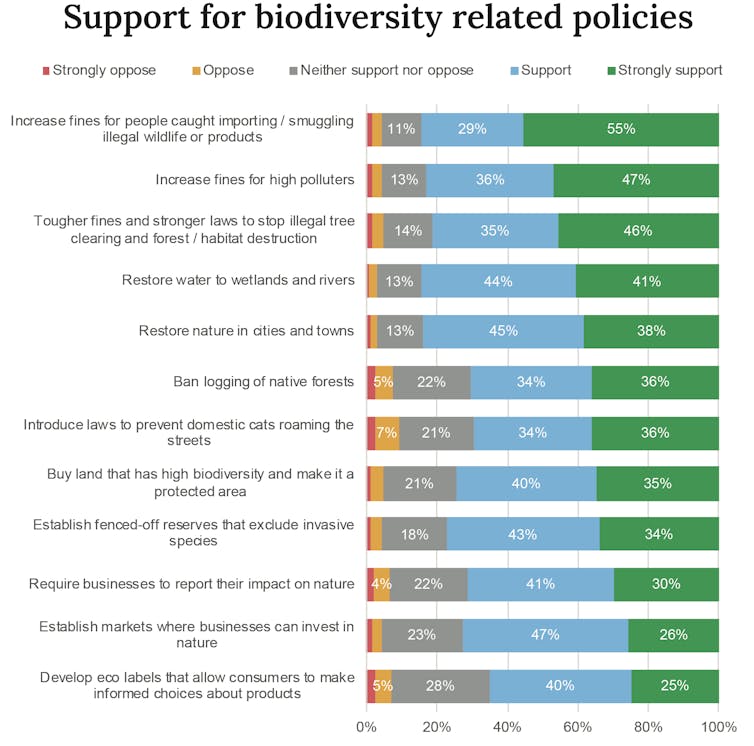
A majority of Australians from all states and territories, political alignments, and regions, and from urban and rural areas supported these policies.
Significantly, very few people opposed these policies (between 3% and 9% across the suite of policy options). The remainder neither supported nor opposed policy action.
This means stronger laws and policies to protect and restore the environment are far less contested among Australians than is often depicted in the media and political debates.
What Now?
Policymakers should see our survey results as a green light to take stronger action for nature. Now is the time to start strengthening environmental laws, ceasing native forest logging, and increasing investment in biodiversity protection and restoration.
Around seven in ten Australians in our survey also indicated that nature conservation issues could influence their vote in future elections.
Politicians should take note. Self-identified swinging voters are significantly more concerned than non-swing voters (for example, 73% are “very” or “extremely” concerned about extinction compared with 66% of non-swing voters). They also believe more action is needed (63% believe “a lot” or “a great deal” more action is needed compared with 57% of non-swing voters), and state they are more likely to vote accordingly (80% of swing voters would be influenced by nature conservation in their Federal election votes compared with 73% of non-swing voters).
Australia has a lot to gain from engaging everyone in nature conservation and restoration, and much to lose if we fail.![]()
Liam Smith, Director, BehaviourWorks, Monash Sustainable Development Institute, Monash University; Jaana Dielenberg, University Fellow, Charles Darwin University; Kim Borg, Research Fellow at BehaviourWorks Australia, Monash Sustainable Development Institute, Monash University, and Rachel Morgain, Senior Research Fellow, School of Ecosystem and Forest Sciences, The University of Melbourne
This article is republished from The Conversation under a Creative Commons license. Read the original article.
Is leaving dog poo in the street really so bad? The science says it’s even worse than you think
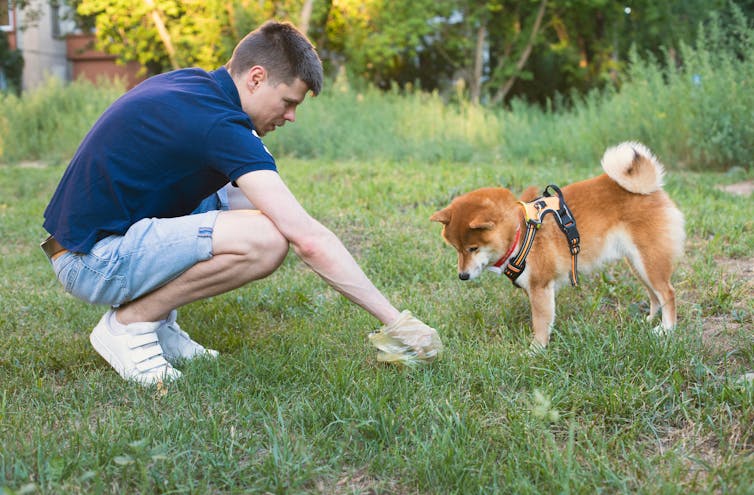
What’s that smell? Is that what you think it is? You check your shoes and, sure enough, one is adorned with a sticky, foul-smelling patty of fresh wrongness. You have stepped in a landmine of the canine variety.
We’ve all been there, and we all know footpaths, nature strips, parks, playing fields and front lawns are not good places for dog poo to sit.
Yet, our streets and parks continue to be littered with dog poo. And with the pandemic driving a surge in dog ownership, anecdotal reports suggest the dog poo problem has grown only worse in recent years.
Beyond the obvious unsightliness and the likelihood of making unwanted contact with dog poo, there are some other important reasons to pick up after dogs.
Here’s what you need to know and what the science says about common efforts to deter dogs from pooping on your yard.
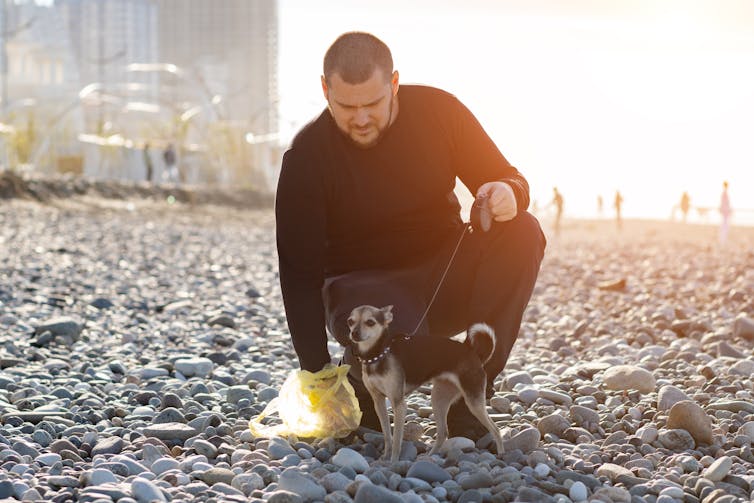
Dog Poo Is Linked To Illness, Pollution And Antibiotic Resistance
Dog faeces may contain microorganisms that cause illness in humans such as Salmonella, E. coli, Giardia and internal parasites.
Dog poo can also be a potential reservoir for antibiotic-resistant bacteria, meaning humans could develop bacterial infections that are difficult to treat through contact with dog faeces.
A recent Sydney study also identified dog faeces washed into storm water as a significant contributor to water pollution.
This topic, in spite of its relevance and impact, has received little attention from scientists. Thankfully, however, we have a few brave souls who can say they have studied dog crap for the betterment of humanity.
This research has revealed some patterns in where dog faeces is found in public.
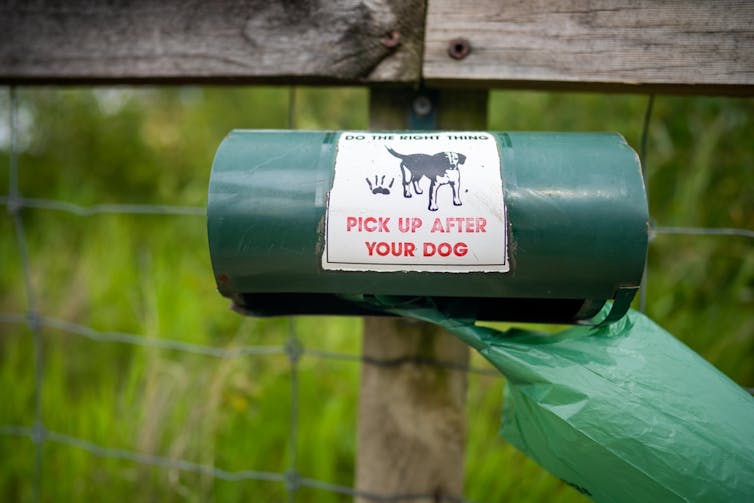
Where Is The Dog Poo Problem More Common?
Dog fouling is significantly more common in parks where dogs are allowed off-leash, and areas close to car parks.
The way dog walkers have traditionally used an area may also be an important factor, with one UK study noting:
availability of bins, path morphology, visibility, and path location are key factors in determining the occurrence of dog faeces.
The same study noted that while most dog walkers do the right thing, some are too “proud to pick up”, while others make contextual judgements about where and when it could be permissible to leave dog waste. Yet others are “disengaged” dog walkers, who “will not pick up even if they are aware of the health and environmental consequences”.
Other research has suggested targeting keeping dogs on-leash between car parks and off-leash areas and providing waste disposal stations on popular dog-walking routes.
This doesn’t help if you have a neighbour who lets their dog out to relieve themselves on the nature strip (or your yard), or people who walk their dogs without carrying waste disposal bags.
And we all love the ones who bag the poop but leave the bag tied to a fence or by a gate.
What About The Old Water-Bottles-On-The Grass Trick?
Dog owners who don’t pick up after their dog can be fined, but it can be hard to catch them in the act, and reporting a neighbour to authorities can often lead to ongoing hostility.
Bottles of water on the grass is a time-honoured strategy to deter dogs, but there is no evidence this is effective and no clear reason why it would be.
Dogs sometimes like to circle and find just the right spot to go, so they may prefer an area that has fewer obstacles to negotiate. Perhaps a yard bristling with lawn ornaments would enjoy some protection. (Interestingly, science suggests dogs may circle around like this to align their body to face north.)
There are commercially available dog deterrents, but little evidence they are effective and under what conditions.
Some believe any strong scent may deter an animal with a very strong sense of smell from lingering long enough to take a dump. But scent travels, so heavy and repeated applications would likely be needed (and this strategy could have unintended side effects on native urban ecosystems).

Educating Dog Walkers Is Key
Aside from providing bags and a bin and enforcing leash laws particularly around carparks close to off-leash areas, research suggests education does help.
Messages emphasising that good neighbours and members of the community diligently pick up after their dogs may be most effective, as people are responsive to social messages.
If you have tried to appeal to your neighbour’s sense of community to no avail, and you’re not keen on a front yard bristling with garden gnomes and flamingos or drenched in possible dog-deterring chemicals, you could try providing bags and a sign promising surveillance.
For all the dog owners out there that do pick up after their dogs, your community thanks you.
The best way to dispose of dog faeces is in the bin. Composting requires high temperatures to neutralise the nasties in dog poop, and home composts are unlikely to get hot enough. And burying it simply allows these microorganisms to build up in the soil.![]()
Melissa Starling, Postdoctoral researcher, University of Sydney
This article is republished from The Conversation under a Creative Commons license. Read the original article.
All-electric homes are better for your hip pocket and the planet. Here’s how governments can help us get off gas

If every Australian household that uses gas went all-electric today, we would “save” more than 30 million tonnes of carbon dioxide emissions over the next ten years. That’s because there are more than 5 million households on the gas network, and the avoided emissions per home ranges from 5-25 tonnes over the coming decade, depending on the location.
Most people would spend less money on energy too. Electric appliances use less energy than gas appliances to do the same job, making them cheaper to run.
Our new report shows how much most households can save by switching from gas to electricity for heating, hot water and cooking. The extra cash couldn’t come at a better time: about a quarter of Australian households say they found it difficult to pay their energy bills this year.
But many households face hurdles that stop them, or make it hard for them, to go all-electric. Governments could make it easier for people and bring emissions-reduction targets closer to reality.
Most Households Save By Upgrading To Electric
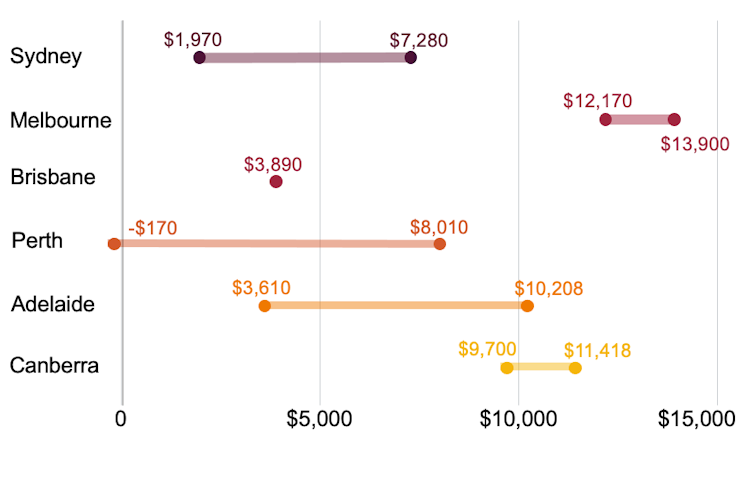
Households in Melbourne tend to use more gas than those in other mainland capitals, mainly because the winter is so cold. Our report found Melburnians who replace broken gas appliances with electric ones, or move into an all-electric home, could save up to A$13,900 over ten years. Households with rooftop solar will save even more.
It’s a similar story in most parts of Australia except the west, where gas is relatively cheap. This mainly reflects differences in the historical development of the gas markets between the west and east coasts.
Getting off gas could also be good for your health. Several studies link cooking with gas to childhood asthma.
Households Face A Series Of Hurdles
Renters make up nearly a third of all households, and they have little or no control over the appliances that are installed. As most electric appliances cost more to buy than gas ones – and the subsequent bill savings flow to tenants – landlords have little incentive to upgrade their properties from gas to all-electric.
Apartment living can increase the level of complexity. Multi-unit dwellings often bundle gas bills into body-corporate fees, limiting the occupants’ incentive to go all-electric. There can also be space constraints in these buildings. Centralised electric heat pumps, for example, take up more space than centralised gas water heaters.
Then there are households that simply can’t afford the upgrade. Induction stoves and heat pumps are more expensive than their gas equivalents, by up to a combined $2,000. This initial outlay will soon be recovered by cheaper energy bills, but that doesn’t help households that don’t have the cash up front. The 12% of households that skipped meals to pay their energy bills in the past year are the most likely to remain locked into high gas bills.
Some people also simply prefer cooking with gas. Some think induction cooktops will be no better than the poor-performing electric cooktops they may have used in the distant past. Others haven’t ever heard of a heat pump for hot water.
Here’s How Governments Can Help
Governments, both state and federal, should lower the hurdles on the path to all-electric homes – to reduce people’s cost of living and to cut carbon emissions.
As a first step, state governments should ban new gas connections to homes. In 2021, more than 70,000 households joined the gas network. Trying to shift households off gas while allowing new connections is like pouring water into a bucket with a hole.
Then, governments should provide landlords with tax write-offs on new induction stoves and heat pumps for hot water, for a limited time. After that, they should require every rental property to be all-electric. Governments should pay to upgrade public housing to all-electric, where they are the landlords. And they should pay not-for-profits managing community housing to do the same.
The federal government should help all households to spread the cost of electric appliances over time. It should subsidise banks to offer low-interest loans for home electrification, via the Clean Energy Finance Corporation.
And governments should set out to change people’s preferences, from gas to electric. They should embark on a multi-decade communication campaign, not unlike the campaign to upgrade from analogue to digital television in the early 2000s.
A key challenge will be shifting people’s ideas about the best way to cook. There are precedents. In Gininderry, a new all-electric suburb of Canberra, one developer recruited chefs to run demonstrations on induction cooktops at the display village. The proportion of potential homebuyers willing to consider buying an all-electric home rose from 67% to 88%.
‘Green Gas’ Is No Panacea: Electricity Is Cheaper
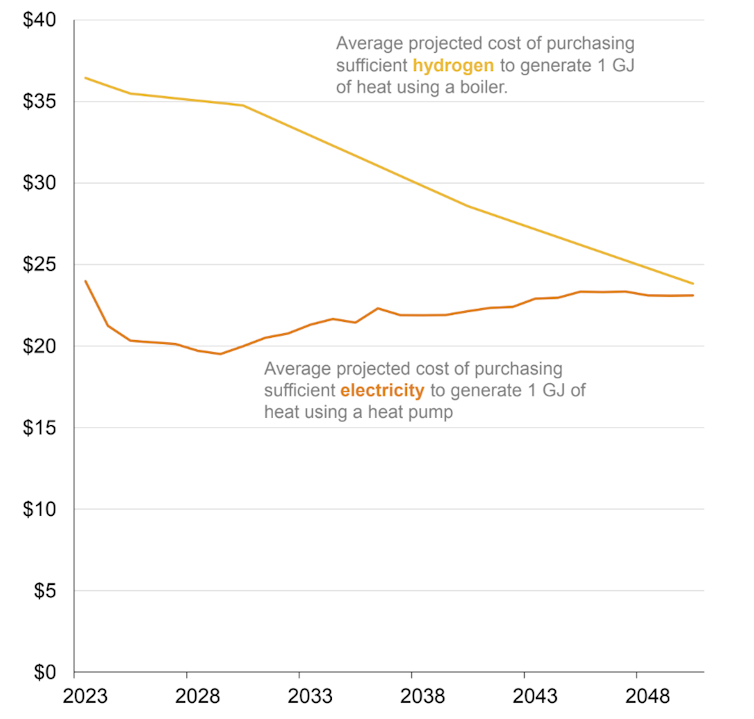
The gas industry has another solution in mind: instead of switching from gas to electricity, it suggests using “green gas” – biomethane or “green” hydrogen. Biomethane is chemically identical to natural gas, but is derived from biological materials such as food waste, sewage or agricultural waste. Green hydrogen is made by using electricity to split water into hydrogen and oxygen.
But both options are too expensive and too far away. Under the most generous of assumptions, green hydrogen will only become cost-competitive with electricity after 2045. And there is not enough biomethane commercially available to replace gas in households.
Meanwhile, more than three million Australian homes already run on electricity alone.
Getting the five million homes that use gas to the same point won’t be easy. But with good policy, it is doable. For households, and the climate, there is much to be gained.![]()
Esther Suckling, Research Associate, Grattan Institute
This article is republished from The Conversation under a Creative Commons license. Read the original article.
Marine species are being pushed towards the poles. From dugong to octopuses, here are 8 marine species you might spot in new places
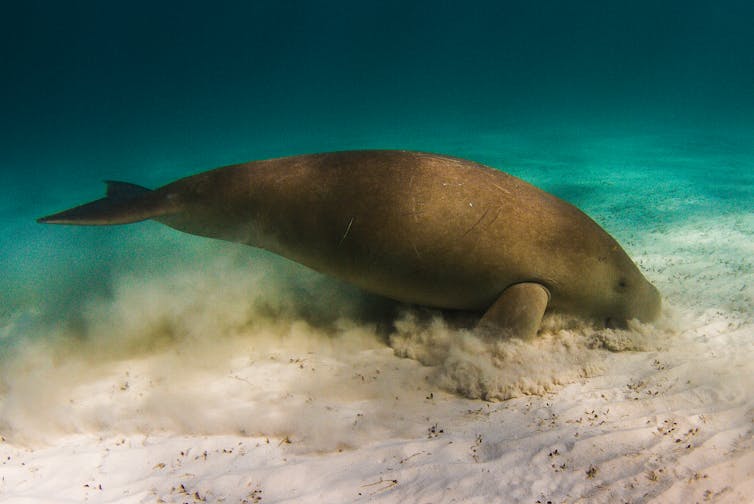
If you take a plunge in the sea this winter, you might notice it’s warmer than you expect. And if you’re fishing off Sydney and catch a tropical coral trout, you might wonder what’s going on.
The reason is simple: hotter water. The ocean has absorbed the vast majority of the extra heat trapped by carbon dioxide and other greenhouses gases. It’s no wonder heat in the oceans is building up rapidly – and this year is off the charts.
That’s even without the likely arrival of El Niño, where the Pacific Ocean gets warmer than usual and affects weather all over the world. Our coastal waters are forecast to be especially warm over the coming months, up to 2.5℃ warmer than usual in many places.
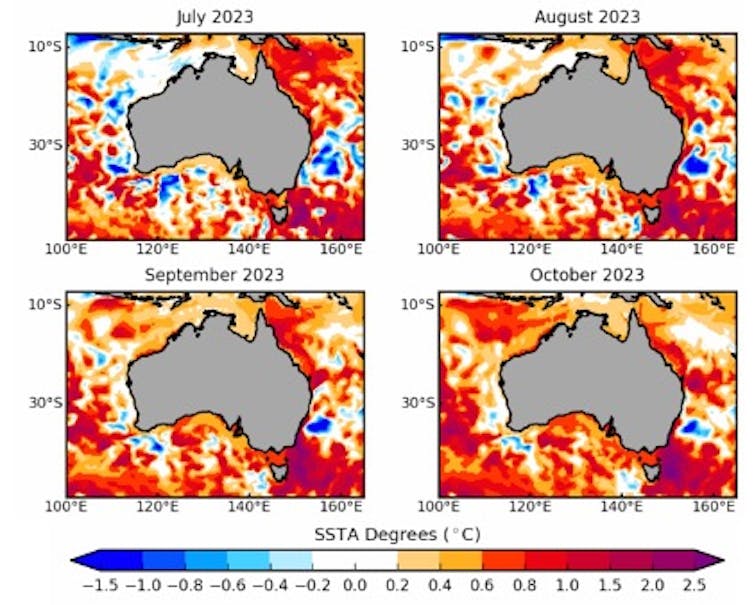
Many marine species live within a narrow temperature range. If the water heats up, they have to move, and if they don’t, they might die. So those that can move, are moving. In Australia, at least 200 marine species have shifted distributions since 2003, with 87% heading south.
This pattern is happening all around the world, both on land and in the ocean. This year, the warmer ocean temperatures during winter mean Australia’s seascapes are likely to be more like summer. So, the next time you go fishing or diving or beachcombing, keep your eyes peeled and your camera ready. You may glimpse the enormous disruption happening underwater for yourself.
Here Are Eight Species On The Move
1. Moorish idol (Zanclus cornutus)
Historic range: northern Australia
Now: This striking fish can now be seen south of Geraldton in Western Australia and Eden in New South Wales.
This is a great fish for divers to spot on hard-bottomed habitats.
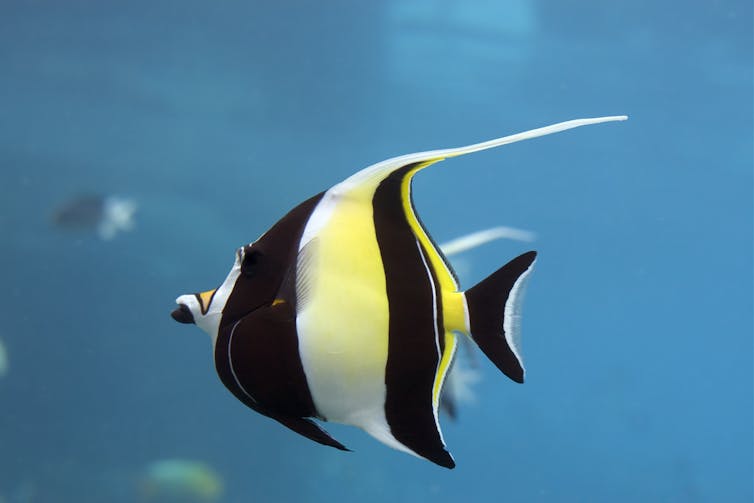
2. Branching coral (Pocillopora aliciae)
Historic range: northern NSW
Now: Look out for this pale pink beauty south of Port Stephens, not far from Sydney.
Seemingly immovable species like coral are fleeing the heat too. They’re already providing habitat for a range of other shifting species like tropical fish and crab species.
3. Eastern rock lobster (Sagmariasus verreauxi)
Historic range: common in NSW
Now: South, as far as it can get. It’s now found in Tasmania and even in South Australia.
This tasty greenish crustacean doesn’t like heat and has moved south into the territory of red southern rock lobsters (Jasus edwardsii).
4. Gloomy octopus (Octopus tetricus)
Previous range: common in NSW
Now: As far south as Tasmania.
Look out for this slippery, smart invertebrate in Tasmanian waters this winter. You might even spot the octopus nestled down with some eggs, as this looks to be a permanent sea change.
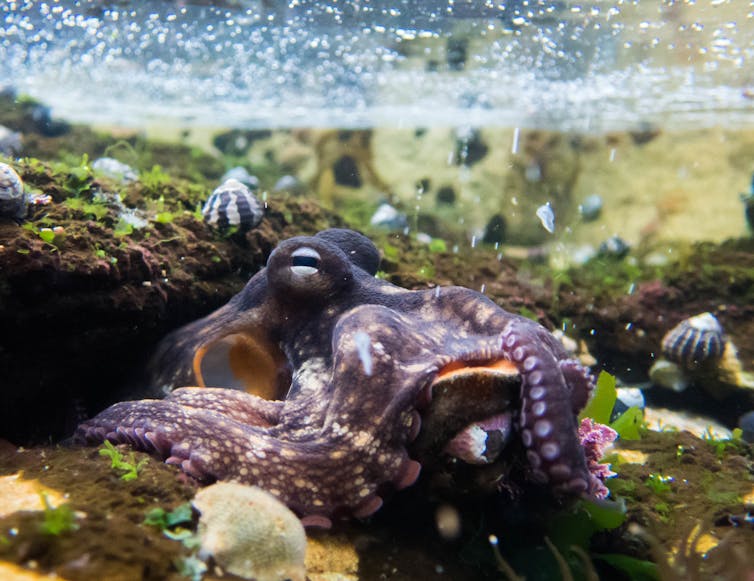
5. Whitetip reef shark (Triaenodon obesus)
Previous range: northern Australia
Now: South of K'gari (formerly known as Fraser Island).
Classed as vulnerable in parts of the world, this tropical shark is a slow swimmer and never sleeps. It poses very little danger to humans.
6. Dugongs (Dugong dugon) Previous range: northern Australia
Now: As far south as Shark Bay in WA and Tweed River in New South Wales.
Our waters are home to the largest number of dugong in the world. But as waters warm, they’re heading south. That means more of us may see these elusive sea-cows as they graze on seagrass meadows.
Some of the most adventurous have gone way out of their normal range – in 2014, a kitesurfer reported passing a dugong at City Beach, Perth. As a WA wildlife expert says, dugongs may occasionally stray further south of Shark Bay but “given the recent warming trend […] more dugong sightings might be expected in the future”
7. Red emperor (Lutjanus sebae) and other warm water game fish
Previous range: northern Australia
Now: Appearing much further south – especially in WA.
Look for red, threadfin, and redthroat emperors in southwest WA as the Leeuwin current carries these warm water species south. As WA fisheries expert Gary Jackson has said, this current is a warming hotspot, acting like a warm water highway for certain marine species.
These fish are highly sought after by fishers.
8. Long-spined sea urchin (Centrostephanus rodgersii)
Historic range: NSW and Victoria
Now: Tasmania
Look out for these spiky critters in southern and western Tasmania. The larvae of these urchins have crossed the Bass Strait and found a new home, due to warming waters. Urchins are grazers and can scrape rocks clean, creating urchin barrens where nothing grows. That’s bad news for kelp forests and the species which depend on them. In response, Tasmanian authorities are working to create a viable urchin fishery to keep numbers down.
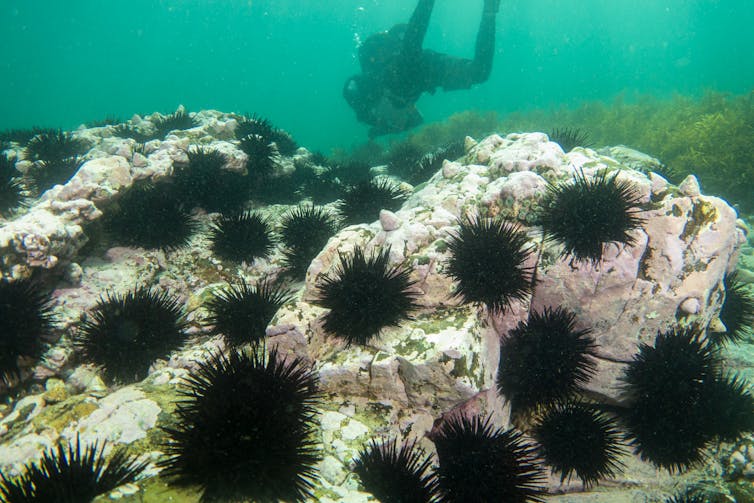
You Can Help Keep Watch
For years, fishers, snorkellers, spearfishers and the general public have contributed their unusual marine sightings to Redmap, the Australian citizen science project aimed at mapping range extensions of species.
If you spot a creature that wouldn’t normally live in the waters near you, you can upload a photo to log your sighting.
For example, avid spearfisher Derrick Cruz logged a startling discovery with Redmap in 2015: A coral trout in Sydney’s waters. As he told us: “I’ve seen plenty of coral trout in tropical waters, where they’re at home within the coral. But it was surreal to see one swimming through a kelp forest in the local waters off Sydney, much further south than I’ve ever seen that species before!”
How does tracking these movements help scientists? Many hands make light work. These vital observations from citizen scientists have helped researchers gain deeper understanding of what climate change is doing to the natural world in many places, from bird migrations to flowering plants to marine creatures.
So, please keep an eye out this year. The heat is on in our oceans, and that can mean sudden change. ![]()
Gretta Pecl, Professor, ARC Future Fellow & Director of the Centre for Marine Socioecology, University of Tasmania; Curtis Champion, Research Scientist, Southern Cross University, and Zoe Doubleday, Marine Ecologist and ARC Future Fellow, University of South Australia
This article is republished from The Conversation under a Creative Commons license. Read the original article.
Why shouldn’t I pour oil or paint down the sink? And what should I do instead?

Are you ever tempted to pour used cooking oil down the sink? Just turn on the tap and flush it all away. What about that half-used tin of paint in the cupboard? It would be so easy just to wash it down the drain, wouldn’t it?
Well, please don’t! Not just because these bad habits cause problems in your house, backyard, apartment block or neighbourhood (and these products do lead to huge blockages and other issues for household pipes).
It’s also because pouring these things down the sink triggers society-wide problems for the entire sewerage system and the workers who maintain it.
For the sake of all of us, please dispose of these liquids properly. Here’s what you need to know.
A Disaster For Our Sewerage Systems
The smooth day-to-day operation of our wastewater collection, treatment and disposal relies on the cooperation of people to “do the right thing”.
I’ve contacted many of our water utilities across Australia for this article. They are in broad agreement: please don’t put oil, fats, grease or paint or other chemicals down the sink.
They all offer advice on far better alternatives. But the water industry has no control over what we do in the privacy of our homes. It really is up to us.
The Worst Culprits
Canberra’s water utility, Icon Water, gives advice on what you can and can’t flush down the sink. They rate “fats, oils and grease” as the worst culprits.
When still hot, oils are often liquid and easily pour. But down in the sewer pipes they rapidly cool and solidify.
This is a serious and common problem. Western Australia’s Water Corporation estimates 30% of sewer blockages are due to fats, oils and grease.
All sewerage systems are vulnerable to blockages from unsafe materials tipped down the sink, or flushed down the toilet.
Oils, fats and grease can combine with other materials flushed down the toilet. These particularly include hair and so-called “flushable wipes” (which, despite the name, should not be flushed down the loo).
These can build up over time, creating giant monstrosities known as “fatbergs”: horrible clumps of wipes, hair, hardened oils and other waste.
Fats and oils act as the glue that helps fatbergs build up at choke points in sewer systems.
Thames Water engineers in the United Kingdom worked in underground sewers for two weeks during 2021 to remove one the size of a small house. I’m claustrophobic and cannot imagine a more horrible job.
Uncontrolled Release Of Raw Sewage
Blocked sewers are not just a smelly problem for the water industry; they are bad for all of us. They can trigger the uncontrolled release of raw and untreated sewage into the environment.
As Sydney Water explains, these can be health and environmental nightmares.
I have seen raw sewage flowing in public places, parks, people’s backyards, shopping centres, thanks to blocked pipes. Raw sewage is a serious public and environmental health hazard.
So What Am I Supposed To Do Instead With Oils?
Cooking oils can actually be recycled and used to make stockfeeds, cosmetics and biofuels.
With some careful preparations diesel engines can run on cooking oil.
It is particularly important the food industry carefully manage their waste as it can generate very large volumes of fats, oil and grease.
Small amounts of cooking oil can safely be composted. But be careful; too much can disrupt the flow of oxygen. This can trigger anaerobic decomposition of compost, which smells unpleasant and can also attract unwanted pests.
Even just disposing of fats, oils and grease into the rubbish and landfill is much better than tipping it down the sink. Remember, you may need to cool hot oil down before putting it in the bin.
What About Tipping That Old Paint Down The Sink?
Many people are unsure what to do with unused housepaint.
GWM Water, the water service for regional western Victoria, says paint, oils, lubricants, pesticides and thinners should not go down the sink. They can damage sewer pipes, cause pollution and create fumes which can be dangerous for maintenance workers.
Sewer maintenance workers have to work underground in incredibly demanding environment; squeezing into tight, enclosed spaces in sewerage system is part of the job.
The quality of air that they breathe reflects what people flush down the sink. Some chemicals can even create explosive conditions in sewer pipes. Sadly, sewer workers have even been killed from dangerous fumes.

What Should I Do Instead With Old Paint?
Contact your local council or refer to this helpful guide from the ACT government.
The paint industry encourages all people to take unwanted paints to a “Paintback” dropoff centre. This industry-funded scheme aims to reduce the risks of unsafe disposal of unwanted paint products and maximise recycling.
Please try to thoughtfully dispose of all waste products. And please try to resist the temptation to quickly flush away oils or paint that could damage or block the sewerage system. ![]()
Ian A Wright, Associate Professor in Environmental Science, Western Sydney University
This article is republished from The Conversation under a Creative Commons license. Read the original article.
Global average sea and air temperatures are spiking in 2023, before El Niño has fully arrived. We should be very concerned
Steve Turton, CQUniversity AustraliaRecent spikes in ocean heat content and average global air temperature have left climate scientists across the world scrambling to find the cause. The global average air temperature, relative to 1850-1900, exceeded the 1.5℃ lower Paris Agreement threshold during part of March and the first days of June. This last happened in 2020, and before that during the powerful 2015-16 El Niño.
What makes these most recent temperature spikes so alarming is that they’ve occurred before a forecast El Niño event in the Pacific, rather than during one.
It is now clear that Earth’s climate system is way out of kilter and we should be very concerned.
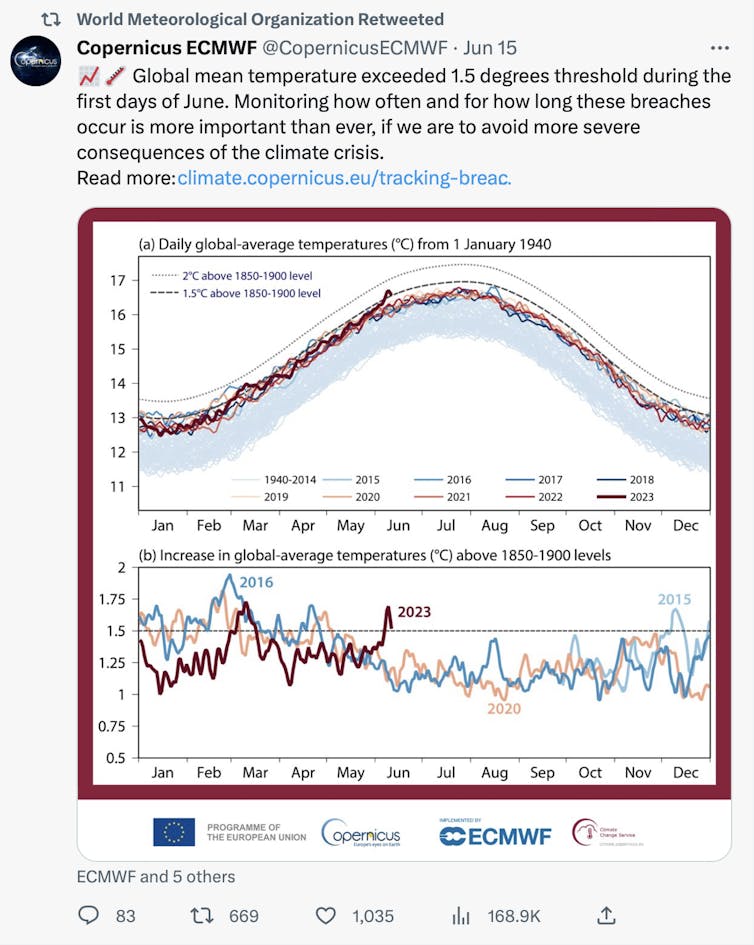
We already know El Niño events are associated with above-average global temperatures. Given the impending El Niño, we all need to take extra notice of what lies ahead for the next few years. This is especially so as this forecast warming event will follow the recent rare triple La Niña event that usually brings cooler average global temperatures, meaning the trajectory of this year’s uptick in average temperatures is likely to be even steeper.
The Earth Energy Imbalance - the difference between the amount of energy arriving from the Sun and the amount returning to space - is now running at an all-time high. This is the most crucial measure of the prospects for continued global heating and human-driven climate change.
This metric will also be vital for monitoring our overall success in meeting the Paris Agreement’s targets, which call for humanity to hold average warming ideally to 1.5℃ above the pre-industrial average, or at least to as much under 2℃ as possible.
How Much Warmer Are The Oceans This Year?
Since 1971, about 89 % of the excess heat in Earth’s climate system has been stored in the ocean (with 6 % on land, 1 % in the atmosphere, and about 4 % going towards melting ice on land and sea).
Because of this, any significant upward trend in average ocean heat is considered a harbinger for the acceleration of human-driven climate change more generally.
Scientists monitor the status of Earth’s energy imbalance by considering how much the average sea-surface temperature differs from the historical average, for a vast slice of the oceans covering everywhere between the Arctic Circle (60°N) and Antarctic Circle (60°S). These “sea surface temperature anomalies” are calculated each month, relative to the 1971-2000 baseline.
The global sea surface temperature anomaly on June 13 was about 4.5 standard deviations above the baseline global average. Put another way, this means the likelihood of current temperatures happening totally at random, if the climate this month was unchanged from the baseline period, are about 1 in 1.2 million.
This anomaly is so far above record levels it is judged almost statistically impossible to a have occurred in a climate without human-induced global heating.
The 36-month running average for the Earth Energy Imbalance is now at a record 1.36 Watts per square metre. This looks like a small value, but it corresponds to an average of 11 Hiroshimas of excess energy per second accumulating in Earth’s climate system over the past three years.
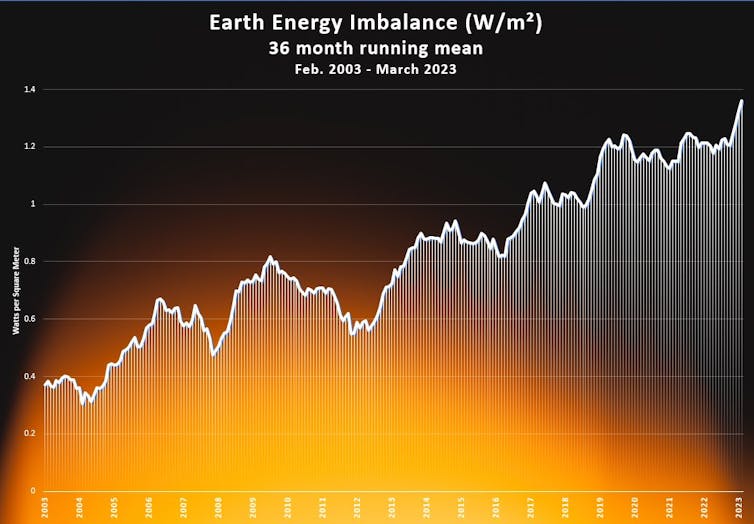
Why Is This Happening Now?
A range of natural and human climate drivers are behind this record global energy imbalance. These include rapidly declining sea ice in Antarctica and unusually warm temperatures in many parts of the world.
The early arrival of El Niño may also be playing a lesser role, as the warming in the central and eastern equatorial Pacific is not expected to peak until next year. The submarine volcano Hunga Tonga-Hunga Ha'apai erupted in January 2022 and ejected record-breaking amounts of water vapour into the stratosphere. Water vapour acts as a potent greenhouse gas, and this may be contributing to the currently observed warming.
Other possible agents of warming include new regulations around sulfur aerosol emissions from shipping, and even a recent lack of Saharan dust. Both these forms of atmospheric aerosols have a cooling effect, as they reflect a small percentage of sunlight back to space.
Warm ocean anomalies are not restricted to the Pacific. The North Atlantic is incredibly warm at present. In fact, the entire North Atlantic has broken ocean temperature records for any time of year.
This pool of warm water has been linked to changes in the jet stream, creating a heat dome over eastern Canada and providing a catalyst for record-breaking wildfires.
If a strong El Niño develops later this year and continues in 2024-25, it will bring a very high risk of extreme climate-driven events around the world.
There is also a very high chance the warmest year on record will occur over the next five years.
Eastern Australia is an El Niño “hotspot”. This means an increased risk for drought, bushfires, heatwaves, crop failures and mass coral bleaching events on the Great Barrier Reef.
Greenhouse gases from human sources continue to rise and accumulate in the atmosphere. Rising emissions will fuel global heating, resulting in shifting climate baselines – what is often termed the “new normal” brought about by climate change.
Climate models predict with high certainty that as these climate baselines shift, so will the increased risk of extreme weather events. Effects of natural climate drivers, such as El Niño patterns in the Pacific, are likely to be amplified as the background climate warms.
Scientists will watch the current spike in global ocean and atmospheric temperatures very closely as the forecast El Niño strengthens later this year. What is less well understood is how other climate drivers may interact with the warming effects of El Niño.
Notably, how will the lingering atmospheric water vapour from the Hunga Tonga-Hunga Ha'apai eruption amplify any El Niño warming? All we can do is prepare for more record-breaking weather.![]()
Steve Turton, Adjunct Professor of Environmental Geography, CQUniversity Australia
This article is republished from The Conversation under a Creative Commons license. Read the original article.
Before the colonists came, we burned small and burned often to avoid big fires. It’s time to relearn cultural burning

For 60,000 years, many First Nations peoples managed the land that sustained us. Fire, for us, was not destructive. It created new life. We believe bringing back cultural burning is an important step towards creating a more just and sustainable future.
We are from the Githabul and Ngarakbul peoples of the Yoocum Yoocum Moeity. Our traditional lands span what is now northern New South Wales and southern Queensland. But the knowledge of how to burn and when to burn spans the entire continent.
We want to pass this knowledge on, from First Nations to the ones who came later. Farmers, landholders, people with bush blocks – these are the people who need this knowledge.
Over a decade ago, we ran a workshop for Jayn Hobba, a non-Indigenous woman who has a nature reserve property outside Stanthorpe. We taught her about the art of tree thinning and cultural burns.
She writes:
Working alongside traditional owners who are the fire, soil and water keepers of their culture, I’ve also gained much practical knowledge in thinning out native black cypress, conserving old growth eucalyptus and mosaic cool burning. A decade later, I can see culturally appropriate fire regimes and conservative thinning of vegetation are benefiting the ecosystems and reducing fuel load.
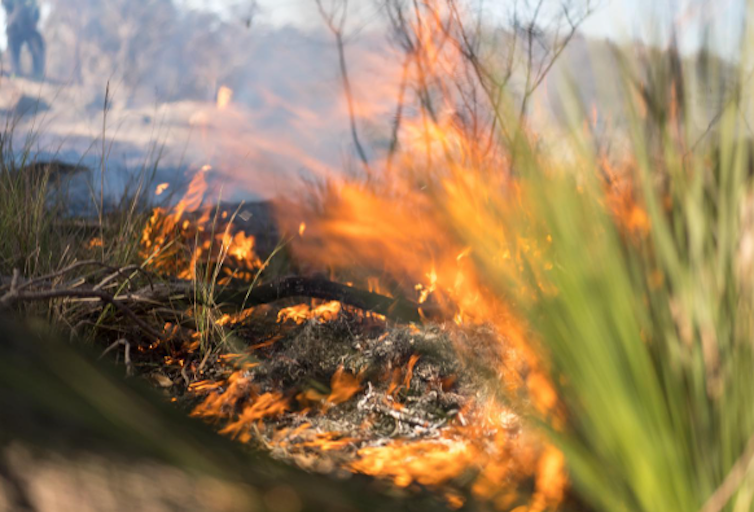
Why Is Cultural Burning Undertaken?
Every group burned country differently. The knowledge of what to burn – and when to burn – is known as lore. By burning the right areas at the right time, we burn off the fuel loads and keep Australia’s fire-loving trees from starting dangerous fires.
The way we burn is known as mosaic cool burning – burn this area, leave this area – which produces a pattern of newer and older growth across the landscape. Traditionally, these mosaics produced new growth attracting kangaroos and wallabies, which could then be hunted.
Our thousands of years of cultural burning made much of Australia look like a park – stands of trees, large tracts of grass and shrub, as historian Bill Gammage has detailed.
After the colonists came, much knowledge was lost. Cultural burning, too, could have been lost. But it survived.
How Does It Differ From Hazard Reduction Burns?
Cultural burns are cool, low intensity burns which stay on the ground. Hazard burns are usually hot burns, done with more intensity.
Cool burns are best done at night or early in the morning. Many Australian trees sweat flammable oils during the day, making it a more dangerous time. Early morning dew helps to cool the fire. The wind is often gentle during a morning burn, assisting us as we direct the fire.
Cool fires do not bake seeds or nutrients into the soil, nor do they destroy root systems. Because the flames are so low, they cannot leap up to set tree canopies on fire and can only char the bottom bark.
Cool fires help change ground vegetation by reducing the density of plants such as bracken fern and casuarina, which lead to high fuel loads. Hot fires will encourage their regrowth.
If fires are started too early in the season, thick shrub grows afterwards which adds to fuel loads. If fires are started too late, dried-out fuel can make fires more intense and even lead trees to explode.
Hazard reduction burns are performed to control overgrowth of bush. If cool burns aren’t done, fallen branches, leaf litter and dead trees keep building up and up. Australia’s trees are very messy – many of them shed bark and leaves and branches to encourage fire.
First Nations people did everything they could to avoid intense, destructive bushfires. By burning small and burning often, we made sure the fuel never built up to extreme levels.
But after we were colonised, cultural burning almost entirely stopped. Forests grew back, covering some grasslands. Fuel began to build up. And immense bushfires began. Black Friday, 1939. Black Saturday, 2009. And the devastating Black Summer of fire in 2019-2020. These show us what happens when we do not burn country properly.
How Is It Done?
Cultural burning is complex and nuanced. To do it properly, you need thorough knowledge of the natural environment. You can’t simply walk into a field or forest and set it alight.
Fire lore is passed on from knowledge holders to initiates. We are taught to read signs in the land and signals in the environment to know when to burn, from different grasses drying out to trees beginning to flower, seed or fruit, to animal breeding and migration.
The reason for this is simple. Burning at the wrong time in the wrong place risks a cool burn running hot. As our firefighters know, it’s very hard to find the right time to do burns.
Each country contains its own season for fire – the time when fire can help cleanse, reset and safekeep the land, ready for the rebirth that comes after burning.
The Return Of Cultural Burning
The Black Summer had many causes, ranging from climate change to misuse of land and bad land and water use. The absence of cultural burning and traditional land management practices made matters worse.
Cultural burning and land management can improve soil health, dampen down the impact of weeds and invasive species, control pests, sequester carbon and improve runoff and water quality.
Cultural Burning Could Help Create A Better Future
Using fire in this way is an ancient artform. We consider it a sacred tool.
As we grapple with ever-larger bushfires, it’s time to start involving Traditional Owners more in talks, negotiations and planning – especially when it affects our own country. Our knowledge of this continent may help save lives, land, flora and fauna – and help protect all of us from the ravages of climate change.
Our organisation and others like it work with non-Indigenous Australian landowners and farmers to undertake cultural burns – and to pass on the lore. ![]()
Robbie Williams, Traditional Owner, Indigenous Knowledge
This article is republished from The Conversation under a Creative Commons license. Read the original article.
Wallaby joeys and platypus puggles are tiny and undeveloped when born. But their mother’s milk is near-magical
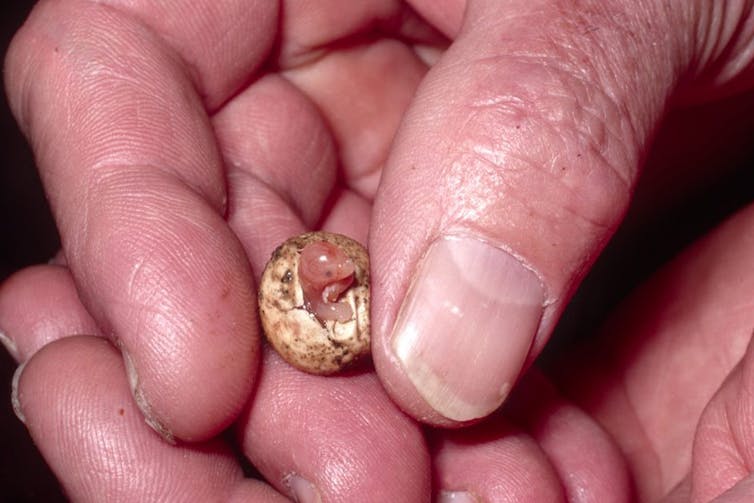
You’re a mammal. So is a kangaroo. We’ve got much in common. But one of the most interesting is we all feed our newborns with milk. The word mammal comes from mamma, which is Latin for breast.
In Australia, we have many placental mammal species, like bats and native rodents. Humans are placental mammals too. But our country is far better known for our marsupials and monotremes, which have different reproductive strategies to placental mammals. We have around two-thirds of all living marsupial species, and two of the five remaining monotreme species on the planet – the platypus (Ornithorhynchus anatinus) and short-beaked echidna (Tachyglossus aculeatus). The other three echidna species live on the island of New Guinea.
Monotremes are the only mammals to lay eggs. When an echidna egg hatches, the baby is very underdeveloped. Marsupials, too, give birth to underdeveloped young. When a wallaby gives birth to a tiny pink joey, it’s the equivalent to us giving birth to an eight week old foetus. Most of their development happens outside the womb or egg.
To overcome this, female marsupials and monotremes produce truly remarkable milk. Their milk not only supplies nutrients for sustenance, but also has factors essential for growth and immunological protection. Their milk likely has chemicals serving to attract newborns to the teat even though they have very little sensory or movement ability at this stage.
It Can Be A Fight To Find A Teat
All mammals possess mammary glands. These specialised glands evolved 166–240 million years ago and have diversified into a wide range of sizes and shapes.
While marsupials have teats for their joeys to suckle from, monotremes have milk patches which secrete milk directly onto the pigmented skin of the areola where their baby puggles can lap the milk from the pores. For marsupials, the number of teats equates to the number of mammary glands. The larger the marsupial, the fewer teats they have. Smaller marsupials have more teats. The highest number of mammary glands recorded in a marsupial is 13, in the gray short-tailed opossum (Monodelphis domestica), while the largest surviving marsupial, the red kangaroo (Osphranter rufus), only has four teats.
As you’d expect, teat numbers align with the maximum number of young a marsupial mother can sustain. Newborn marsupials have to seek out and firmly attach themselves to the teat. In some species, the first hours are brutal as more young can be born than there are teats for them, and only those able to latch on in the first few hours can survive. The red-tailed phascogale (Phascogale calura) – a tree-living insect eating marsupial – can give birth to up to 13 young but females only have eight teats.

So What’s In Their Magic Milk?
Monotremes and marsupials produce different milk at different stages of lactation.
Early on, their milk is more dilute. As the joeys and puggles get bigger, it becomes more concentrated, with more protein and fat. This peaks towards the end of lactation when the young are weaned. Carbohydrate levels peak in mid to late lactation and then decrease to weaning. Interestingly, iron levels in marsupial and monotreme milk are three times higher than in placental mammal milk. That’s because joeys and puggles are so undeveloped – they have to rely on iron-rich milk to construct proteins to build, carry and store oxygen until their liver matures.
Macropod (big foot in Greek) marsupials like kangaroos and wallabies are capable of an even more remarkable feat. They can produce tailor-made milk with different nutrients from different teats so they can feed, say, a newborn joey at the same time as feeding her older brother who is about to leave the pouch.
Producing Milk Takes Effort And Energy
As anyone who has breastfed a child will know, it’s tiring – and you get hungry. Marsupial mums need double or triple their usual amount of energy by boosting how much they eat, while echidnas have to rely on their fat stores at first, because they stay in the nursery burrow all the time when the puggles are tiny. When their offspring are a bit older, the mother leaves them alone and goes on a hunt for ants and termites.
More milk means faster growth rates for the young. Monotreme puggles, particularly echidnas, are fed infrequently. Their growth is clustered around feedings. They grow faster after having a big feed and slower when their mother is out foraging. Marsupial and monotreme milk also provides essential nutrients and additional factors required to support growth.

Milk, The Immunological Superhero
Marsupial joeys cannot fully defend themselves against bacteria and viruses at birth in the same way we can, because they lack mature immune tissues and cells.
That means their immune system is bolstered by milk. All mammals produce colostrum in their milk in the first few days of lactation. This milk often looks different, because it contains billions of antibodies to help defend the newborn.
In marsupials, milk carries antibodies as well as immunological cells from the mother. In marsupials with pouches, the pouch itself secretes antibacterial proteins to reduce the growth of opportunistic pathogens. For some species, such as the tammar wallaby (Notamacropus eugenii), licking and cleaning the pouch by the mother and the work of her saliva-borne digestive lysozymes are also likely to protect against bacterial attack.
Milk is essential to the survival of all mammals – but it’s especially important for puggles and joeys. The miracle and magic of marsupial and monotreme milk is how it’s tailored to help these tiny, underdeveloped creatures survive in the outside world – and how the milk changes throughout the process to match their changing requirements. ![]()
Hayley Stannard, Senior lecturer, Charles Sturt University and Julie Old, Associate Professor, Biology, Zoology, Animal Science, Western Sydney University
This article is republished from The Conversation under a Creative Commons license. Read the original article.
Is climate change outpacing our ability to predict extreme heatwaves?
Damien Irving, CSIRO and James Risbey, CSIROWhen an extreme weather event happens somewhere in the world these days, it’s common to read quotes from climate scientists explaining this is exactly the kind of event we expect to see more often as climate change progresses. Such events are often devastating, but not surprising if you’ve been paying attention to the climate projections issued by scientists for many decades now.
But every so often, an event is so extreme it causes scientists to question our understanding of just how fast climate change is progressing. One such event was the heatwave across the Pacific Northwest region of the United States and Canada in the northern summer of 2021, when temperatures at some locations hit 49℃ (121℉) – hotter than the all-time record for Texas.
It broke heat records by such a wide margin that scientists were quoted in the media saying they hadn’t expected to see temperatures so high in the Pacific Northwest until much later this century.
The basic concern for these scientists was that our computer climate models are best at simulating things that span large areas and long time periods, such as the annual average global temperature (what we broadly mean when we say “the climate”). They aren’t as good at simulating smaller-scale things such as an individual storm or hot wind (that is, “the weather”).
It’s not that our models can’t simulate small-scale weather – they’re basically the same models we use for weather forecasting – it’s just very computationally expensive to have them zoom in and run in “weather mode” to get a highly detailed simulation. It’s feasible for a seven-day weather forecast, but not for a century-long climate simulation.
Given this limitation, the scientists quoted in the media were concerned extreme weather events might be more sensitive to climate change than our models suggest.
Quantity Matters Too
While these concerns around the quality of our model simulations at weather-relevant scales are valid, what’s often overlooked is the quantity of model simulations involved. Given the natural variability in the climate system, scientists prefer not to rely on just one model simulation when making climate projections. Instead, they run a range of century-long simulations – from just a handful up to 50 or more for the most well-resourced modelling groups – and look at the range of possible outcomes.
For climate metrics such as the annual average global temperature, that’s enough simulations to capture the full range of possibilities. It’s a value that doesn’t vary much from year to year because it’s an average over the entire globe, so the climate change signal dominates over natural variability. To use a slightly more technical term, we say it has a high “signal-to-noise” ratio.
In contrast, the weather can vary greatly over relatively short time frames, and therefore has a very low climate signal-to-noise ratio. Something like the hottest day of the year at a given location is especially noisy, because small variations in the alignment of weather patterns can make all the difference between a regular hot day and a record-shattering one.
In this situation, many more simulations would be required to reliably estimate the upper limit on what extreme temperatures are possible.
How Many Simulations Are Enough?
To try and understand how many model simulations would be needed, our recently published research used a climate model to simulate 45,000 years’ worth of daily weather at Seattle-Tacoma airport in the Pacific Northwest.
We then went through a process of picking out 1,000 random samples of 100 years of data from this population of 45,000 years, then 1,000 samples of 500 years, 1,000 years, 5,000 years, and so on. For each sample, we wrote down the maximum daily temperature we found (that is, the record temperature produced in each of these sample simulations).
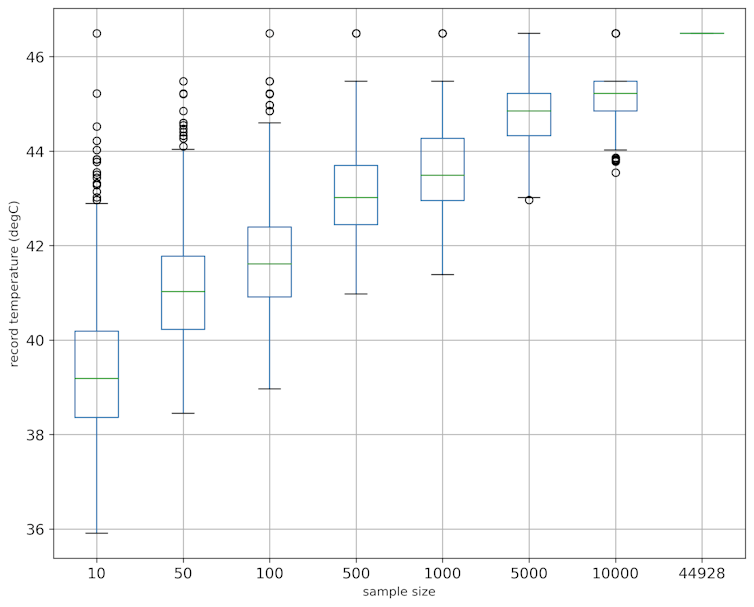
To our surprise, as the samples got bigger, the record temperatures we found showed little evidence of stabilising. They just continued to grow, indicating even samples spanning several thousand years are insufficient to capture the full range of possible extreme temperatures.
The reason we kept finding hotter days as the sample size grew is that the larger samples included more weather patterns. This meant there was a greater chance of producing a unique pattern with the near-perfect alignment of weather systems to generate even more heat at our fixed location. It turns out the weather patterns that produce the most extreme heat are very unique – and indeed far rarer than we’d expected.

Luck Of The Draw
From this perspective, the record-shattering heat experienced in the Pacific Northwest in 2021 was due not just to the overall trend of global heating, but also to the random shuffling of the weather. And our research suggests the latter factor plays an even larger role in this type of event than many climatologists had suspected.
This means that even though the Pacific Northwest heatwave broke records by such a wide margin, that is not necessarily a sign climate change is happening faster than expected, or that our models are doing a bad job of simulating how climate change increases the likelihood of extreme heatwaves.
It could simply be that our sample sizes are too small. If we had run more model simulations we could have simulated the right chance alignment of weather to generate a record-shattering day, meaning this real-life heatwave wouldn’t then have outstripped climatologists’ predictions to such an extent.
Advances in supercomputers have traditionally been used to run climate models at higher resolution (that is, to zoom in and get closer to “weather mode”). But when it comes to predicting just how extreme the weather can get in a warming world, we might get more bang for our buck by using those advances to run many more simulations as well. That will show us what kind of extreme heat is possible as a rare event now, and what will be more commonplace in the coming decades.![]()
Damien Irving, Climate Data Scientist, CSIRO and James Risbey, Researcher, Oceans and Atmosphere, CSIRO
This article is republished from The Conversation under a Creative Commons license. Read the original article.
An ‘extreme’ heatwave has hit the seas around the UK and Ireland – here’s what’s going on

One of the most severe marine heatwaves on the planet is taking place in the shallow seas around the UK and Ireland. That’s according to the US National Oceanic and Atmospheric Administration (NOAA), which has labelled this a “Category 4” heatwave. Rarely used outside of the tropics, a cat 4 heatwave means “extreme” heat.
Marine heatwaves are classified as “prolonged periods of anomalously high sea surface temperature”, when compared to the long-term average for that time of year. And thanks to measurements made by satellites orbiting the earth we know that, in some areas around the UK, surface water temperatures are 4°C to 5°C above normal for mid June.
This is extremely unusual: buoys around Ireland and the UK have been recording sea surface temperature for over 20 years, and in that time it has never been this hot this early in the summer.
The heatwave is strongest in the northern North Sea, northwest of Ireland, and the Celtic Sea between Cornwall and southern Ireland. However, in other areas, such as the southern North Sea, the English Channel and the southern Irish Sea, the surface temperatures are only a degree or so above normal.
The two regions are very different in oceanographic terms. The latter areas tend to be shallower (30-40 metres) with stronger tidal currents and so the water remains well mixed from the surface to the sea bed, all year around. In contrast, the regions where the heatwave is strongest are deeper (80-100 metres) with weaker tidal currents. As the mixing is weaker these seas “stratify” each summer, with a layer of warmer water overlying the cooler deeper layer.
In these seasonally stratifying regions the heat from the sun only warms the relatively shallow surface layer, while in the mixed regions the sun’s impact is diluted as its heat is mixed through the ocean from seabed to surface.
Oceans Are Slow To Warm Up And Cool Down
The temperature of the atmosphere can vary a lot day to day. You might find yourself wearing a jumper on Monday but shorts and a t-shirt by Wednesday. But oceans are different – their ability to absorb lots of heat means temperature varies slowly and extremes are rare.
In seasonally stratified regions the stratification starts to develop in late May, with the maximum sea surface temperatures happening in August. At these locations you would still only expect the temperature to vary by 10°C or so over the whole year (in contrast with the atmosphere where such shifts happen in a matter of hours).
In this latest heatwave, the sea surface is up to 5°C warmer than normal two months before we’d expect to see the maximum temperatures.
North Atlantic temperature patterns
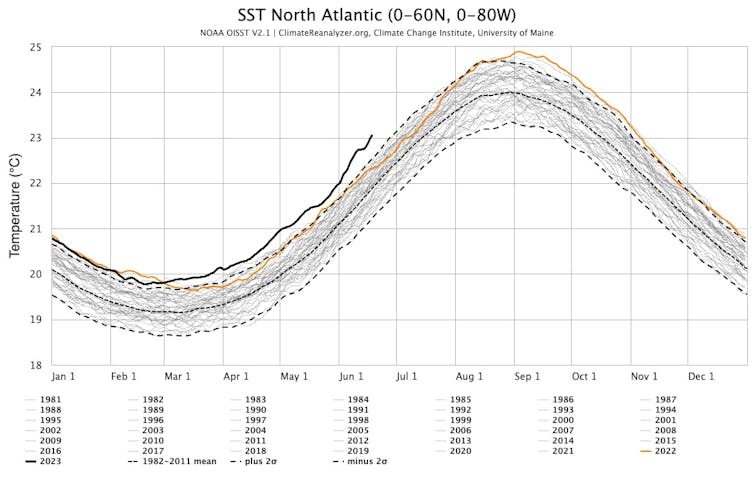
I would speculate part of the reason for these anomalously high temperatures in stratified seas is that the surface layer is shallower than usual and so the sun’s heat is more concentrated (probably a result of relatively stable weather and lack of Atlantic storms crossing the UK in the past month). As such, these already very warm areas will warm further until a sufficiently strong storm comes along and mixes the heat down into a thicker surface layer.
Fish May Go Hungry
One reason this heatwave is so significant is because those stratified seas on the continental shelf around Britain and Ireland are some of the most biologically productive on the planet. They have long been an important area for fishing cod, haddock, mackerel and other species. Those fish eat smaller fish and crustaceans, which in turn feed on microscopic plants known as plankton.
At this time of year, these plankton are dependent on nutrients mixed up from the deep water into the surface layer. However, this year, this nutrient supply may be diminished, since the very high surface temperature means there is likely stronger stratification and less mixing.
A heatwave on the surface could potentially harm the deeper ocean too, and the fish that live there. These continental shelf seas are already suffering from a decline in deep water oxygen, which is partly offset by mixing oxygen-rich water from the surface. However, the fact that the surface temperatures are so high point to a lack of mixing between the layers, and in any case, warmer water contains less oxygen.
On a slightly longer timescale, we already know that climate change is affecting these seas. Some warm water fish species are appearing in UK waters for instance, and native fish reproduction cycles and those of the plankton they feed on are no longer in perfect sync. This extreme heatwave may be a sign of further changes to come.

Don’t have time to read about climate change as much as you’d like?
Get a weekly roundup in your inbox instead. Every Wednesday, The Conversation’s environment editor writes Imagine, a short email that goes a little deeper into just one climate issue. Join the 20,000+ readers who’ve subscribed so far.![]()
Tom Rippeth, Professor of Physical Oceanography, Bangor University
This article is republished from The Conversation under a Creative Commons license. Read the original article.
Unprecedented marine heatwave underlines the urgency to clean up UK rivers and coasts
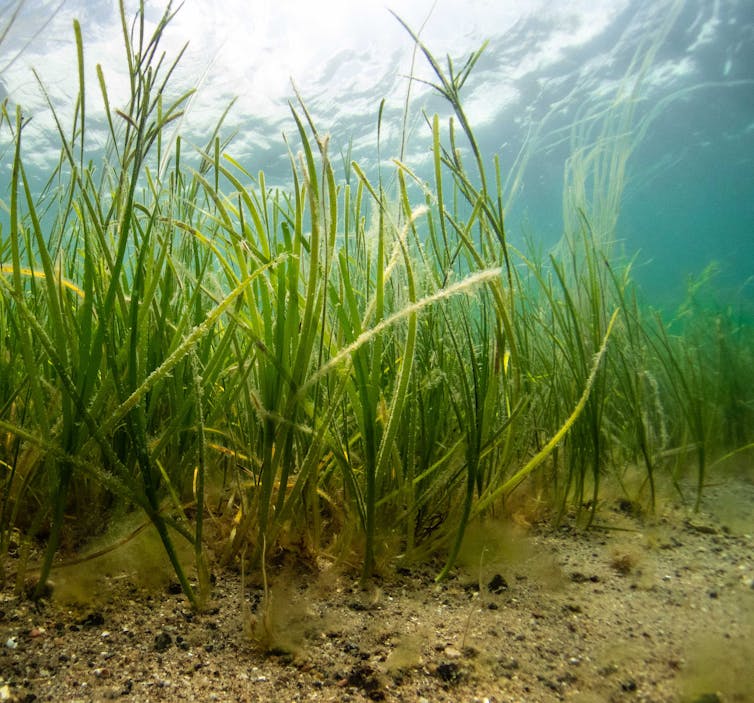
Thousands of people took to the UK’s seas and rivers recently in a nationwide “paddle-out” protest to demand an end to sewage spilling into the country’s waterways. The campaigners were largely concerned about the consequences of this filth for human health and nature.
But as the UK’s coastal seas boil under what is an unprecedented marine heatwave, these calls have new urgency. At the time of writing, some areas off the coast of England are up to 5°C warmer than usual.
The degradation of the UK’s rivers and coasts caused by pollution, coupled with the impact of marine heatwaves, poses a threat to the future of a vital coastal plant species called seagrass.
Seagrasses are plants that have adapted to live in the ocean, forming vast meadows that often span hundreds of hectares. These meadows provide habitats for marine wildlife and nurseries for commercially important species such as Atlantic cod. They also trap carbon from our atmosphere, help reduce coastal erosion and even filter harmful bacteria from seawater.
But unlike humans, plants cannot control their body heat. So higher seawater temperatures lead to increased respiration rates (the process living things use to create energy to live and grow) and a greater need for food.
A higher respiration rate is not necessarily a problem for seagrass if it has lots of light to photosynthesise effectively. The problem is that light is often limited in polluted waterways.
Stopping the flow of pollution into our rivers is no longer a luxury for another day, but an urgent necessity. Failing to clean up our water systems now will result in the loss of marine and aquatic life, undermining the functioning of our natural world.
Algal Growth
Seagrasses also need a supply of nutrients like nitrate and phosphate, without which they will be unable to grow. In UK waterways, the discharge of sewage and farming waste into rivers and streams, and the excessive use of fertilisers on the land contributes to elevated nutrient levels. However, these increased nutrient levels stimulate the growth of various types of algae in seawater, including those in the water, on seagrass leaves and on sediments.
This competition for nutrients puts seagrass at a disadvantage. Seagrasses primarily extract nutrients directly from the sediment, while algae can access them in the water more effectively.
As nutrient concentrations rise, algae populations continue to increase and form extensive blooms. The proliferation of algae turns the water green, covers the seagrass leaves and smothers the habitat. This overload of algae prevents seagrass from photosynthesising at such a rapid rate.
During a marine heatwave, seagrass experiences elevated respiration rates, which increases their need for light. In clear and healthy water, seagrasses respond by raising their photosynthetic rate to meet their additional energy requirements. However, when the water becomes overwhelmed by excessive algae growth, seagrass struggles to keep pace and eventually deteriorates.
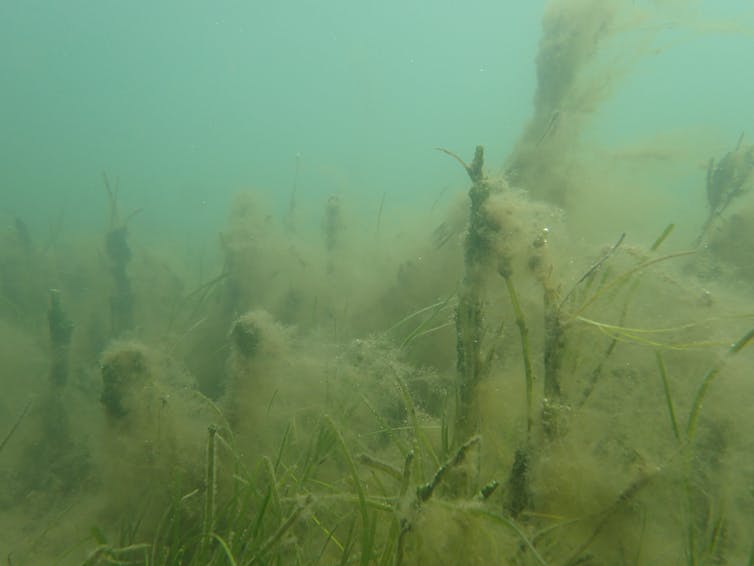
Seagrass Is Suffocating
The UK’s waterways and coastal seas are some of the most heavily polluted in Europe. Over 75% of the country’s rivers and streams contain levels of organic pollutants that are either lethal to aquatic life or have the potential to cause chronic harm.
However, nutrient pollution affects seagrass far beyond the boundaries of the UK. In 2021, one study estimated that 88% of seagrass meadows worldwide are exposed to nutrient inputs from wastewater.
Over the past two years, we’ve been documenting the health of seagrass meadows around the UK at Project Seagrass (a marine conservation charity dedicated to saving the world’s seagrass) and Swansea University. This research adds to a database initially published in 2016.
Despite being located in marine protected areas, most of the seagrass meadows we have studied are in “poor” condition. The levels of nitrogen recorded in these meadows are up to 75% higher than the global average.
By analysing seagrass leaves for nutrients, including nitrogen and a stable isotope of nitrogen called 15N, we can identify the sources of these nutrients. Notably, sewage and livestock waste exhibit higher levels of 15N compared to other nutrient sources. These results support our suspicion that the excess nitrogen found in seagrass primarily originates from sewage discharges and nutrients running off farmland.
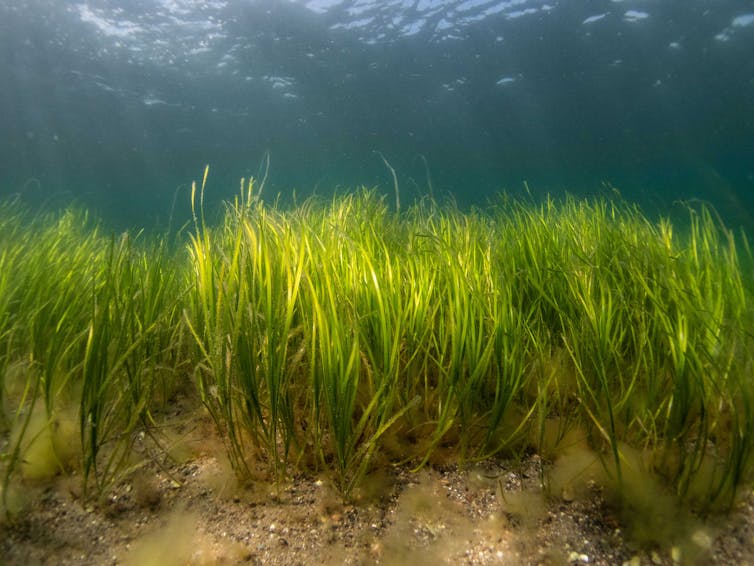
Costly Pollution
Interestingly, seagrass meadows can also play a crucial role in controlling nutrient pollution. Research has demonstrated the significant financial value of seagrass meadows in terms of their capacity to absorb and store nutrients.
For instance, a study in Sweden observed that the loss of 1,000 hectares of seagrass over a 20-year period resulted in the release of 60,000 Mg of nitrogen back into the environment. This nitrogen release was more than three times the annual nitrogen load carried by rivers to Sweden’s north-west coastline.
The economic cost associated with this nitrogen release was estimated to be over US$140 million (£110 million). This calculation accounted for the expense required to meet the nitrogen reduction targets set by the EU Water Framework Directive, which includes things like the cost of building new wastewater treatment plants.
The loss of seagrass due to more intense marine heatwaves could exacerbate the ongoing deterioration of European waters. In our view, addressing water pollution, specifically from fertilisers and sewage, is just as urgent as tackling the climate and biodiversity crises.
Although we cannot accurately predict the intensity, duration and location of severe marine heatwaves, it seems that they are becoming more frequent as our climate system collapses. The only line of defence for the natural world against the rapidly changing climate is to make species and habitats more able to resist and recover from extreme events. This will require a fundamental change in the polluting practices that currently suffocate aquatic environments.![]()
Richard K.F. Unsworth, Associate professor in marine biology, Swansea University and Benjamin L.H. Jones, Chief Conservation Officer, Project Seagrass & Postdoctoral Associate, Florida International University
This article is republished from The Conversation under a Creative Commons license. Read the original article.
Colonialism has shaped scientific plant collections around the world – here’s why that matters
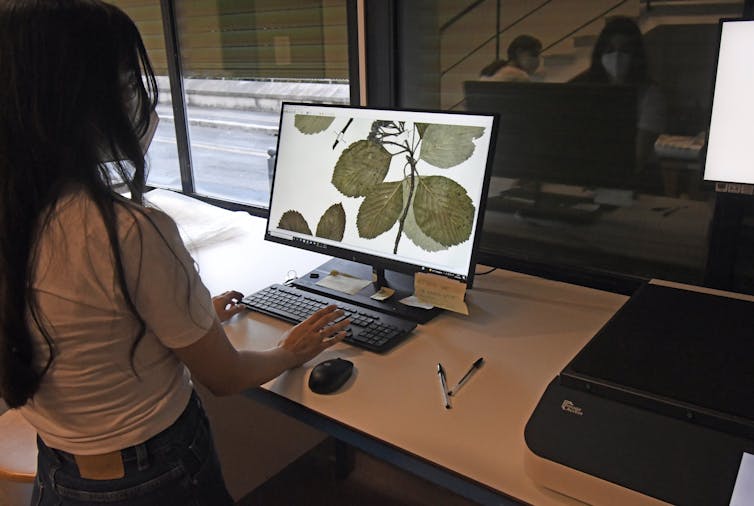
Some of the world’s most popular museums are natural history collections: Think of dinosaur fossils, gemstones and preserved animals. Herbaria – collections of pressed, dried plant specimens – are a less-known but important type of natural history collection. There are some 400 million botanical specimens stored across over 3,500 herbaria around the world, but most are not widely publicized and rarely host public exhibits.
I study biodiversity and global change, and these collections have fueled my work. My collaborators and I have used herbarium collections to study how flowering times respond to changes in climate, how dispersal traits and environmental preferences affect the likelihood that plants will become invasive, and how fires affect tropical biodiversity.
I have had easy access to specimens from every corner of the world, but most researchers are not as lucky. This is partly because herbaria as we know them today are largely a European creation. And like other natural history collections, many of them grew as imperial powers expanded their colonial empires and amassed all kinds of resources from their colonies. Today, over 60% of herbaria and 70% of specimens are located in developed countries with colonial histories.
My colleagues and I wanted to understand how many herbarium specimens are not where the plants originated and are housed in former colonizing countries instead. Our international team of researchers from herbaria on every continent analyzed over 85 million plant specimen records from the Global Biodiversity Information Facility, the largest online repository of biodiversity data, and also surveyed physical herbarium collections across the world.
We found that many former colonial powers have more plant diversity in their herbarium cabinets than they do in nature. Our data suggest that this is not the case, however, for former colonies, whose herbaria often house fewer plant species in their collections than are found naturally in the region. This disparity can limit former colonies’ capacity for botanical research.
A Persistent Colonial Legacy
Herbaria are centers of botanical discovery and research, and are critical for understanding the diversity of plants and fungi around the world. The specimens they hold were originally collected to document and classify species. Today scientists use them for additional purposes, such as reconstructing plant evolutionary history, tracking pollution trends and identifying potential new drugs.
Botany was the science par excellence of colonial empires. Botanists moved numerous living and preserved plant specimens to institutions in colonizing nations which sought to exploit their colonies’ biological resources.
For instance, physician and naturalist Hans Sloane, often credited as the inventor of chocolate milk, acquired numerous plant specimens from overseas colonies via his connections with the slave trade. His collections formed the basis of Britain’s Natural History Museum. Well-known scientists, including Charles Darwin and Carl Linnaeus and their disciples, relocated large numbers of plants from across the globe to European museums and collections.
Our analyses of online specimen records suggest that botanical collection trends over the past four centuries have been shaped by colonialism. Even though overt colonialism ended after World War II, specimens have largely continued to move from Africa, Asia and South America to institutions in Europe and North America, with a few exceptions.
Similarly, when we examined physical herbarium collections, we found that those in developed nations in the Global North that were former colonizers housed a higher proportion of internationally collected specimens on average. Herbaria in the U.S. and several European nations house specimens of over twice the number of species that naturally occur in these nations.
In nature, plant diversity is typically greatest in regions near the equator and decreases northward and southward toward the poles. Our data suggest that centuries of colonialism had the opposite effect: Plant specimens were moved away from countries with high natural plant diversity to collections in countries where fewer plant species occur naturally.
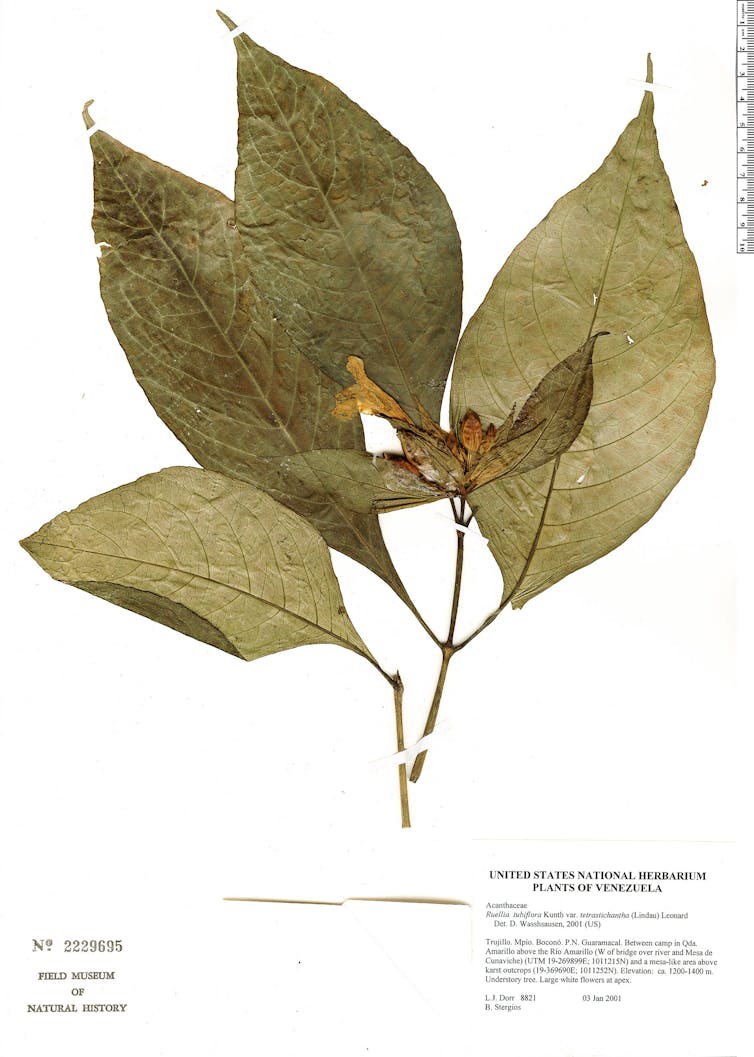
The Digital Divide
As herbaria digitize their specimens and share data online, they are becoming somewhat more decentralized and democratic. Open-access data repositories, such as the Global Biodiversity Information Facility, allow researchers from around the world to query aggregated specimen metadata and images over the internet. This reduces the need to ship fragile specimens over long distances, and to take extensive and costly research trips.
But digitization requires large investments in equipment and personnel, which small institutions and developing countries often can’t afford. Stable internet connections are not always widely available in developing countries either. Further, our survey of herbaria indicates that digitization still has a long way to go.
We estimated that in general, fewer than 30% of physical collections have information online that at least describes when and where specimens were collected, and fewer than 10% have digital images available online. Most herbaria that responded to our inquiries were located in developed countries, so these figures probably overestimate the state of specimen digitization. The disparity in access to herbarium collections exists in the digital realm as well.
Making Global Plant Collections More Inclusive
Many natural history museums and other cultural institutions are working now to address their colonial legacies. This often includes acknowledging items in their collections that were acquired unethically or illegally, and sometimes returning them to their original sources. But botanical collections have received less attention, maybe because few of them offer public displays.
Our study shows that there is a large disparity between where plant diversity naturally exists and where it is artificially housed and cataloged. As a result, many countries rely on botanical knowledge and resources housed outside of their own borders.
My colleagues and I believe that herbaria should be part of the ongoing movement to decolonize cultural institutions, natural history museums and related scientific practices. Key steps would include:
– Openly acknowledging the colonial legacy of herbarium collections, and communicating their history;
– Improving access to the vast information held in herbaria worldwide; and
– Building capacity in previously colonized countries by sharing knowledge and resources for contributing to research. These could include, for instance, supporting the local collection and study of plant diversity by providing training for local scientists.
In our view, the science that comes from botanical collections is globally relevant, so access to these resources should be within reach of the global community. Herbarium collections are critical to modern understanding of the world’s plants, and they have played key roles in numerous scientific discoveries and advances. Imagine how much more would be possible if these invaluable resources were available to all.![]()
Daniel Park, Assistant Professor of Biological Sciences, Purdue University
This article is republished from The Conversation under a Creative Commons license. Read the original article.
The world’s fish are shrinking as the climate warms. We’re trying to figure out why
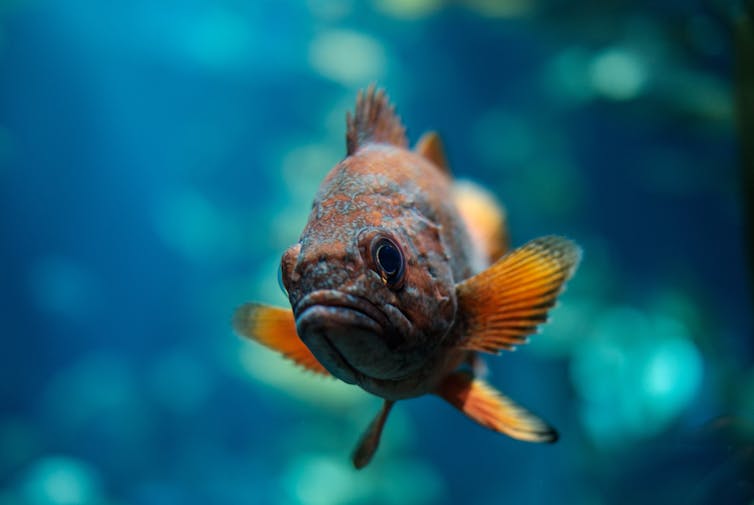
Fish are the most diverse group of vertebrates, ranging from tiny gobies and zebrafish to gigantic tunas and whale sharks. They provide vital sustenance to billions of people worldwide via fisheries and aquaculture, and are critical parts of aquatic ecosystems.
But fish around the world are getting smaller as their habitats get warmer. For example, important commercial fish species in the North Sea have declined in size by around 16% in the 40 years to 2008, while the water temperature increased by 1–2℃. This “shrinking” trend is forecasted to significantly exacerbate the impacts of global warming on marine ecosystems.
The link between warmer water and smaller size is well known, but poorly understood. Our experiments keeping fish in warmer water offer some crucial clues – and may help us learn how to prepare for a warmer future with smaller fish.
The Temperature–Size Rule
Fisheries are a potential confounding factor when studying the effect of warmer waters on fish, because fisheries often target large fish. Removing these larger fish from the population benefits the survival of fish that mature quickly and reproduce at a younger age, when they are smaller.
This trait of maturing early can be passed through fish generations. Indeed, it can lead to a phenomenon known as “fisheries-induced evolution”, where the exploited species tends to decrease in size over time.
How do we tell the difference between the impacts of climate warming and those of fisheries?
One way is to examine the body size trends in fish species that are not targeted by fisheries. Several fish species in French rivers, for example, are not exploited by fisheries but have decreased in size over several decades while their environment has grown warmer.
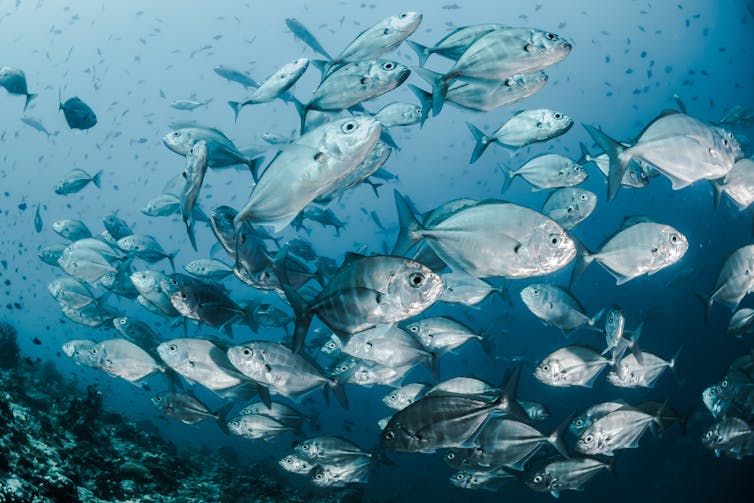
Another way is to examine fish under controlled conditions, by manipulating water temperature and studying the impact on fish size. Such experiments have shown that fish do indeed end up smaller in body size when kept under warm conditions, and the trend is so common it has been given a name: the “temperature–size rule”.
We also know that smaller fish produce proportionally fewer offspring. And if fish are shrinking, fisheries that base their catch quotas on weight will be taking a larger number of individual fish.
So shrinking fish means each fish will have fewer offspring, and more fish being caught. This is likely to have substantial ecological and commercial ramifications.
Supply And Demand
Warmer water means smaller fish, but why?
The most popular current theories suggest the cause is due to a mismatch between how much oxygen a fish needs (to sustain its body’s metabolism) and how much it can get (via its gills).
The argument is that fish gills do not grow at the same pace as the rest of their bodies. Once a fish reaches a certain body size, its gills can only supply enough oxygen to keep its body running – there is no oxygen left over for growth.
What does this have to do with warming? The next step of the argument says fish use more oxygen in warmer water – but their gills don’t get any bigger. So fish reach the limit of their growth at a smaller size, leading to the temperature–size rule.
This “oxygen mismatch” theory has sparked heated debate among global scientists, largely because insufficient data exist to confirm or refute it.
Oxygen Supply Can Keep Up With Demand
To get some data, we have carried out long-term experiments keeping fish under warmer water conditions than normal. We also tried providing extra oxygen, to see if it benefited their growth.
We have regularly taken metabolic measurements, and quantified the gill surface area of the fish to understand how well they can transport oxygen from the water into the body.

Our results show the “oxygen mismatch” theory doesn’t hold up. While the metabolism of fish does increase with warming of the water, we found the gills grow sufficiently to keep up with the increased oxygen demand as fish increase in size.
So, why then are fish shrinking as the climate warms?
Is Reproduction The Key?
We know that fish tend to grow faster in warmer conditions and reach reproductive maturity at an earlier age and smaller size. It is possible that once fish start reproducing, energy is channelled into reproduction rather than further growth.
Evidence for this comes from a population of fish living in a Swedish lagoon that gives us an eye to a warmer future, as the lagoon receives warm (non-contaminated) water from a nearby nuclear power plant.
Fish in the warm lagoon grow faster and reach reproductive maturity earlier, then they tend to die at a younger age and at a smaller body size than their counterparts living in adjacent, cooler waterways. “Live fast, die young”, as the saying goes.
While this idea seems to be broadly applicable, some conflicting findings point to the need for more focused research attention.
Fish Can’t Keep Shrinking Forever
As our understanding of the relationship between temperature and fish size increases, we would also like to know whether we can do anything about it.
In our latest research, we explored differences in growth rates between individual fish of the same species.
One thing we wanted to know was whether particular physiological traits may allow some individuals to get around the temperature–size rule and be impacted less by climate warming. We found there is significant variability across individual fish, but we don’t know how this variability could be harnessed to future-proof fish populations.
As our work continues, we also look to the future and think about the ramifications to fish and the industries that rely on them.
Fish cannot keep shrinking forever. There is a minimum size that each species must reach in order to maintain a viable population.
If species reach their specific thermal limits in particular locations, they will not be able to reproduce and they will cease to exist in those locations. If their entire habitat range becomes too warm, the species will become extinct.
These considerations of smaller fish and shifting thermal habitats will be critical for the sustainability of fisheries and aquaculture industries as we continue into a future with a warmer, more extreme climate. Our efforts to quantify and forecast the impacts will help resource managers and industries prepare for climate-linked disruption.![]()
Timothy Clark, Associate Professor - Animal Ecophysiology, Deakin University
This article is republished from The Conversation under a Creative Commons license. Read the original article.
Why does grass grow more slowly in winter?
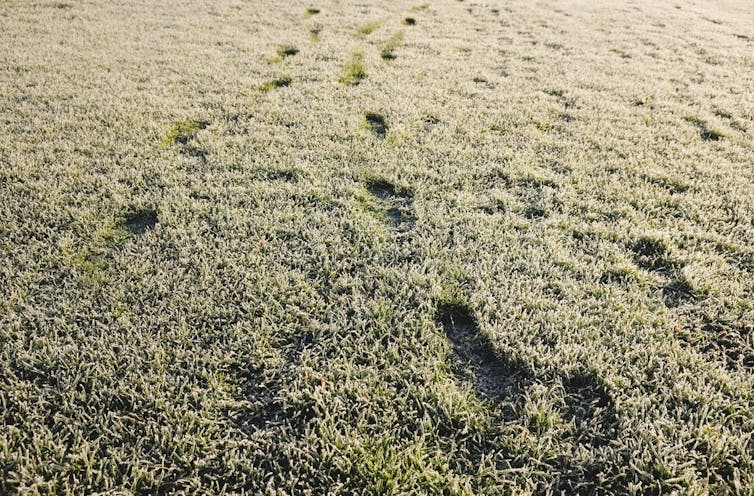
A reader of The Conversation recently wrote in to ask:
Why does grass grow slower in winter?
It is a great question and at first the answer might seem obvious. There is less sunlight and it is colder in the winter months. This affects grass and plant growth in general.
However, there is more to it than meets the eye. Different grasses respond to and cope with winter in different ways.

Grass: A Recent Arrival
Grasses are relatively recent arrivals in plant evolution, first appearing in fossil records about 65 million years ago and becoming widespread in parts of Asia by about 30 million years ago.
Geologically, and in plant evolutionary time scales, this is quite recent. It means much of grass evolution has occurred under modern geological, environmental and climatic conditions. So, more than most plants, grasses have adapted to a modern, if pre-human, world. This affects their climatic responses.
Some of our best-known grasses evolved from ancestors that first appeared on Earth hundreds of millions of years ago.
Their physiology developed to cope with an Earth that had a very different atmosphere from that of today.
These plants have a type of photosynthesis called C3 metabolism.
What Is C3 Metabolism?
C3 metabolism is about how the plant does the job of turning light, water and air into food (photosynthesis).
About 95% of all plants you can think of – trees, shrubs, annuals, fruits, vegetables and many traditional (often called cool season) grasses – have C3 metabolism.
Plants with this form of photosynthesis tend to grow well in a wide range of environmental conditions, even if the temperature is cooler and there are higher than usual levels of carbon dioxide in the air.
They tend to remain green all year round if water is available, and may continue to grow well through late autumn. Many are frost-tolerant, but they may become dormant in hot dry weather.
C3 grasses, such as ryegrass, do slow their growth for the winter months as sunlight becomes less intense. Their metabolic processes (in this case, photosynthesis) slow down when the temperature drops.
Biological reactions are chemical reactions, after all. The rate of a reaction is temperature-dependent – speeding up when it’s warmer and slowing down or even stopping when it gets colder.
But they tend to do better in winter than their cousins, the C4 grasses.
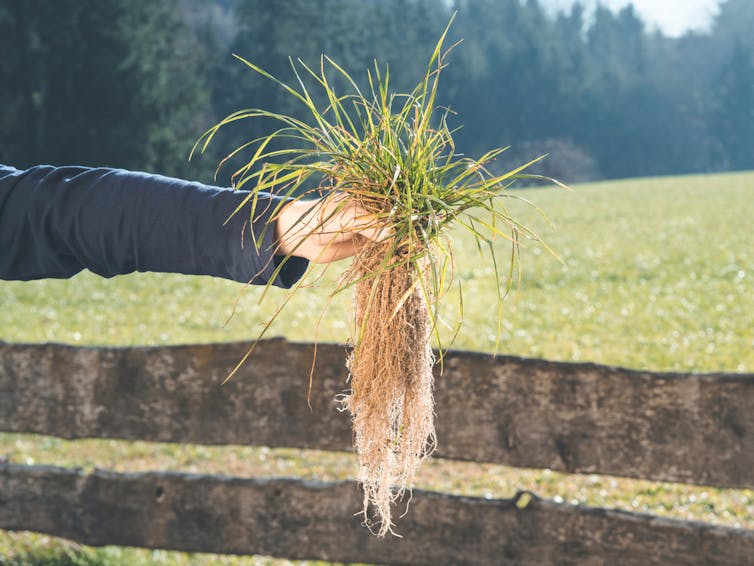
I’ve Heard Many Lawn Grasses Are C4 Grasses. What Does That Mean?
As the level of CO₂ in the atmosphere declined and geological events led to the development of tropical regions around the equator, a different group of plants evolved. These plants used a form of photosynthesis called C4 metabolism.
C4 plants grow very well under lower CO₂ levels in the atmosphere, use water more efficiently, and can cope with poor soils better than C3 grasses.
But they struggle in the cold. They grow best in warmer, wetter conditions.
While only about 5% of all plants have C4 photosynthesis, some of them are important grass species, such as:
bermuda grass
buffalo grass
paspalum
couch grass, and
zoysia grass.
So if your lawn is sown with one of these grasses, you will definitely see a slowdown in winter, when they become dormant.
Their leaves tend to turn from bright green to a dull pale green or even yellow. Their growth slows quickly and dramatically in early autumn as the light levels fall, temperatures cool and chlorophyll production starts to decline.
The upside, of course, is they usually grow very well when the weather warms up again.![]()
Gregory Moore, Senior Research Associate, School of Ecosystem and Forest Sciences, The University of Melbourne
This article is republished from The Conversation under a Creative Commons license. Read the original article.
Hungry gold miners created Victoria’s Murray cod fisheries – and we’re still dealing with the consequences
Paul Humphries, Charles Sturt UniversityIn this edited book extract, Paul Humphries describes how a proposal to feed hungry miners on Victoria’s goldfields led to a Murray cod fishery – and the collapse of cod populations, the effects of which are still with us today.
Within months of the discovery of gold in 1851 in the previously sleepy little hamlets of Ballarat, Castlemaine and Bendigo, the Victorian goldfields were out-performing those in California. By 1852, ships hailing from Melbourne were sailing up the River Thames, carrying up to 10 tonnes of gold to London.
Convicts, previously reluctant to be sent out to the colony, now begged for transportation. Immigrants from England, Europe, The United States and China arrived in Melbourne in their hundreds each day. Along with the diggers came those that supplied their wants and needs: store keepers, butchers, bakers, grocers, barbers, printers and other tradespeople. Gold, population and trade boomed.
By 1854, the Victorian population had surpassed that of New South Wales, but the amount of gold extracted, although still substantial, was half it was two years previously. Discontent increased. There were violent clashes between soldiers, police and diggers, which culminated in a full-on battle on 3 December 1854 on Bakery Hill: the Eureka uprising.
Some canny miners who saw the boom was fast fading had an eye out for business opportunities. There was another untapped, seemingly limitless resource – another type of “gold” – waiting within coo-ee of the goldfields for the right person to come along and extract it. Not from earth. From water. The cod rush was about to start.

“We Cannot Exhaust The Fish”
In the 19th century, there was by all accounts an abundance of large Murray cod, some reportedly 1.8 metres-long and weighing perhaps 80 kilograms. These long-lived predators cruised around the main channels of rivers, ate crayfish, mussels, fish and even ducks and mice when they could get them. For hungry gold miners, they must have seemed like a godsend.
In January 1855, an article in The Argus by an unnamed correspondent recorded that a semi-commercial fishery had begun in the Murray, supplying gold miners in Bendigo with fresh fish:
“The Murray abounds in splendid fish of the cod and bream species, varying in weight from an ounce to a hundred weight each,” they wrote.
The article recognised the demand for food from hungry gold miners, along with a supply of fish; the former seemingly insatiable and the latter apparently inexhaustible.
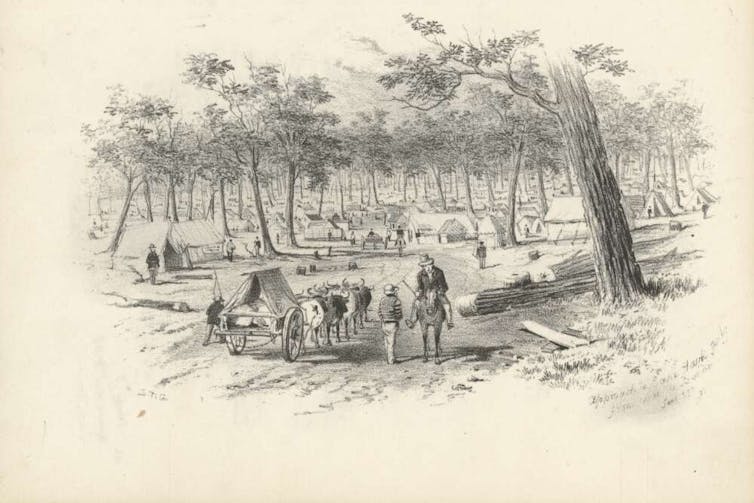
“We have a river unequalled in the colony in its magnitude. It is rich in delicious fish […] with which we intend at no distant period to cram the stomach of the rebellious digger of the Bendigo,” the correspondent wrote two months later.
By May 29th, the correspondent proposed exchanging the “superabundant” nuggets of the diggers with that of the “superfluous luxuries” in the Murray. A transparent pitch for distributing the wealth north of the goldfields. But they weren’t finished.
On 22 June 1855 in The Argus, the unnamed journalist wrote a lengthy proposal and presented a detailed business case – including estimates of outlays, profits and even methods (netting, hook and line, spearing) for catching fish that had been used by local Aboriginal peoples for thousands of years – for a commercial fishery in the Murray, supplying Bendigo.
Soon, a disillusioned miner with ambition recognised the opportunity. At the age of 27, Massachusetts-born Joseph Waldo Rice established the Lake Moira Fishing Company in mid–1855 with five others. Soon, that became the Murray Fishing Company or Murray River Fishing Company.
“We cannot exhaust [the fish],” suggested the Argus journalist, and ten times as many as they proposed could be harvested would not even deplete a small section of river.
The correspondent was grossly mistaken.
Boomtime And Collapse
In the early days, a dozen or so men fished Moira Lake and the Murray and Edward rivers nearby, transporting a few baskets of fish to Bendigo by Cobb and Co. coach.
But within a few decades, hundreds of fishermen plied their trade from Albury to Lake Alexandrina with many thousands of fish transported to Melbourne, Sydney and Adelaide markets by railway each year.
Intensive fishing, questionable practices such as taking fish during the spawning season, a lack of regulation and the later rise of recreational fishing exhausted the supposedly inexhaustible resource.
Fish stocks fluctuated over time as fishing effort rose and fell, but catches hit rock-bottom in the early 1960s and never recovered. By then, many commercial fishers had already left the industry or retired.
It was only in the early 2000s that the unprofitable fishery was finally banned in all states of the Murray-Darling Basin.
Commercial fishing was largely responsible for the decline in Murray cod stocks over many decades. But the decline was hastened by dispossession of Aboriginal peoples, habitat destruction, the construction of dams and barriers, changes to river flows, the introduction of alien fishes and declining water quality.
And the decline in Murray cod numbers would itself have had far-reaching impacts on river food webs.
The legacy of the commercial fishery is still with us today, as is the sludge still being flushed into our rivers because of gold dredging.
Will The Cod Ever Recover?
Despite widespread stocking campaigns and tight fishing regulations, Murray cod stocks were still “depleted” in the ACT and in South Australia as of 2020, and “undefined” in New South Wales and Queensland due to a lack of data. Only in Victoria were they considered “recovering”.
Across all jurisdictions, stocks are much lower than prior to European colonisation. Recovery of Murray cod stocks to pre-European levels is probably unrealistic and the recovery will be slow. But there is reason to be cautiously optimistic.
Scores of First Nations people, recreational angling and community groups, conservationists, and natural resource scientists and managers have worked hard to understand more about what makes this wonderful species tick. Many have put in place strategies to help ensure the Murray cod and many other native freshwater fish have a future.
There was a public outcry following recent mass fish kills, such as those in the Lower Darling–Baaka in 2018–19 and again in 2023. If this response is anything to go by, people care deeply about our rivers and the fish living in them.
While a commercial fishery in the Murray and its tributaries was probably inevitable following settlement, the Victorian goldrush provided the catalyst for its real beginnings and drove its early development.
The nameless Argus correspondent who started the cod rush would have never dreamt that their descendants would still be living with the consequences 170 years later.
This is an edited extract from The Life and Times of the Murray Cod, CSIRO Publishing, 2023.![]()
Paul Humphries, Associate professor in ecology, Charles Sturt University
This article is republished from The Conversation under a Creative Commons license. Read the original article.
Pittwater Reserves: Histories + Notes + Pictorial Walks
A History Of The Campaign For Preservation Of The Warriewood Escarpment by David Palmer OAM and Angus Gordon OAM
A Stroll Through Warriewood Wetlands by Joe Mills February 2023
A Walk Around The Cromer Side Of Narrabeen Lake by Joe Mills
America Bay Track Walk - photos by Joe Mills
An Aquatic June: North Narrabeen - Turimetta - Collaroy photos by Joe Mills
Angophora Reserve Angophora Reserve Flowers Grand Old Tree Of Angophora Reserve Falls Back To The Earth - History page
Annie Wyatt Reserve - A Pictorial
Avalon's Village Green: Avalon Park Becomes Dunbar Park - Some History + Toongari Reserve and Catalpa Reserve
Bairne Walking Track Ku-Ring-Gai Chase NP by Kevin Murray
Bangalley Headland Bangalley Mid Winter
Banksias of Pittwater
Barrenjoey Boathouse In Governor Phillip Park Part Of Our Community For 75 Years: Photos From The Collection Of Russell Walton, Son Of Victor Walton
Barrenjoey Headland: Spring flowers
Barrenjoey Headland after fire
Bayview Baths
Bayview Wetlands
Beeby Park
Bilgola Beach
Botham Beach by Barbara Davies
Bungan Beach Bush Care
Careel Bay Saltmarsh plants
Careel Bay Birds
Careel Bay Clean Up day
Careel Bay Playing Fields History and Current
Careel Creek
Careel Creek - If you rebuild it they will come
Centre trail in Ku-ring-gai Chase National Park
Chiltern Track- Ingleside by Marita Macrae
Clareville Beach
Clareville/Long Beach Reserve + some History
Coastal Stability Series: Cabbage Tree Bay To Barrenjoey To Observation Point by John Illingsworth, Pittwater Pathways, and Dr. Peter Mitchell OAM
Cowan Track by Kevin Murray
Curl Curl To Freshwater Walk: October 2021 by Kevin Murray and Joe Mills
Currawong and Palm Beach Views - Winter 2018
Currawong-Mackerel-The Basin A Stroll In Early November 2021 - photos by Selena Griffith
Currawong State Park Currawong Beach + Currawong Creek
Deep Creek To Warriewood Walk photos by Joe Mills
Drone Gives A New View On Coastal Stability; Bungan: Bungan Headland To Newport Beach + Bilgola: North Newport Beach To Avalon + Bangalley: Avalon Headland To Palm Beach
Duck Holes: McCarrs Creek by Joe Mills
Dunbar Park - Some History + Toongari Reserve and Catalpa Reserve
Dundundra Falls Reserve: August 2020 photos by Selena Griffith - Listed in 1935
Elsie Track, Scotland Island
Elvina Track in Late Winter 2019 by Penny Gleen
Elvina Bay Walking Track: Spring 2020 photos by Joe Mills
Elvina Bay-Lovett Bay Loop Spring 2020 by Kevin Murray and Joe Mills
Fern Creek - Ingleside Escarpment To Warriewood Walk + Some History photos by Joe Mills
Iluka Park, Woorak Park, Pittwater Park, Sand Point Reserve, Snapperman Beach Reserve - Palm Beach: Some History
Ingleside
Ingleside Wildflowers August 2013
Irrawong - Ingleside Escarpment Trail Walk Spring 2020 photos by Joe Mills
Irrawong - Mullet Creek Restoration
Katandra Bushland Sanctuary - Ingleside
Lucinda Park, Palm Beach: Some History + 2022 Pictures
McCarrs Creek
McCarr's Creek to Church Point to Bayview Waterfront Path
McKay Reserve
Mona Vale Beach - A Stroll Along, Spring 2021 by Kevin Murray
Mona Vale Headland, Basin and Beach Restoration
Mona Vale Woolworths Front Entrance Gets Garden Upgrade: A Few Notes On The Site's History
Mount Murray Anderson Walking Track by Kevin Murray and Joe Mills
Mullet Creek
Narrabeen Creek
Narrabeen Lagoon Catchment: Past Notes Present Photos by Margaret Woods
Narrabeen Lagoon State Park
Narrabeen Lagoon State Park Expansion
Narrabeen Rockshelf Aquatic Reserve
Nerang Track, Terrey Hills by Bea Pierce
Newport Bushlink - the Crown of the Hill Linked Reserves
Newport Community Garden - Woolcott Reserve
Newport to Bilgola Bushlink 'From The Crown To The Sea' Paths: Founded In 1956 - A Tip and Quarry Becomes Green Space For People and Wildlife
Pittwater Reserves: The Green Ways; Bungan Beach and Bungan Head Reserves: A Headland Garden
Pittwater Reserves, The Green Ways: Clareville Wharf and Taylor's Point Jetty
Pittwater Reserves: The Green Ways; Hordern, Wilshire Parks, McKay Reserve: From Beach to Estuary
Pittwater Reserves - The Green Ways: Mona Vale's Village Greens a Map of the Historic Crown Lands Ethos Realised in The Village, Kitchener and Beeby Parks
Pittwater Reserves: The Green Ways Bilgola Beach - The Cabbage Tree Gardens and Camping Grounds - Includes Bilgola - The Story Of A Politician, A Pilot and An Epicure by Tony Dawson and Anne Spencer
Pittwater spring: waterbirds return to Wetlands
Pittwater's Lone Rangers - 120 Years of Ku-Ring-Gai Chase and the Men of Flowers Inspired by Eccleston Du Faur
Pittwater's Parallel Estuary - The Cowan 'Creek
Resolute Track at West Head by Kevin Murray
Resolute Track Stroll by Joe Mills
Riddle Reserve, Bayview
Salvation Loop Trail, Ku-Ring-Gai Chase National Park- Spring 2020 - by Selena Griffith
Seagull Pair At Turimetta Beach: Spring Is In The Air!
Stapleton Reserve
Stapleton Park Reserve In Spring 2020: An Urban Ark Of Plants Found Nowhere Else
Stony Range Regional Botanical Garden: Some History On How A Reserve Became An Australian Plant Park
The Chiltern Track
The Resolute Beach Loop Track At West Head In Ku-Ring-Gai Chase National Park by Kevin Murray
Topham Track Ku-Ring-Gai Chase NP, August 2022 by Joe Mills and Kevin Murray
Towlers Bay Walking Track by Joe Mills
Trafalgar Square, Newport: A 'Commons' Park Dedicated By Private Landholders - The Green Heart Of This Community
Tranquil Turimetta Beach, April 2022 by Joe Mills
Turimetta Beach Reserve by Joe Mills, Bea Pierce and Lesley
Turimetta Beach Reserve: Old & New Images (by Kevin Murray) + Some History
Turimetta Headland
Warriewood Wetlands - Creeks Deteriorating: How To Report Construction Site Breaches, Weed Infestations + The Long Campaign To Save The Warriewood Wetlands & Ingleside Escarpment March 2023
Warriewood Wetlands and Irrawong Reserve
Whale Beach Ocean Reserve: 'The Strand' - Some History On Another Great Protected Pittwater Reserve
Wilshire Park Palm Beach: Some History + Photos From May 2022
Winji Jimmi - Water Maze

Pittwater's Birds
Australian Predators of the Sky by Penny Olsen - published by National Library of Australia
Australian Raven Australian Wood Duck Family at Newport
A Week In Pittwater Issue 128 A Week In Pittwater - June 2014 Issue 168
Baby Birds Spring 2015 - Rainbow Lorikeets in our Yard - for Children Baby Birds by Lynleigh Greig, Southern Cross Wildlife Care - what do if being chased by a nesting magpie or if you find a baby bird on the ground
Baby Kookaburras in our Backyard: Aussie Bird Count 2016 - October
Balloons Are The Number 1 Marine Debris Risk Of Mortality For Our Seabirds - Feb 2019 Study
Bangalley Mid-Winter Barrenjoey Birds Bird Antics This Week: December 2016
Bird of the Month February 2019 by Michael Mannington
Birdland Above the Estuary - October 2012 Birds At Our Window Birds at our Window - Winter 2014 Birdland June 2016
Birdsong Is a Lovesong at This time of The Year - Brown Falcon, Little Wattle Bird, Australian Pied cormorant, Mangrove or Striated Heron, Great Egret, Grey Butcherbird, White-faced Heron
Bird Songs – poems about our birds by youngsters from yesterdays - for children Bird Week 2015: 19-25 October
Bird Songs For Spring 2016 For Children by Joanne Seve
Birds at Careel Creek this Week - November 2017: includes Bird Count 2017 for Local Birds - BirdLife Australia by postcode
Black Cockatoo photographed in the Narrabeen Catchment Reserves this week by Margaret G Woods - July 2019
Black-Necked Stork, Mycteria Australis, Now Endangered In NSW, Once Visited Pittwater: Breeding Pair shot in 1855
Black Swans on Narrabeen Lagoon - April 2013 Black Swans Pictorial
Endangered Little Tern Fishing at Mona Vale Beach
‘Feather Map of Australia’: Citizen scientists can support the future of Australia's wetland birds: for Birdwatchers, school students and everyone who loves our estuarine and lagoon and wetland birds
Fledgling Common Koel Adopted by Red Wattlebird -Summer Bird fest 2013 Flegdlings of Summer - January 2012
Flocks of Colour by Penny Olsen - beautiful new Bird Book Celebrates the 'Land of the Parrots'
Friendly Goose at Palm Beach Wharf - Pittwater's Own Mother Goose
Front Page Issue 177 Front Page Issue 185 Front Page Issue 193 - Discarded Fishing Tackle killing shorebirds Front Page Issue 203 - Juvenile Brush Turkey Front Page Issue 208 - Lyrebird by Marita Macrae Front Page Issue 219 Superb Fairy Wren Female Front Page Issue 234: National Bird Week October 19-25 and the 2015 the Aussie Back Yard Bird Count: Australia's First Bird Counts - a 115 Year Legacy - with a small insight into our first zoos Front Page Issue 236: Bird Week 2015 Front Page Issue 244: watebirds Front Page Issue 260: White-face Heron at Careel Creek Front Page Issue 283: Pittwater + more birds for Bird Week/Aussie Bird Count Front Page Issue 284: Pittwater + more birds for Bird Week/Aussie Bird Count Front Page Issue 285: Bird Week 2016 Front Page Issue 331: Spring Visitor Birds Return
G . E. Archer Russell (1881-1960) and His Passion For Avifauna From Narrabeen To Newport
Glossy Black-Cockatoo Returns To Pittwater by Paul Wheeler Glossy Cockatoos - 6 spotted at Careel Bay February 2018
Grey Butcher Birds of Pittwater
INGLESIDE LAND RELEASE ON AGAIN BUT MANY CHALLENGES AHEAD by David Palmer
Issue 60 May 2012 Birdland - Smiles- Beamings -Early -Winter - Blooms
Jayden Walsh’s Northern Beaches Big Year - courtesy Pittwater Natural Heritage Association
John Gould's Extinct and Endangered Mammals of Australia by Dr. Fred Ford - Between 1850 and 1950 as many mammals disappeared from the Australian continent as had disappeared from the rest of the world between 1600 and 2000! Zoologist Fred Ford provides fascinating, and often poignant, stories of European attitudes and behaviour towards Australia's native fauna and connects these to the animal's fate today in this beautiful new book - our interview with the author
July 2012 Pittwater Environment Snippets; Birds, Sea and Flowerings
Juvenile Sea Eagle at Church Point - for children
King Parrots in Our Front Yard
Kookaburra Turf Kookaburra Fledglings Summer 2013 Kookaburra Nesting Season by Ray Chappelow Kookaburra Nest – Babies at 1.5 and 2.5 weeks old by Ray Chappelow Kookaburra Nest – Babies at 3 and 4 weeks old by Ray Chappelow Kookaburra Nest – Babies at 5 weeks old by Ray Chappelow Kookaburra and Pittwater Fledglings February 2020 to April 2020
Lion Island's Little Penguins (Fairy Penguins) Get Fireproof Homes - thanks to NSW National Parks and Wildlife Service and the Fix it Sisters Shed
Lyre Bird Sings in Local National Park - Flock of Black Cockatoos spotted - June 2019
Magpie's Melodic Melodies - For Children (includes 'The Magpie's Song' by F S Williamson)
Masked Lapwing (Plover) - Reflected
May 2012 Birdland Smiles Beamings Early Winter Blooms
Musk Lorikeets In Pittwater: Pittwater Spotted Gum Flower Feast - May 2020
Nankeen Kestrel Feasting at Newport: May 2016
National Bird Week 2014 - Get Involved in the Aussie Backyard Bird Count: National Bird Week 2014 will take place between Monday 20 October and Sunday 26 October, 2014. BirdLife Australia and the Birds in Backyards team have come together to launch this year’s national Bird Week event the Aussie Backyard Bird Count! This is one the whole family can do together and become citizen scientists...
National Bird Week October 19-25 and the 2015 the Aussie Back Yard Bird Count: Australia's First Bird Counts - a 115 Year Legacy - with a small insight into our first zoos
Nature 2015 Review Earth Air Water Stone
New Family of Barking Owls Seen in Bayview - Church Point by Pittwater Council
Noisy Visitors by Marita Macrae of PNHA
Odes to Australia's Fairy-wrens by Douglas Brooke Wheelton Sladen and Constance Le Plastrier 1884 and 1926
Oystercatcher and Dollarbird Families - Summer visitors
Painted Button-Quail Rescued By Locals - Elanora-Ingleside escarpment-Warriewood wetlands birds
Palm Beach Protection Group Launch, Supporters Invited: Saturday Feb.16th - Residents Are Saying 'NO' To Off-Leash Dogs In Station Beach Eco-System - reports over 50 dogs a day on Station Beach throughout December-January (a No Dogs Beach) small children being jumped on, Native birds chased, dog faeces being left, families with toddlers leaving beach to get away from uncontrolled dogs and 'Failure of Process' in council 'consultation' open to February 28th
Pardalote, Scrub Wren and a Thornbill of Pittwater
Pecking Order by Robyn McWilliam
Pelican Lamps at Narrabeen Pelican Dreamsong - A Legend of the Great Flood - dreamtime legend for children
Pittwater Becalmed Pittwater Birds in Careel Creek Spring 2018 Pittwater Waterbirds Spring 2011 Pittwater Waterbirds - A Celebration for World Oceans Day 2015
Pittwater's Mother Nature for Mother's Day 2019
Plastic in 99 percent of seabirds by 2050 by CSIRO
Plover Appreciation Day September 16th 2015
Powerful and Precious by Lynleigh Grieg
Red Wattlebird Song - November 2012
Restoring The Diamond: every single drop. A Reason to Keep Dogs and Cats in at Night.
Sea Birds off the Pittwater Coast: Albatross, Gannet, Skau + Australian Poets 1849, 1898 and 1930, 1932
Sea Eagle Juvenile at Church Point
Seen but Not Heard: Lilian Medland's Birds - Christobel Mattingley - one of Australia's premier Ornithological illustrators was a Queenscliff lady - 53 of her previously unpublished works have now been made available through the auspices of the National Library of Australia in a beautiful new book
7 Little Ducklings: Just Keep Paddling - Australian Wood Duck family take over local pool by Peta Wise
Shag on a North Avalon Rock - Seabirds for World Oceans Day 2012
Short-tailed Shearwaters Spring Migration 2013
South-West North-East Issue 176 Pictorial
Spring 2012 - Birds are Splashing - Bees are Buzzing
Spring Becomes Summer 2014- Royal Spoonbill Pair at Careel Creek
Spring Notes 2018 - Royal Spoonbill in Careel Creek
Station Beach Off Leash Dog Area Proposal Ignores Current Uses Of Area, Environment, Long-Term Fauna Residents, Lack Of Safe Parking and Clearly Stated Intentions Of Proponents have your say until February 28, 2019
Summer 2013 BirdFest - Brown Thornbill Summer 2013 BirdFest- Canoodlers and getting Wet to Cool off Summer 2013 Bird Fest - Little Black Cormorant Summer 2013 BirdFest - Magpie Lark
New Shorebirds WingThing For Youngsters Available To Download
A Shorebirds WingThing educational brochure for kids (A5) helps children learn about shorebirds, their life and journey. The 2021 revised brochure version was published in February 2021 and is available now. You can download a file copy here.
If you would like a free print copy of this brochure, please send a self-addressed envelope with A$1.10 postage (or larger if you would like it unfolded) affixed to: BirdLife Australia, Shorebird WingThing Request, 2-05Shorebird WingThing/60 Leicester St, Carlton VIC 3053.

 Shorebird Identification Booklet
Shorebird Identification Booklet
The Migratory Shorebird Program has just released the third edition of its hugely popular Shorebird Identification Booklet. The team has thoroughly revised and updated this pocket-sized companion for all shorebird counters and interested birders, with lots of useful information on our most common shorebirds, key identification features, sighting distribution maps and short articles on some of BirdLife’s shorebird activities.
The booklet can be downloaded here in PDF file format: http://www.birdlife.org.au/documents/Shorebird_ID_Booklet_V3.pdf
Paper copies can be ordered as well, see http://www.birdlife.org.au/projects/shorebirds-2020/counter-resources for details.
Download BirdLife Australia's children’s education kit to help them learn more about our wading birdlife
Shorebirds are a group of wading birds that can be found feeding on swamps, tidal mudflats, estuaries, beaches and open country. For many people, shorebirds are just those brown birds feeding a long way out on the mud but they are actually a remarkably diverse collection of birds including stilts, sandpipers, snipe, curlews, godwits, plovers and oystercatchers. Each species is superbly adapted to suit its preferred habitat. The Red-necked Stint is as small as a sparrow, with relatively short legs and bill that it pecks food from the surface of the mud with, whereas the Eastern Curlew is over two feet long with a exceptionally long legs and a massively curved beak that it thrusts deep down into the mud to pull out crabs, worms and other creatures hidden below the surface.
Some shorebirds are fairly drab in plumage, especially when they are visiting Australia in their non-breeding season, but when they migrate to their Arctic nesting grounds, they develop a vibrant flush of bright colours to attract a mate. We have 37 types of shorebirds that annually migrate to Australia on some of the most lengthy and arduous journeys in the animal kingdom, but there are also 18 shorebirds that call Australia home all year round.
What all our shorebirds have in common—be they large or small, seasoned traveller or homebody, brightly coloured or in muted tones—is that each species needs adequate safe areas where they can successfully feed and breed.
The National Shorebird Monitoring Program is managed and supported by BirdLife Australia.
This project is supported by Glenelg Hopkins Catchment Management Authority and Hunter Local Land Services through funding from the Australian Government’s National Landcare Program. Funding from Helen Macpherson Smith Trust and Port Phillip Bay Fund is acknowledged.
The National Shorebird Monitoring Program is made possible with the help of over 1,600 volunteers working in coastal and inland habitats all over Australia.
The National Shorebird Monitoring program (started as the Shorebirds 2020 project initiated to re-invigorate monitoring around Australia) is raising awareness of how incredible shorebirds are, and actively engaging the community to participate in gathering information needed to conserve shorebirds.
In the short term, the destruction of tidal ecosystems will need to be stopped, and our program is designed to strengthen the case for protecting these important habitats.
In the long term, there will be a need to mitigate against the likely effects of climate change on a species that travels across the entire range of latitudes where impacts are likely.
The identification and protection of critical areas for shorebirds will need to continue in order to guard against the potential threats associated with habitats in close proximity to nearly half the human population.
Here in Australia, the place where these birds grow up and spend most of their lives, continued monitoring is necessary to inform the best management practice to maintain shorebird populations.
BirdLife Australia believe that we can help secure a brighter future for these remarkable birds by educating stakeholders, gathering information on how and why shorebird populations are changing, and working to grow the community of people who care about shorebirds.
To find out more visit: http://www.birdlife.org.au/projects/shorebirds-2020/shorebirds-2020-program
Aussie Bread Tags Collection Points

Winter School Holidays
We're taking our Winter School holidays break - but we will be back on Sunday July 16th. There's a few items and reports running this Issue that may be of interest to you, even if we haven't overloaded your page.
We hope you all have a lovely break and have some great fun, even if it's cold!
Whether it's taking time to spot whales migrating north off our beaches, playing in a local park or heading south to go skiing or see the snow, we're sure you will all have a great time and as always we ask that you please look after yourselves and look out for each other.
NSW Health Mental Health Youth Advisory Group: Members Wanted - Paid Opportunity
NSW Health is establishing its first Mental Health Youth Advisory Group to give young people a say on child and youth mental services and help shape its work.
NSW Health want to hear from a diverse range of voices aged 16 – 24 years old who live in NSW, particularly if they have lived experience of mental health issues and feel passionate about improving the mental health and wellbeing of young people.
People are especially encouraged to apply if they are an Aboriginal young person, live with a disability or identify as LGBTIQA+.
To apply to be a part of the Advisory Group please complete the online application form.
What is the NSW Health – Mental Health Youth Advisory Group?
The NSW Health – Mental Health Youth Advisory Group will play an important role in advising NSW Health on the real-life experiences of young people living with mental health issues.
The Advisory Group is a paid opportunity for 12 diverse young people aged 16 – 24 across NSW.
We're looking for young people who have a lived experience of mental health issues and a strong interest in improving the mental health and wellbeing of young people.
The 12 member Advisory Group will provide a direct avenue of communication between young people and NSW Health on issues that are relevant to young people accessing child and youth mental health services across the state.
The Advisory Group will meet at least six times throughout the year with a mix of in-person and online meetings. In-person meetings will be held in Sydney and we will support you with travel if needed.
Who is eligible to apply for the Mental Health Youth Advisory Group?
Young people aged between 16 – 24 years of age living in NSW;
- With a lived experience of mental health issues OR
- Have struggled with social or emotional wellbeing OR
- Have accessed any child and youth Mental Health Services
About you:
- Passionate about improving mental health outcomes for young people
- Prepared to contribute to meeting discussions and communications
- Can relate, identify and connect with youth/peers
- Enjoy working in a team
- Capable of working with culturally and diverse groups
- Adhere to NSW Health values of Collaboration, Openness, Respect and Empowerment
Key dates
- 13th June 2023 – Applications Open
- 16th July 2023 – Applications Close
- Mid-July 2023 shortlisted and unsuccessful applicants notified
- 9th August 2023 – online recruitment event for shortlisted applicants. This is mandatory for all shortlisted applicants
- Late August 2023 – successful applicants from online recruitment event notified
- Early September 2023 – Unsuccessful round 1 applicants notified
- 15th & 16th September 2023 – First face to face meeting
Applications close Sunday 16th July 2023.
If you need any assistance with completing the application, please phone Josephine Ivancsik on (02) 9859 5236 or email MOH-MHYAG@health.nsw.gov.au

Applications Open For 150 Apprentice Scholarships
 Apprentices facing financial or personal hardship will be supported to undertake their trade and study through a $2.25 million NSW Government scholarship program.
Apprentices facing financial or personal hardship will be supported to undertake their trade and study through a $2.25 million NSW Government scholarship program.
Applications are now open until 21 July for the 2023 Bert Evans Apprentice Scholarships program that will support 150 people with $15,000 each to complete their training and further their career.
The scholarships support apprentices who are experiencing financial or personal hardship, demonstrate a high aptitude for vocational education and training, and are committed to their on- and off-the-job training in metropolitan and regional NSW.
The scholarship program is named in honour of the late Bert Evans AO, a passionate advocate of vocational education for more than 30 years. A total of 751 Bert Evans Apprentice Scholarships have been awarded since 2014.
These scholarships greatly assist first year apprentices to undertake their trade and study to achieve their career goals.
The NSW Government-run program offers grants of $5000 annually over 3 years to help people overcome personal barriers to finish their apprenticeships and go onto rewarding careers.
The scholarships are awarded to apprentices in NSW who have demonstrated:
- financial hardship and/or personal hardship
- capability for vocational education and training, and
- a positive attitude and application in the workplace and in off-the-job training.
Minister for Skills, TAFE and Tertiary Education Tim Crakanthorp said, “With demand for vocational education high, this year we have increased the number of Bert Evans scholarships on offer to help more apprentices through their training.
“Whether you need to purchase new tools, cover fuel or car maintenance costs, or pay for additional training courses, these scholarships have helped people overcome personal barriers to finish their apprenticeships and go onto rewarding careers.
“Apprenticeships are vital in ensuring NSW has a pipeline of skilled workers, and we want to give our apprentices a helping hand to complete their training, so they can make a strong contribution in their jobs and in the lives of their families and communities.”
Visit Bert Evans Apprentice Scholarships or phone 13 28 11 for more information and to apply.
Dorothea Mackellar Poetry Awards 2023: Optional Theme This Year 'The Winding Road'
HOW TO ENTER: https://dorothea.com.au/how-to-enter/
PLEASE SEE HERE FOR A DETAILED PDF ON ENTRY INSTRUCTIONS FOR TEACHERS AND PARENTS.
ONLINE SUBMISSION
Primary school and secondary school entries can be submitted anytime during the competition period.
1. Teacher/parent register account online *If you have already created an account, skip to step 3 and log in*
2. Check email for link to verify account and create password
3. Log in to your account
4. Purchase tier of entries *Please note we’re only able to accept credit card payments at this time*
5. Enter student details and submit poem(s) (cut and paste or type in poem content direct to the webpage)
6. Repeat step 5 for every student/individual poem.
*PLEASE NOTE: If you’re registering as an individual student, put your HOME address in your personal details and not your SCHOOL’S address! The address you list is where your participation certificate will be posted!*
Please read our Conditions of Entry here before registering for the competition.
USEFUL TIPS
Have a read of the judges’ reports from the previous year. They contain some very helpful advice for teachers and parents alike!
It is recommended for schools to appoint a coordinator for the competition.
Only a teacher/parent can complete the registration form on behalf of the student/child.
Log-in details: username is the email address and a password of your choice.
Log-in details can be given to other teachers/students for poem submission in class/at home.
Log-in as many times as necessary during the competition period.
Teachers can view progress by monitoring the number and content of entries.
Individual entries are accepted if the school is not participating or a child is home schooled. Parent needs to complete the registration form with their contact details. Please indicate ‘individual entry’ under school name and home postal address under school address.
Invoice for the entry fee will be sent to the registered email address within 2 weeks.
‘Participation certificate only’ option available for schools where pre-selection of entries has been carried out. Poems under this option will not be sent to judges, students will still receive participation certificate for their efforts.
Please read the Conditions of Entry before entering. Entries accepted: March 1 to June 30, results announced during early September.
NEED SOME INSPIRATION?
Check out our learning resources or browse the previous years’ themes and winning entries.
For more information contact our Project Officer on 02 6742 1200 or email dorothea.mackellar@outlook.com.
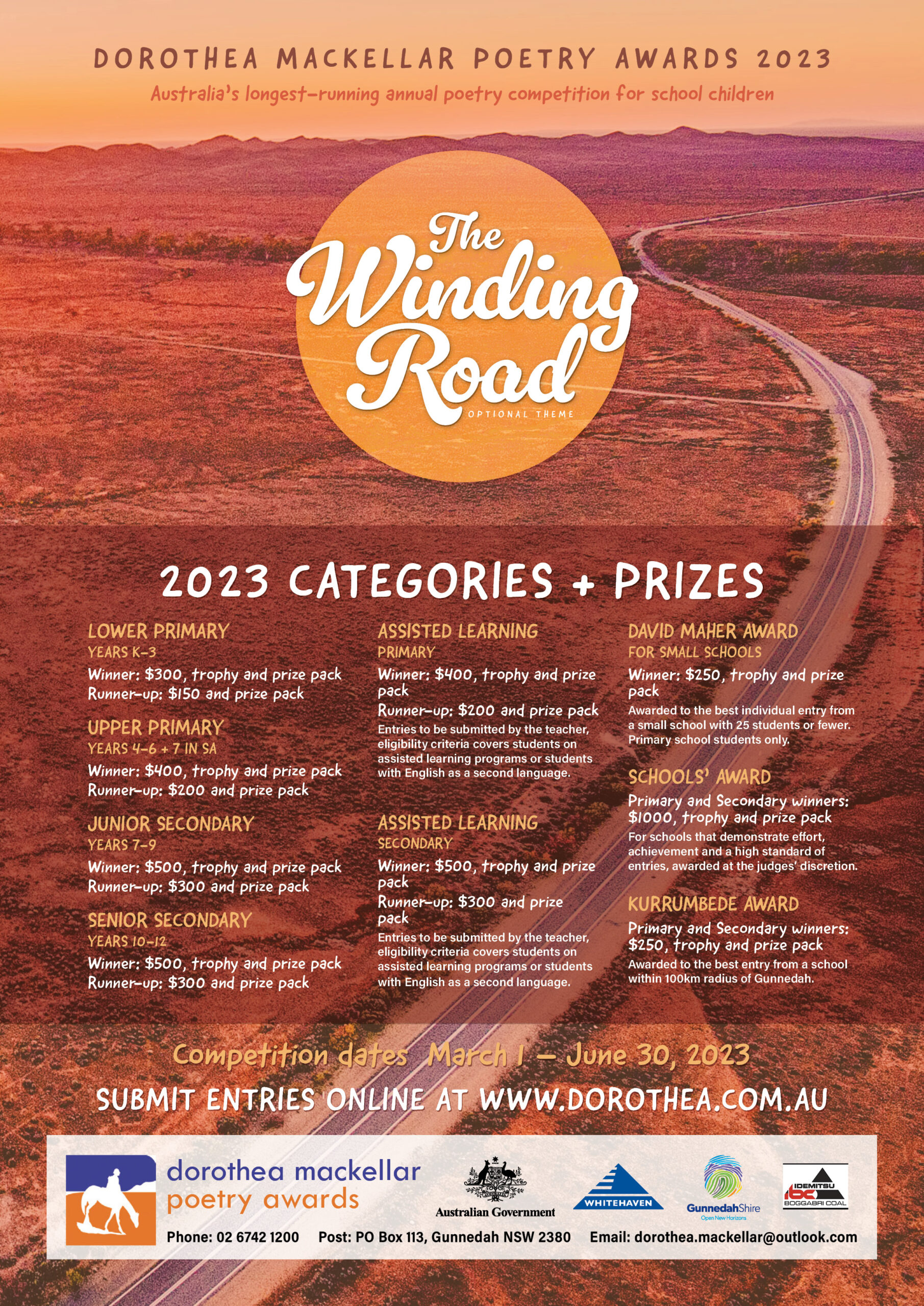
School Leavers Support
- Download or explore the SLIK here to help guide Your Career.
- School Leavers Information Kit (PDF 5.2MB).
- School Leavers Information Kit (DOCX 0.9MB).
- The SLIK has also been translated into additional languages.
- Download our information booklets if you are rural, regional and remote, Aboriginal or Torres Strait Islander, or living with disability.
- Support for Regional, Rural and Remote School Leavers (PDF 2MB).
- Support for Regional, Rural and Remote School Leavers (DOCX 0.9MB).
- Support for Aboriginal and/or Torres Strait Islander School Leavers (PDF 2MB).
- Support for Aboriginal and/or Torres Strait Islander School Leavers (DOCX 1.1MB).
- Support for School Leavers with Disability (PDF 2MB).
- Support for School Leavers with Disability (DOCX 0.9MB).
- Download the Parents and Guardian’s Guide for School Leavers, which summarises the resources and information available to help you explore all the education, training, and work options available to your young person.
School Leavers Information Service
- navigate the School Leavers Information Kit (SLIK),
- access and use the Your Career website and tools; and
- find relevant support services if needed.
Word Of The Week: Winter
noun
1. the coldest season of the year, in the northern hemisphere from December to February and in the southern hemisphere from June to August. 2. (figuratively, poetic) The period of decay, old age, death, or the like. 3. (countable, fashion) Someone with dark skin, eyes and hair, seen as best suited to certain colors of clothing. 4. (obsolete) An appliance to be fixed on the front of a grate, to keep a kettle warm, etc. 5. (India, archaic) The rainy season.
adjective
(of fruit) ripening late in the year - "a winter apple"
verb
(especially of a bird) spend the winter in a particular place.
The name comes from an old Germanic word that means “time of water” and refers to the rain and snow of winter in middle and high latitudes.
From Old English winter (plural wintru), "the fourth and coldest season of the year, winter," from Proto-Germanic wintruz "winter" (source also of Old Frisian, Dutch winter, Old Saxon, Old High German wintar, German winter, Danish and Swedish vinter, Gothic wintrus, Old Norse vetr "winter"), probably literally "the wet season," from wend-, form of root *wed- (1) "water; wet"). Cognate with Gaulish vindo-, Old Irish find "white."
‘Winter in America’ by Doug Ashdown
Douglas "Doug" Wesley Ashdown is an Australian singer-songwriter who had a minor hit in Australia with "Winter in America", so even though the lyrics speak of America, this is an Australian song as well.
Why is it so damn cold right now? A weather researcher explains
Tess Parker, Monash UniversityIf you woke up this morning and thought “Gosh, it’s a bit brisk!”, you’re not alone.
Temperatures plummeted across southeast Australia this week, with Weatherzone reporting Canberra’s low of -7.2ºC was “its lowest temperature since 2018 and the lowest for June since 1986.”
Sydney experienced its coldest June morning today since 2010, with a temperature of 5.2ºC. In Victoria, temperatures of -7.2ºC were recorded.
So what’s going on? Here’s what you need to know.
A Big Pool Of Antarctic Air
It started off at the beginning of the week, when a low-pressure system saw a big cold front come through southeastern Australia on Sunday night. This basically means a lot of very cold air came from higher latitudes close to Antarctica, and swept across southeastern Australia.
So everywhere from Melbourne to Sydney to South Australia was getting this big pool of incredibly cold air at the start of the week.
Even though that cold front has now moved off over the Tasman Sea, it has left behind it a really big high-pressure system sitting over the southeast of Australia.
This has led to calm conditions, where winds are very light and the skies are clear with not a lot of cloud during the day or night.
So it’s getting really, really cold in the early mornings because there are no clouds to act as an insulating blanket for the Earth and trap the heat that the planet radiates to space overnight.
The result, in many places, has been very cold temperatures before sunrise, often with a lot of frost.
Remind Me, What’s A Low-Pressure System? And What’s A High-Pressure System?
The air above the Earth’s surface has mass, but it’s not uniform everywhere. The way the atmosphere is moved around by what’s going on at upper levels will mean the mass of the atmosphere is redistributed. That transmits down to the surface where we live and causes low- and high-pressure systems.
At some points the pressure is lower because there’s not as much mass of air above that point over the Earth. This is what we call a low-pressure system. Air rises in a low, reducing the pressure at the surface.
The winds around the low are clockwise in the Southern Hemisphere. So when that low is approaching Australia, the winds on the western side are bringing air from near Antarctica. That’s why a low-pressure system in Australia often means cooler conditions.
At some points above the Earth, the pressure is higher because the mass of air above that area is greater. This is what we call a high-pressure system. Air descends in a high, raising the surface pressure.
High-pressure systems tend to mean very calm weather; the wind isn’t very strong, the skies tend to be clear and there’s little to no cloud.
In summer, that means the sun is baking down all day onto Earth with no protection from cloud. So a high-pressure system in summer can mean a heatwave.
In winter, the lack of cloud in a high-pressure system means that much of the heat the Earth has absorbed during the day just re-radiates out to space again, as the cloud isn’t there to act as a blanket and keep all that heat in.
That’s why a high-pressure system can mean very cold weather in winter, especially when there are lower levels of sunlight coming in to warm up the Earth in the first place.![]()
Tess Parker, Research Fellow, Monash University
This article is republished from The Conversation under a Creative Commons license. Read the original article.
Disaster, opulence, and the merciless ocean: why the Titanic disaster continues to enthral

The question on many minds this week is why did some of the world’s richest men risk death to venture to the bottom of the sea in a cold and cramped “experimental” submersible for a chance to glimpse the wreck of the Titanic?
The “unsinkable” ship that sunk on its maiden voyage across the Atlantic in 1912 after colliding with an iceberg is arguably the world’s most well-known boat. The Titanic is recognisable to more of the world’s population than, say, the Niña, the Pinta, and the Santa Maria (Christopher Colombus’s fleet that launched the Spanish conquest of the Americas), or Captain Cook’s HMS Endeavour (the tall ship that set in motion the British conquest of Australia). The Endeavour’s long-forgotten wreck was found scuttled off the coast of Rhode Island just last year.
The Titanic’s maiden voyage and calamitous end was one of the biggest news stories of 1912, and has continued to fascinate us ever since. The disaster inspired songs and multiple films in the twentieth century, including James Cameron’s 1997 epic romance, which long reigned as the highest-grossing film of all time. More recently, Titanic exhibitions that invite visitors to examine relics and explore the ship’s recreated rooms have attracted huge crowds in New York, Seville and Hong Kong.

Opulence And Immigrants
There are two reasons why we are so drawn to the Titanic, and why the super-rich are apparently willing to part with their money and even risk their lives to catch a glimpse of its broken hull.
The first is its opulence. The White Start Line that built the Titanic advertised the ship as the most luxurious ever to set sail. Wealthy passengers paid up to £870 for the privilege of occupying the Titanic’s most expensive and spacious first-class cabins. To put this 110-year-old money in perspective, when the first world war broke out in 1914, infantry soldiers in the British army were paid a basic salary of around £20 per year.

Titanic movies and exhibitions are popular because audiences enjoy the voyeurism of gazing on the ship’s beautiful furnishings, the stunning clothes worn by its rich and beautiful passengers, and their elaborate meals in fancy restaurants. First-class passengers feasted on multi-course dinners with salmon, steak, and pâté de foie gras. Chefs in Australia and around the globe occasionally recreate Titanic meals for curious clients.
Hundreds of poor immigrant passengers, represented by Jack (played by Leonardo DiCaprio) in Cameron’s movie, were also aboard the Titanic. They lived in crowded quarters and enjoyed less thrilling meals such as boiled beef and potatoes. If their ilk were the only people on board the Titanic, the ship would arguably have faded quickly from memory.
The Power Of The Sea
The fact the Titanic was touted as unsinkable also adds to its allure. The ship, whose name evoked its massive size, was engineered to cheat the ocean. When it departed England it symbolised man’s domination over nature. At the bottom of the Atlantic, it serves as a visceral reminder of the indomitable sea’s awesome power.
The same two factors - the excess of the voyage, and its defeat by the sea – are now driving the current global interest in the Titan submersible disaster. Few world events garner so much attention, including statements from Downing Street and the White House, and live news blogs from The New York Times and the Guardian.
The Titan, like the Titanic, commands our attention because of its obscenely rich passengers, who each reportedly paid US$250,000 (or between four and five times the average US salary) to visit the wreck of the famous ship that battled the sea and lost.
And then there is the intriguing mystery and power of the sea. News outlets are publishing helpful graphics that try to teach our terrestrial brains to comprehend just how deep the ocean is, and how far below the sea’s surface the Titanic and possibly the Titan lie.

The Limits Of Human Knowledge
Last night I spied Neal Argawal’s Deep Sea website circulating on social media. The site allows viewers to scroll from the sea surface to the sea floor, diving down past images of various marine animals that inhabit different oceanic depths.
At 114 metres is an orca, and 332m marks the the deepest depth a human has ever reached using SCUBA gear. It takes a lot of scrolling to descend to the Titanic almost 4,000m below the waves.
Besides gross income inequality, reflecting on the Titan and the Titanic invite us to confront just how little we can “see” of the sea in this age of mass surveillance. Not even the powerful US navy, assisted by the Canadian, UK and French governments, can muster the resources and technology required to locate, let alone rescue, the missing submersible.
As the sea seems to have swallowed yet another ship, we are reminded of limits of human knowledge and mastery over the ocean.![]()
Kristie Patricia Flannery, Research Fellow, Institute for Humanities and Social Sciences, Australian Catholic University
This article is republished from The Conversation under a Creative Commons license. Read the original article.
Of mice and matriarchs: the female-led societies of the animal kingdom

Queen Elizabeth II’s record-breaking long reign was exceptional in many ways - not least because England has been ruled by men for most of the last thousand years. Until recently, the crown was passed to the monarch’s eldest son and daughters were married off to royals in other countries.
But in most other social mammals, females commonly remain and breed in their birth groups, inheriting the status and territory of their mothers while sons leave to find unrelated partners elsewhere. Social relationships between resident females vary but are often supportive. For example in African elephants, females assemble in family groups and older females are usually dominant over younger ones.
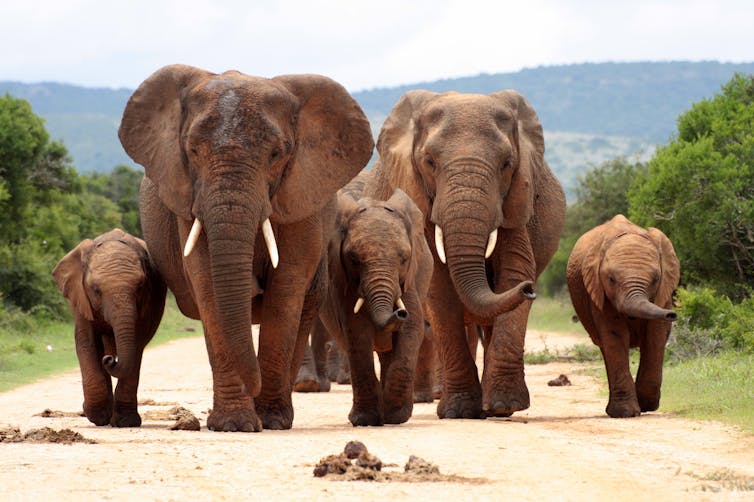
Overt competition is rare and relationships between matriarchs and younger females are relaxed and supportive. Elephant matriarchs act as reservoirs of information about where to find food and water and their presence is particularly important in times of famine or drought.
Where species live in larger groups that include members of several families, as in yellow baboons and spotted hyenas competition for status and resources can be more common and females often support close relatives in clashes with other families.

Daughters frequently inherit their mother’s social rank. All members of some families may be consistently dominant to others, often enjoying higher breeding success and survival as a result.
Murderous Mothers
But females aren’t always tolerant or supportive. In the meerkats that I have studied in the Kalahari Desert in southern Africa for the last 30 years, one dominant female monopolises breeding in each group, producing up to three litters a year for up to ten years. Their daughters and sons initially remain in their mother’s group and help to feed and protect their younger siblings.
Queens go out of their way to prevent their daughters from breeding successfully. Early in my career, I was astonished to see one of my favourite meerkat queens emerge with blood on her muzzle from her group’s sleeping burrow, where her eldest daughter had just given birth.
This meerkat queen was pregnant at the time. She went back down and soon emerged with a dead pup that was still warm – then returned and brought up three more pups that she had just killed.
My team’s later work showed that one of the most common causes of pup death was infanticide by pregnant females and studies of several other social mammals have revealed similar trends.
Killing your own grandchildren may not sound like a recipe for evolutionary success, but it often makes sense for pregnant female meerkats. If groups can only rear a small number of pups, queens will increase their genetic contributions to future generations if they suppress pups that will compete with their own offspring.
Daughters share 50% of their mother’s genes while grandchiLdren only share 25%, so it is in the queen’s best interests to make sure that their groups raise their daughters rather than their granddaughters.
When the daughters of meerkat queens are three to four years old, they become potential rivals to the queen and she evicts them from her group. As members of other meerkat groups don’t allow emigrating females to join them, evicted females either found new groups with wandering males or (commonly) die in the attempt.
When a queen eventually dies, the other females in her group fight to inherit her position. The oldest and heaviest female usually wins, taking over the queen’s status, breeding role and territory before starting to evict her sisters.
Walkabout Sons
And what about the queen’s sons? In most mammals, mating with a close relative creates weaker and less healthy babies and reduces the breeding success of females. So female meerkats avoid mating with their sons, brothers and other relatives.
Males are usually less particular about who they mate with because they do not pay the same costs of raising young. However, where the females in their group are relatives and won’t mate with them, they need to leave their birth groups to find willing partners.
Unlike females, male meerkats voluntarily go walkabout, either replacing males in other groups or shacking up with evicted females and attempting to found new groups. A similar tendency for females to avoid breeding with close relatives and for males to leave their birth groups to find willing partners elsewhere is common in many other mammals - including many species where males are substantially larger and stronger than females, like lions and baboons.
Contrasts In Succession
But females don’t always stay at home - and males don’t always wander. There are some mammals where the situation is reversed. These include a number of bats, horses, monkeys - and all three African apes. For example, female gorillas often leave their birth groups to breed in other groups while males may stay and breed there, inheriting the breeding position from their fathers.
A feature of many these species is that resident breeding males or groups of related males hold their positions for relatively long periods – longer than the age at which most females reach sexual maturity. So one explanation is that females need to leave their birth groups to find unrelated breeding partners. Males in these species don’t need to leave as immigrant females willingly mate with them.
A preference for male succession is widespread in many human societies and is often attributed to the need for monarchs to be battle leaders and the greater strength and fighting ability of males.
However, African apes are our closest living relatives and they all form groups where females leave but males remain. This suggests dispersing females and resident males may have been the ancestral norm in hominin societies too. If so, it may be because females dispersed to avoid inbreeding, rather than because of differences in strength and fighting prowess between the sexes.![]()
Tim Clutton Brock, Professor of zoology, University of Cambridge
This article is republished from The Conversation under a Creative Commons license. Read the original article.
Why is the sky dark at night? The 200-year history of a question that transformed our understanding of the Universe

As dawn rose over the German city of Bremen on May 7 1823, Heinrich Olbers put the finishing touches to an article that left his name in history. After the deaths of his wife and daughter, Dr Olbers had recently given up his work as an opthalmologist to devote himself to his nocturnal passions: the stars, the Moon, meteorites and comets.
Like many of his peers, Olbers trained himself in astronomy. He gained a solid reputation in the academic world and spent long nights observing the sky from the observatory on the second floor of his house.
On that morning, Olbers had come to a strange conclusion: based on all that was known about the Universe at that time, the night sky should not have been dark. In fact, the entire heavens should have been glowing as brightly as the Sun.
Olbers was not the first to note this paradox. But his name is the one we attach to it today. The enigma of the night sky’s darkness has echoed down the centuries from Olbers and the poet Edgar Allan Poe to 20th-century astronomers and space probes today.
Finite Light In An Infinite Universe
Like many of his contemporaries, Olbers followed Isaac Newton and René Descartes in believing the Universe was infinite.
If the Universe were finite and static, the force of gravity should draw all the stars together at a central point. But if the Universe stretched on forever, gravitational forces would on average be balanced in all directions.
But Olbers realised this model of the cosmos was inconsistent with observations. In a limitless Universe filled with an infinite number of stars, wherever we look at night our gaze should land on the surface of a star, in much the same way as every line of sight in a forest ends at a tree.

This is the problem Olbers raised in his paper of May 7 1823: the cosmological model of the time suggested every point in the sky should be as bright as the surface of the Sun. There should be no night.
Olbers proposed a solution: the light from more distant stars was absorbed by dust or other material floating in space. The English astronomer John Herschel later pointed out this couldn’t be right, because anything absorbing that much light would eventually heat up enough to glow.
When Olbers died on March 2 1840, at the age of 81, the riddle we know today as Olber’s paradox was unsolved.
A Poet’s Intuition
Eight years later, on the other side of the Atlantic Ocean, poet and writer Edgar Allan Poe thought he had found an answer. On February 3 1848, he gave a public lecture about his ideas to 60 people at the New York Society Library.
Veering between metaphysics and science, Poe argued the cosmos had emerged from a single state of matter (“Oneness”) that fragmented and dispersed under the action of a repulsive force.
This meant the Universe was a finite sphere of matter. If the finite universe is populated by a sufficiently small number of stars, then we won’t see one in every direction we look. The night can be dark again.
Even if we assume the Universe is infinite, if it began at some point in the past then the time taken by light to reach us would limit the size of the amount of the Universe we can see. This travel time would create a horizon beyond which distant stars would remain inaccessible.
Poe’s audience at the New York Society Library did not give him the rapturous reception he had hoped for. Later the same year, he published his theories in the prose poem Eureka, which was little circulated.
The following year, on October 7 1849, Poe died at the age of 40. It would be more than a century before scientists confirmed his intuitions about the enigma of the dark night sky.
Two And A Half Facts
In the first half of the 20th century many new theories of the cosmos were developed, spurred on by Einstein’s theory of general relativity, which explained gravity, space and time in new ways. In the second half of the century, these cosmological theories began to be tested with observations.
In 1963, British astronomer Peter Scheuer argued that cosmology was based on only “two and a half facts”:
- fact 1: the night sky is dark, which had been known for some time
- fact 2: galaxies are moving away from each other, as shown by Hubble’s observations published in 1929
- fact 2.5: the content of the Universe is probably evolving as cosmic time unfolds.
Strong controversies on the interpretation of facts 2 and 2.5 agitated the scientific community in the 1950s and 1960s. Was the Universe essentially stationary, or had it begun in an enormous explosion – a Big Bang? Supporters of both sides conceded, however, they needed to explain the darkness of the night sky.
The Lifetime Of Stars
British cosmologist Edward Harrison resolved the conflict in 1964. He showed that the main factor determining the brightness of the night sky is actually the finite age of the stars.
The number of stars in the observable Universe is extremely large, but it is finite. This limited number, each burning for a limited time, spread over a gigantic volume, lets darkness manifest itself between the stars.
Harrison later realised this solution had already been proposed not only by Edgar Allan Poe, but by British physicist Lord Kelvin in 1901.
Observations in the 1980s confirmed the resolution proposed by Poe, Kelvin and Harrison. Olber’s paradox had finally been put to rest.
Fossil Light
Or perhaps not quite. Viewed from a different angle, there is another resolution to the paradox: the night sky is not actually so dark after all.
After the discovery of the expansion of the Universe in the late 1920s, scientists realised the Universe could have started off extremely compact, dense and hot. This is the “hot Big Bang” model we have today.
One core prediction of this model is the existence of “fossil light” released in the cosmic dawn. This fossil light should be observable today – but not with the naked eye, as the expanding Universe would have shifted it to longer wavelengths.

This radiation – the cosmic microwave background – was detected in 1964. Now measured with exquisite accuracy, the cosmic background radiation is the most common light in the Universe.
We now know the cosmos is also illuminated by a second, much fainter background light, produced by galaxies as they form and evolve. This light is referred to as the cosmic ultraviolet, optical and infrared background.
So we can also answer Olber’s paradox by saying the sky is not dark, but faintly glimmers with the dim relic radiation of all that has been over the finite lifetime of the Universe.
New Answers, New Questions
In 2023, Olber’s paradox has evolved into a rich field of research. In our own work, we carry out ever-more precise measurements of the brightness of the night sky, and simulate the stars of the cosmos with supercomputers. We can now determine the number of stars in the sky with great accuracy.
Nevertheless, puzzles remain. Last year the New Horizons space probe, out beyond the orbit of Pluto and away from the dust of the inner Solar System, found the sky is twice as bright as we expected it to be.
And so the question of the darkness of the sky lives on, crossing ages and cultures.![]()
Jonathan Biteau, Maître de conférence en physique des astroparticules, Université Paris-Saclay; Alberto Domínguez, Investigador en Astrofísica, Universidad Complutense de Madrid; David Valls-Gabaud, Astrophysicien, Directeur de recherches au CNRS, Observatoire de Paris; Hervé Dole, Astrophysicien, Professeur, Vice-président, art, culture, science et société, Université Paris-Saclay; José Fonseca, Assistant Research, Universidade do Porto; Juan Garcia-Bellido, Catedratico de Fisica Teórica, Universidad Autónoma de Madrid, and Simon Driver, ARC Laureate Fellow and Winthrop Research Professor at the International Centre for Radio Astronomy Research, UWA., The University of Western Australia
This article is republished from The Conversation under a Creative Commons license. Read the original article.
English philosophers thought they had sloughed off the dead weight of history, but history suggests otherwise

Nikhil Krishnan’s intriguing and charming history, A Terribly Serious Adventure: Philosophy at Oxford 1900-60, is organised around anecdotes rather than arguments. Krishnan is interested not only in “what people thought but what they were like”.
The two questions are not as separate as many assume: a penetrating portrait of a philosopher can do much to illuminate their thought.
Review: A Terribly Serious Adventure: Philosophy at Oxford 1900-60 – Nikhil Krishnan (Profile Books)
The range of thinkers surveyed is quite broad. Krishnan’s history includes R.G. Collingwood, Gilbert Ryle, Isaiah Berlin, A.J. “Freddie” Ayer, J.L. Austin, Elizabeth Anscombe, Iris Murdoch, Peter Strawson and Bernard Williams. The portraits are for the most part sympathetically drawn, though naturally some of these philosophers have captured Krishnan more than others, Ryle and Austin especially.

Krishnan’s tale is one of belated modernisation – a shift from a philosophical approach with a philological and historical focus to one that is anti-authoritarian and ahistorical. He portrays the old ways at Oxford in broad strokes, evoking an institution dominated by backward- and inward-looking men, all narrowly obsessed with the classical period of Greek antiquity, particularly the dialogues of Plato.
This cloistered world finally gave out under pressure from an intransigent reality. Though the first changes came from within, via Oxford figures such as John Cook Wilson and H.A. Prichard, developments accelerated with the arrival of a younger generation increasingly interested in philosophical developments elsewhere, particularly Cambridge and Vienna.
Slaying The Hegelian Dragon
The prime mover at Cambridge had been G.E. Moore, whose example brought on a spate of conversions at the turn of the century. His colleague Bertrand Russell wrote:
It was towards the end of 1898 that Moore and I rebelled against both Kant and Hegel. Moore, first, and I closely following him, climbed out of this mental prison and found ourselves again at liberty to breathe the free air of a universe restored to reality.
Both Russell and Moore had been under the spell of the Hegelian philosopher J.M.E. McTaggart. Their apostasy is a central origin story of analytic philosophy: slaying the Hegelian dragon and sloughing off the dead weight of history.

Some of those at Cambridge, like Maynard Keynes, spoke of the conversion in religious terms. But Moore’s new method was embraced not as a re-conditioning, but a de-conditioning. Converts thought they were now unencumbered by any particular way of seeing. In the words of Leonard Woolf, Moore had “suddenly removed from our eyes an obscuring accumulation of scales, cobwebs, and curtains, revealing for the first time to us, so it seemed, the nature of truth and reality”.
This desire to strip back the encrustation of traditional assumptions and reach bare nature is a recurring theme in philosophical history. The two best known examples are Socrates and Descartes. Moore’s followers thought he had finally pulled off this coup. Lytton Strachey wrote to Moore of his book Principia Ethica (1903):
It has not only wrecked and shattered all writers on ethics from Aristotle and Christ to Herbert Spencer and Mr. Bradley, it has not only laid the true foundation of Ethics, it has not only left all Modern Philosophy bafouée – these seem to me small achievements compared to the establishment of that Method which shines like a sword between the lines […] The truth, there can be no doubt, is really now upon the march. I date from October 1903 the beginning of the Age of Reason.
What was that method? In short, it was a matter of avoiding muddles. According to Woolf, all Moore demanded of his followers was “to make quite certain that we knew what we meant when we made a statement”.
This emphasis on explicitness and precision were, and remain, two defining traits of analytic philosophy.
Plain Common Sense
Woolf wrote that while McTaggart “seemed to have entirely left the earth for the inextricably complicated cobwebs and O altitudos of Hegelianism”, Moore had his feet firmly planted on the ground and spoke with the “divine voice of plain common-sense”.
The intellectual sobriety, the return from the spiritual heights, was admired as a gritty, secure way forward. Under Moore’s influence, Cambridge philosophy became deeply suspicious of anything loose and lofty; its task was to proceed at a testudineous pace on solid ground. Though it took some time to spread, this sensibility would eventually breach the “dreaming spires” of Oxford.
J.L. Austin, who is given the most space of any thinker in Krishnan’s history, declared “Moore’s my man”. His work refined and extended Moore’s project.

Rather than deferring to common sense, Austin directs our attention to common language. In particular, he argued that we should distrust distinctions dreamed up by philosophers and instead pay attention to our “common stock of words”. He thought that while ordinary language was not an infallible guide to reality, it was much more likely to be truth-tracking than the jargon of academics.
Moore’s influence was exerted through his personal example, but also through his editorship of the premier philosophy journal Mind. When Oxford philosophers created the journal Analysis, it was modelled on Mind, only with a focus on even tighter, more honed papers. A paradigmatic Analysis essay is Edmund Gettier’s Is Justified True Belief Knowledge? (1963), which claims to debunk a long-held analysis of the concept of knowledge in just three pages.
Considering only those questions which admit precise formulation and clear answers requires setting aside many of the traditional humanistic concerns of philosophy. But Krishnan is keen to establish that this is not (or not merely) a shift to the scientistic. He argues that the rigour of this philosophical approach has a deeply edifying aspect.
Bringing people down to earth can be for their own good. It frees them from the seductions of apparent profundities, which lurk unquestioned behind a veil of ineffability. On Krishnan’s reading, the deflationary approach creates a kind of freedom within the constraint of careful, stepwise reasoning.
This is quite true, and Krishnan is right to emphasise it, given that “the fear of depth produced a culpable failure to appreciate what was deep in the Oxford tradition itself”. The apparent impersonality of analytic philosophy has concrete effects on its practitioners – here, too, philosophy is a way of life.
Many of the tradition’s major figures realised this. Austin, for example, wrote that “we are using a sharpened awareness of words to sharpen our perception of, though not as the final arbiter of, the phenomena”.
But the point was generally left unstated, and Krishnan’s view is that the analytical tradition has proved edifying precisely because it has not overtly tried to be.
Accents Of Infallibility
There was also a less attractive side to the analytical tradition. To his credit, Krishnan attends to it in some detail.
Keynes, who had seen the Moorean revolution as “the beginning of a renaissance, the opening of a new heaven on a new earth”, wrote that its upshot was quite different. “In practice,” he observed, “victory was with those who could speak with the greatest appearance of clear, undoubting conviction and could best use the accents of infallibility.” He recalled Moore responding to remarks
with a gasp of incredulity – Do you really think that, an expression of face as if to hear such a thing said reduced him to a state of wonder verging on imbecility, with his mouth wide open and wagging his head in the negative so violently that his hair shook. Oh! He would say, goggling at you as if either you or he must be mad; and no reply was possible.
Austin, too, mastered the “accents of infallibility”. Stuart Hampshire observed that it was a feature of analytical philosophy that ideas should always be discussed in a way that was
very quiet and if possible ironical or at any rate unexcited and unrhetorical […] Austin carried this to an extreme. Even the most solemn questions, solemn in their associations, had to be disinfected by a very calm, committee man’s tone of voice.
This is a little misleading. Constraint of one’s emotional register is as much a part of classical rhetoric as giving it free rein. The ability to affect a “committee man’s tone of voice” is a rhetorical skill; it enables one to make others appear absurd for any show of pathos.
Austin’s mastery of his “calm and measured” voice was so acute, according to Krishnan, that he was able to wield it to similar effect as “the birch on the insubordinate young”. To chasten, to subdue, to silence were among the many things Austin knew how to do with words.

The Austinian Superego
Austin’s need to dominate and win arguments conflicted with his ostensibly anti-authoritarian philosophical project. Krishnan writes of the “absence of adversarialism” in Austin’s Saturday-morning discussion group. But he also makes it clear that this was only so long as everyone agreed with Austin.
Invitations were handed out to those of “relative youth and juniority (professors were pointedly not invited)”. Krishnan presents this as liberating, but it could equally have been to preserve Austin’s dominance. One participant said of these Saturday meetings that “it was always just a little as if the headmaster were present”.
Austin could only admit he was wrong “once he had had the chance to sleep on it and could point it out himself, in his own way, without any concession that anyone else had got one over on him”.
To say that Austin “really should have been better at conceding a point” is a mild censure. His method of rule was that of the manager, rather than the magus or maestro. Krishnan never contrasts Austin’s philosophical views with Wittgenstein’s in any detail, but he does frequently contrast their manner of teaching. Whereas Austin had a “co-operative ideal of philosophy”, Wittgenstein created a “stifling atmosphere”, in which students acted as if they were in the presence of a “candidate for canonisation”. They learned to imitate the “accents of agony” of their “mage-like” master:
young men from across the oceans, born decades after he died, have been observed clutching their skulls in poses of agony, combing the vintage shops for open-necked shirts in just the right 1940s style, and cultivating the slightest hint of a Viennese cadence.
No one, by contrast, has found much inspiration in Austin’s “liking for sound preparation and [his] disapproval of sloppy work and lazy efforts”.
This is a little facile, and contradicted by Krishnan’s claim that “an entire generation of philosophers spoke in [Austin’s] voice”. His discussion of Austin is far from hagiography, but it does elide an issue that is both deep and of enduring relevance.
Bernard Williams observed that Austin’s “terrible voice” was internalised by those around him. Krishnan alludes to this when he says that the Oxford philosophers’ “intellectual consciences” came to speak in Austin’s voice, but he does not take up Williams’ (I think profound) criticism here. Williams claimed that this “Austinian superego” – and in particular its mania for precision – has “killed more philosophical talents at this university than you’ve had hot dinners”. People birched themselves with Austin’s voice.
Williams’ point is that there are legitimate ways of doing philosophy that are silenced by a voice that always demands “what precisely do you mean by that?” For many, the practical upshot was that “the pen fell flaccidly from [their] hand and nothing was created”.
Williams was discussing his close friend Isaiah Berlin. He argued that Berlin’s decision to quit philosophy in favour of the history of ideas was the result of Austin’s influence. Berlin claimed he was convinced by Henry Sheffer that the only areas of philosophy capable of progress were logic and psychology. According to Williams, it was really because Berlin was, like others, “unduly terrorised by Austin”.
Krishnan touches on this, saying that the reason Berlin “left philosophy” was that he “was never entirely at home in the sorts of things Oxford philosophy was increasingly about”. In truth, Berlin left neither Oxford nor philosophy. He kept doing what he had long been doing; he just stopped calling it “philosophy”. It was the conception of what counted as philosophy that had narrowed.

Krishnan takes Berlin at his word, but fails to consider the internal evidence against it. Take, for instance, one of only two works by Berlin that Krishnan mentions: his famous essay Two Concepts of Liberty. Krishnan calls the essay “a masterpiece of Cold War rhetoric”, and summarily dismisses its central distinction between “postive” and “negative” liberty. More importantly, he overlooks that it is a piece of meta-philosophy.
At the outset, Berlin reproves philosophers who “neglect the field of political thought” because “its unstable subject-matter, with its blurred edges, is not to be caught by the fixed concepts, abstract models and fine instruments suitable to logic or to linguistic analysis”. He criticises the demand for “a unity of method in philosophy”, which leads people to “reject whatever the method cannot successfully manage”.
To look only at that which admits of precision is to court naivety about many phenomena which remain intractably vague.
Krishnan also overlooks that the essay praises the political thought of, among others, T.H. Green and F.H. Bradley – that is, the work of those apparently slain Idealist bogies of Oxford’s past.
The upshot of Berlin’s sense of incommensurable values is, as Krishnan says, that “not all good things come together”. Our habits of attention, our ways of looking, affect what we see. To look at things historically is to reveal a very different world than to look at them analytically. Berlin’s argument for pluralism is not merely in favour of liberal democracy, but liberal philosophy.
Williams argued that Austin worked in the manner he did “because that was what he was good at doing.” It was a matter of sensibility.
Berlin knew he did not have the constitution to be a “first-rate” analytic philosopher; he equally knew he was not a first-rate historian. He was far too little the careful scholar and pedant for the latter, and far too worldly for the former. He was also, in a sense, too unoriginal. As Krishnan puts it, Berlin was “dependent on the provocations of earlier writers to set his pen going”.
On this view, the “true philosopher” is one whose ideas are not born of historical understanding, however perspicuous that understanding might be. Yet the quality of Berlin’s thought is obvious, even if it is difficult to say exactly what he was first-rate at.
I am tempted to reach for Wittgenstein’s phrase “that kind of understanding which consists in ‘seeing connections’.” But no doubt that just won’t do.
A Historical Turn
All sensibilities have their limits. As Nietzsche put it, none of us can “look around our own corner”.
However broad his intellectual tastes, Berlin could not see much value in studying Nietzsche. Similarly, Krishnan struggles to see the philosophical appeal of Berlin – a thinker whose style of speech he describes as “allusive and incontinent”. Though he maintains an impartial tone throughout this book, Krishnan has shown his hand elsewhere, arguing that Berlin’s “sentences, for all their rhetorical virtues, left behind at most a mood”.
Krishnan is right when he says that how people react to a thinker “mark[s] a deep difference between temperaments”. But it is complacent to present the difference here as between those seduced by “rhetoric” and those unimpressed with the arguments.
Berlin belongs to (and influenced) a group of philosophers that includes Bernard Williams, Alasdair MacIntyre and Charles Taylor. Each member of this group was to some extent influenced by Collingwood, another Oxford thinker given short shrift by Krishnan.
Perhaps because Collingwood is presented as a throwback to the Oxford Idealist past, Krishnan fails to see that Collingwood has been instrumental to an increased awareness of the importance of history within analytical philosophy itself. Some have even claimed the tradition has undergone a “historical turn”.
I hope this is true, though the number of “turns” scholars have described of late make the tradition sound like a whirling dervish. From my own experience, a historical interest continues to be regarded by most professional philosophers as somewhere between a tolerably mild eccentricity and an unhealthy diversion.
Given the historical nature of Krishnan’s book, it is something of a surprise to find echoes of anti-historical sentiment:
There is no defense for ignorance and porcine insensitivity, except those things can be, unwittingly, agents of intellectual emancipation from the weight of tradition. It was perhaps a shame that Oxford undergraduates weren’t required to read [Plato, Aquinas, Spinoza, Pascal, Leibniz, Comte, Hegel, Schelling, Fichte, Schopenhauer, Marx, Nietzsche and Kierkegaard]. But how much of a shame it was depended on the value of what they were reading instead and, more generally, what they were doing other than reading.
There is a customary lauding of novelty here. The Oxford philosophers were doing something other than reading – that is, they were thinking, writing, talking. In other words, they were actually doing philosophy.
But to read well is to think. While tradition is certainly a weight, shirking it is not a virtue. It is not an obstacle but a precondition of originality. As Berlin’s bête noire George Steiner put it, “originality is antithetical to novelty”. That, at least, is how it appears from here.![]()
Andrew Milne, Lecturer in Philosophy, The University of Western Australia
This article is republished from The Conversation under a Creative Commons license. Read the original article.
What’s a fair price to pay for music? In Australia, musicians aren’t getting paid as much as overseas artists for songs played on the radio

The Australian recording industry recently announced a campaign called Radio Fair Play.
The campaign argues “artists and rights holders aren’t getting paid fairly for songs played on radio”, in reference to the license fees radio stations pay for the use of songs in their broadcasts.
In Australia, sound recording license fees are collected by the Phonographic Performance Company of Australia (PPCA) who distributes the revenue as income to record labels and artists. PPCA claims Australian radio pays between just 10 and 27% of the commercial rates paid elsewhere in the world and artists here are being considerably underpaid.
It seems like a simple argument - “pay artists fairly”. But there are more factors at play than just whether radio stations will pay higher fees.
For starters, standing in the way is a 55-year-old Australian law that currently protects commercial radio and the ABC from paying more.
What Are Radio Caps?
Formal recognition of economic rights in sound recordings didn’t exist in Australia until the introduction of the Copyright Act in 1968. Prior to this, only songwriters received royalties when their music was played on the radio.
Parliamentary negotiations leading up to the Copyright Act were dominated by the broadcasters and record companies, and focused on two crucial points of contention: who do the broadcasters have to pay? And how much do the broadcasters have to pay?
The Labor opposition supported the legislation of sound recording rights for all parties - record labels, broadcasters and performers. However, the governing coalition was dramatically split in its support. While the Liberals were keen on the proposal, the Country Party held serious concerns that license fees would severely impact regional radio, a position that threatened to dismantle the coalition.
In the end, the Copyright Act 1968 included an economic right for sound recordings, but in order to keep the government intact and appease the broadcasters, limitations on license fees were also legislated.
“Radio Caps” place an upper limit on annual license fees for the use of sound recordings, such as songs. Commercial stations are capped at no more than 1% of their gross revenue, while the ABC pays $0.005 (half a cent) multiplied by the total population of Australia.
PPCA argues these laws are unfair, “unique to sound recordings” and puts Australia in a position that is “out of step” with the rest of the world.
They have a point. The rate for sound recordings is currently set at 0.4%. In comparison, songwriting royalty rates for Australian commercial radio, which have no such statutory cap, are set at a much higher rate of up to 3.76%.
If the caps are scrapped, the market could determine what the music is worth and, effectively, the size of the revenue pool. Labels and artists expect their share of the pool, which is determined according to their proportion of airplay, to receive a significant boost.
Paying artists more for the use of their music on radio is a great concept, but the Radio Fair Play campaign cannot result solely in “better deals” for record companies and artists. It must be fair for all musicians, as well as the listeners, consumers and communities who rely on broadcast radio.
Is It As Easy As Removing The Caps?
PPCA have “fought for decades” to remove these caps. Their claims have been supported by a number of independent reviews, and in 2006 the Australian government announced the caps would be abolished - but this has never happened.
If PPCA want to be successful this time around, they will need to have broader support across not only the music industry, but the wider community as well.
This campaign must address the potential effects of higher license fees on regional radio, such as redundancies and closures. The demise of local regional print journalism has been well documented, and radio is one of few remaining media that offers communities a local voice.
There are a number of solutions that have already been proposed for the struggling regions, such as new media monopoly laws, government advertising subsidies, and startup funding for new communications technologies.
But concrete plans to support these communities need to be designed and implemented by industry and government before regional media receive another shattering blow in being forced to pay a higher proportion of their revenue in music licensing.
More Than Just An ‘Artist’ Issue
There is another issue for performers that needs to be addressed as well. New laws that aim to grow the royalty revenue pool should also remunerate musicians that are currently not being supported by license fees.
While the Copyright Act 1968 offered no economic rights to performers at large, there has since been global advancements in intellectual property rights and equitable remuneration.
From the late 90s, session musicians on sound recordings have received a share of broadcast license fees all around the world - except in Australia, where session musicians get no royalty payments at all.
This issue is absent from the Radio Fair Play campaign. If the recording industry believes fixing one anomaly is important, they should also support fairness overall.
It will take a unified approach and some bold reform to ensure there is a whole-of-industry solution that covers all of the issues and equitably remunerates all of the players. Australia painted itself into a corner in 1968, and now there’s quite a lot of renovating to do.![]()
Rod Davies, Lecturer in popular music and songwriting, Monash University
This article is republished from The Conversation under a Creative Commons license. Read the original article.
A reciprocating engine of money, power and influence: how Australia’s ‘media monsters’ used journalism to cement their empires

Carl Sagan said that in order to understand the present, it’s necessary to know the past. Nowhere does this apply with greater force than to the Australian media and its place in the nation’s power structure.
Media Monsters, Sally Young’s second volume on the history of the Australian media, is indispensable for anyone interested in the dynamics that drive Australian politics.
It builds on the foundations laid in her magisterial first volume, Paper Emperors, and matches it for breadth, depth and insight, synthesising ownership patterns, political manipulation and vested interests that have helped shape Australian democracy.
Review: Media Monsters: The transformation of Australia’s newspaper empires – Sally Young (UNSW Press)
Not only are these forces largely hidden from public view, but they have survived epochal social, political and technological change more or less intact. The patterns that emerged in the 19th and early 20th centuries – the dynasties, the allegiances, the political partisanship, the harnessing of journalism to promote proprietorial preferences – were still present into the 1970s. Some survive to this day: notably, the journalistic practices of the Murdoch dynasty.
Media Monsters picks up the story in 1941, where Paper Emperors left off. It covers the long period of conservative political hegemony through the 1950s and 1960s, and ends in 1972, when Australian politics took an historic turn with the election of the Whitlam Labor government.
Political Manoeuvres
When the story opens, it is wartime and Robert Menzies’ ill-named United Australia Party has rebelled against him, causing him to resign as prime minister. Australia’s newspapers are approaching the zenith of their reach: on a per capita basis, they will never sell more printed copies than they do in the mid-1940s.
In the period 1941 to 1946, when Australia’s population was 7.5 million, more than 2.6 million copies were sold each day. Readership was two to three times higher than that: copies were shared among family members and co-workers.
In the post-war period, a wave of industrial disputes and the challenge presented by communism had the media proprietors and their business allies in despair at the disorderly state of conservative politics.
The United Australia Party had been trounced at the 1943 election, despite nearly every metropolitan daily newspaper in the country advocating for it. In the aftermath of the party’s loss, Menzies was re-elected leader. However, he made it a condition of accepting the leadership that he had the right to form a new party.
A preliminary to this was the creation of a new conservative lobby group, the Institute of Public Affairs (IPA). It’s still with us today, in a much attenuated form, but then it was backed by what the Melbourne Herald called “a group of leading Melbourne businessmen”.
This was clearly code for an entity called Collins House. The Collins House group was a collection of companies connected by networks of powerful business figures who dominated mining and manufacturing. Among its associated companies and brands were Carlton and United Breweries, Dunlop rubber and Dulux paints. Collins House also had deep roots in the banks that were to become the ANZ, NAB and Westpac.

When Keith Murdoch became managing director of the Herald and Weekly Times (HWT) newspaper group in 1928 he became an influential figure in Collins House and a vital connection for it to the most senior level of politics. As recounted in Paper Emperors, he claimed credit for installing Joseph Lyons as prime minister in 1931. “I put him in,” he was reported as boasting, “and I’ll put him out.”
Thus Collins House drew together the entwined interests of business, mining, media and politics. It was the beating heart of power in Australian political and commercial life. Collins House fingerprints were all over the freshly minted IPA, and the new body saw to it that there was a newspaper director on its inaugural councils in both Victoria and New South Wales.
Then some time in the second half of 1944, W.S. Robinson, the influential leader of Collins House and managing director of the Zinc Corporation, organised a dinner party at the Melbourne home of another mining industry heavyweight, James Fitzgerald.
Young recounts that all the most powerful press owners and managers were present: Keith Murdoch, Rupert Henderson, (general manager of the Fairfax company), Frank Packer (owner of Consolidated Press) and Eric Kennedy (Associated Newspapers). Over dinner and drinks, Menzies sought and obtained their blessing to create a new political party. Thus the media were godparents to the Liberal Party.
So it’s hardly surprising that with rare exceptions, Australia’s newspapers have supported the election of Liberal-National coalition governments. Young produces a table showing the partisan support of major newspapers for every federal election between 1943 and 1972. It shows the conservative side of politics receiving 152 endorsements to Labor’s 14.
Naturally, this political support came with strings attached. These varied with the times and circumstances, but the most far-reaching concerned the newspaper companies’ determination to own whatever commercial radio licences they could get their hands on – and later, to repeat the exercise when television was introduced.
It was their success in both that gave rise to the book’s title, Media Monsters. They were no longer simply paper emperors, but omnipresent oligarchs of what is today called legacy media: newspapers, radio and television.
How they accomplished this feat, and the impact it continues to have on Australia’s democracy, is central to the story this book tells.
Concentrated Power
The major newspaper companies built these empires largely through interlocking and reciprocal share-ownership arrangements. These arrangements provided strong defences against takeovers. At the same time, they disguised the true control of radio and television stations from regulators concerned about Australia’s intensifying concentration of media ownership.
In another table, Young lists all the major interests and assets held by the five media monsters as they stood in 1969: HWT, Fairfax, David Syme and Co (in partnership with Fairfax), Consolidated Press (the Packer organisation) and News Limited (Rupert Murdoch).

To illustrate what these interlocking arrangements meant in practice, your reviewer – working as a journalist on Fairfax’s Sydney Morning Herald in 1969 – typed his copy on what was called 8-ply (the original and seven carbons).
The original and some of the carbons went to the Sydney Morning Herald. But carbons went also to the company’s Macquarie radio network, its Sydney television channel, ATN 7, to Australian Associated Press (AAP) and to what was called the interstate room.
From there, the copy was shared via telex with all the interstate papers with which the Sydney Morning Herald had reciprocal copy-sharing arrangements. At that time, this included all the HWT papers: the Sun News-Pictorial in Melbourne, the Courier-Mail in Brisbane, the Advertiser in Adelaide and the Mercury in Hobart. This concentrated power arose entirely from cross-ownership and reciprocal deals the public and policymakers had little grasp of.
Recognising this, in the dying days of his prime ministership, Menzies made a desultory attempt at placing some limits on any further concentration. But his agency for doing so, the Australian Broadcasting Control Board, was as timid and ineffectual as its successors – with the honourable exception of the Australian Broadcasting Authority and its associated tribunal.
Unfortunately, this was emasculated by the Hawke-Keating governments as part of their cosiness with big media in the 1980s. But for that story, we will have to await the hoped-for completion of Sally Young’s trilogy.
Journalism As A Means To An End
Journalism plays an important but narrow role in this history. It is there as a tool: as a means to an end, rather than as an end in itself. Instead, this is a story about an industry – about a reciprocating engine of money, power and influence. The journalism and the journalists who figure in it do so as servants of this machine.
Emblematic of this is Alan Reid, Frank Packer’s man in Canberra, who combined his journalism with lobbying for his boss – and who led the charge to bring down John Gorton and replace him with the hapless Billy McMahon, eventually swept from office by Gough Whitlam in 1972.
All through the book, the journalism of opinion is the focus: the editorials advocating for the advancement of this politician or that political party, along with the political reporting in support of these endeavours.
Young has an engaging style and leavens the story with humour, where opportunity offers. There is a picturesque sketch of Lieutenant-Colonel Edwin Hill Balfour Neill, chairman of the board of David Syme and Company when it owned The Age.
Young draws on various sources to present a caricature of this monocled Wodehousian buffer, with a carnation in his lapel and a fondness for polo and grouse-shooting. Asked by the then-leader of the federal opposition, Arthur Calwell, how circulation is going, Neill replies: “Excellent thank you. I always keep myself very fit.”
There is one irritant in this otherwise admirable work. Devices called “textboxes” keep popping up in the most unlooked-for places, interrupting the narrative with sidebars that are quite interesting in themselves, but distracting. In the next edition, they should be collected at the end of chapters.
It is a quibble. This is a work that deserves to stand among the giants of academic research and authorship on Australian media and political history.
Correction: the original version of this article reported that Alan Reid sought to bring down Billy McMahon; in fact, he sought to bring down John Gorton and replace him with Billy McMahon. The article has been amended to reflect this.![]()
Denis Muller, Senior Research Fellow, Centre for Advancing Journalism, The University of Melbourne
This article is republished from The Conversation under a Creative Commons license. Read the original article.
Our research shows how students can miss out on their preferred uni degree – but there’s a simple fix

This article is part of our series on big ideas for the Universities Accord. The federal government is calling for ideas to “reshape and reimagine higher education, and set it up for the next decade and beyond”. A review team is due to finish a draft report later this month, with a final report in December 2023.
Every year thousands of students around Australia sit their final high school exams. The performance in these exams will help determine their Australian Tertiary Admission Rank (ATAR). For many, it will also determine whether they can attend university, which university, and which undergraduate degree they can enrol in. The Universities Accord review team has called for advice on the role admissions systems play in “matching learners to pathways” and supporting an increase in participation and success at university. The accord also has a broader focus on improving access to a quality higher education.
When discussing equity issues around university entry, most attention is usually paid to perceived school quality, exam preparation and assessment design.
Less attention is paid to the crucial process by which each student is allocated a place in a particular degree at a particular university.
Our research shows design flaws in this process can see school leavers miss out on studying their most preferred degree, even if they are eligible to enrol in it based on their academic performance.
This can have significant ramifications for a students’ lifetime earnings, career progression and professional satisfaction.
The NSW Admissions System
We studied the New South Wales admissions system, which is managed by the Universities Admissions Centre. Although there is some variation, other Australian states and territories have similar systems.
Undergraduate applicants are asked to submit an ordered list of five degrees for which they would like to be considered.
The Universities Admissions Centre then puts each student’s preference information into an algorithm that accounts for their individual score and the entry cut-off scores determined by each university for each of their degrees.
Obviously, an applicant’s choice of which five degrees to list is of critical importance to them.
The centre provides students with advice to help them optimise their preferences. At the time of our study it was:
List your ‘dream preference’ at number one but follow that with realistic preferences. At the bottom of the preference list you should include one or two ‘safe’ options to ensure that you get an offer.
(The Universities Admissions Centres website now says: “First on your list should be the course you’d most like to do, followed by your second, third and fourth preferences and so on.”)
So students need to make a sophisticated gamble to determine their future careers. They need to “dream” but also be realistic. It may not be in their best interests to list the five degrees in the order in which they truly prefer them.
If they only include dream degrees, with high cut-off marks, they may miss out on a university offer. But if they only include safe options, with low cut-off marks, they may miss out on doing what they truly want to study.
Our Study
To assess these theoretical concerns, in 2019, we ran an experiment with students experienced in applying through the actual NSW admissions system.
More than 800 participants were provided with the advice they would have typically received from the Universities Admissions Centre (that is, list a “dream” preference first, then include more realistic options).
All participants were given a fictitious ATAR and a set of six degrees. They then had to make a preference list of five degrees.
Participants were rewarded with money depending on the outcome of the experiment. They received more money when offered a place in a degree they preferred more highly.
Our Findings
Our process was designed to mimic – but be more simple than – the University Admission Centre. Despite this, 75.5% of participants failed to report their preferences in order of their best interests. That is, list what they really wanted to do.
We also found students from comprehensive public high schools were at least 6.9% more likely to make a “mistake” (by not telling the truth about their preferences) than peers from public selective high schools and private schools.
Our research shows the system is not only inefficient but confusing to applicants.
Students can also be exposed to conflicting advice when applying to university. Some universities have been known to advise students to list their “safe” choice first to make sure they get in.
A Redesign Is Needed
We believe the current process needs a thorough redesign.
Limiting the number of applicants’ preferences to five degrees is a problem. A very risk-averse applicant would include too many safe options and likely miss out on better ones for which they would have a chance to get in. Meanwhile, a risk-loving applicant might list only hard-to-get-in degrees and completely miss out.
A better solution would be to allow applicants to list as many degrees as they want, up until they are indifferent between their least preferred degree and not going to university at all.

Given there are hundreds of degrees to choose from, it would be very difficult to come up with a complete and exhaustive list. However, a practical solution is readily available: applicants first submit their five most favoured degrees. If they don’t get an offer – and only if they don’t get an offer – they submit a second batch of five degrees.
Most will be matched in their first or second batch. Applicants who are not matched can keep submitting further batches. As is the case now, they only need to think in “fives”, but once they have an offer, they are removed from the applicant pool.
We believe it is possible for Universities Admissions Centre’s current process to be changed so it is easier to understand.
This would eliminate the need for strategising by applicants and advice on how to strategise. If you understand how our method works, we believe high school leavers will too.![]()
Pablo Guillen, Associate Professor, School of Economics, University of Sydney; Mark Melatos, Associate Professor of Economics, University of Sydney, and Onur Kesten, Professor, University of Sydney
This article is republished from The Conversation under a Creative Commons license. Read the original article.
Thinking about a microcredential course? 4 things to consider first

There is increasing talk about microcredentials in higher education. Earlier this week, the federal government announced the first group of courses it is supporting in a microcredential pilot program.
Microcredentials have been around in vocational circles for several years but are starting to be offered more widely by universities. The Universities Accord review panel has noted “microcredentials are likely to be increasingly in demand” as industries encourage lifelong learning.
The government’s pilot involves 28 courses in IT, engineering, science, health and education. But they can also be offered in fields as diverse as law, psychology and architecture.
What Are Microcredentials?
Microcredentials are small courses in a specific area of study.
They focus on updating or gaining new skills in a short time frame, typically ranging from a few weeks to a semester of study. They are viewed as a way to meet industry and employee needs quickly and address critical skills gaps.
For example, the pilot program includes a microcredential on phonics for teachers to develop their skills in literacy teaching. It also includes a course in disease management outbreaks for GPs and other health-care workers.
The cost varies but can range from a few hundred dollars to more than A$4,000. At the end of a microcredential, you may receive a stand-alone certificate, or the microcredential may provide a credit transfer pathway and count towards a degree.
They have been part of Australia’s industry skills landscape for a while now and have been delivered by TAFEs, industry organisations, and even by employers. However, they are still quite new in universities and many of the professions that universities have traditionally supported.

The Benefits Of Short-Term Study
Microcredentials can address critical skills gaps. They offer a way to update and progress your career without the long-term commitment and expense of a traditional graduate qualification.
You can also mix and match education and training to form a more bespoke study plan.
So it is no surprise microcredentials are gaining a lot of attention in the higher education sector. Most universities already offer “short courses”, “professional certificates” and “executive education”. These are all microcredentials by another name.
However, all this flexibility can be confusing and it may not be clear whether a microcredential is the right choice for you. Here are four things to consider.
1. What Do You Want Out Of Further Education?

Microcredentials have a different purpose to traditional degrees.
Microcredentials can feel more like vocational education and training – highly targeted to cover precise competencies in a specific setting. This means they are rarely designed to develop broader capabilities and frameworks of professional practice you can normally expect from a degree program.
So in your career and educational planning, it is important to think through what you really need.
In a nutshell, if you need a specific skill, then a microcredential is ideal. However, if you need support bringing together diverse skills, knowledge, and dispositions to extend your professional practice, then a traditional degree may be a better investment.
2. What Specific Skill Is On Offer?
If your career plan does call for an improvement of specific skills, there are some important questions you should ask yourself before you enrol in a microcredential course.
The first is simply “does this course offer a skill I actually need?” Unlike the vocational system (such as TAFE), universities’ microcredential catalogue is still relatively small. The skills government and industry are choosing to support at the moment may not be the skills you need in your context or to advance your career.
3. Am I Suited To This Type Of Study?
In the hustle and bustle of a microcredential course, it is often assumed participants will be well prepared to manage their own learning.
Because they are so short, microcredentials generally focus very strongly on the content itself. How you learn it, is often up to you.
To be successful, you may be required to take greater personal responsibility for all your own learning strategies. This might include recognising what you already know (or don’t know) about the topic, taking a quick look at the readings to get an overview before reading them carefully for more details, and adopting processes to critically question learning materials.

4. How Will I Use This In My Job Or Profession?
You also need to think about how you will transfer your microcredential learning into your everyday work habits.
A science teacher who learns some physics content, for example, may need to alter their wider assessment strategies to incorporate what they learned. A physiotherapist with a new treatment technique may need to decide how to explain it to the clients they work with.
Traditional degrees are usually designed to help with this translation-to-practice work. Part of the trade-off with microcredentials is they can throw this translation work back to the course participant.
For this reason, microcredentials will work best for people who have established good professional development practices like reflection and peer-review, or for those who can engage in active and ethical experimentation with the new skill in their real-world practice.
Choose Wisely
Preparing people for professional environments has always been a core purpose of universities, and the adoption of microcredentials will likely expand the ways this can be done.
A microcredential, however, is a different educational proposition to a traditional degree course. So it is important the consumer chooses wisely.
But even though they are different, the two are still compatible. You may even find yourself engaging in both traditional university courses and microcredentials as you evolve and adapt throughout your career.![]()
Simon Leonard, Associate Professor of STEM Education, University of South Australia
This article is republished from The Conversation under a Creative Commons license. Read the original article.
How the ancient Greeks kept ruthless narcissists from capturing their democracy – and what modern politics could learn from them
Steve Taylor, Leeds Beckett UniversityAncient Greece was in many ways a brutal society. It was almost perpetually at war, slavery was routine and women could only expect a low status in society.
However, there is one important sense in which ancient Greeks were more advanced than modern European societies: their sophisticated political systems. The citizens of ancient Athens developed a political system that was more genuinely democratic than the present day UK or US.
Our modern concept of democracy is actually a degradation of the original Greek concept and has very little in common with it. Modern democracy is merely representative, meaning that we elect officials to make decisions on our behalf, who become members of legislative bodies like the British parliament or the US Congress.
The ancient Greeks practised direct democracy. It literally was “people power”. And they took measures specifically to ensure that ruthless, narcissistic people were unable to dominate politics.
Recent political events show that we have a great deal to learn from the Athenians. Arguably, a key problem in modern times is that we aren’t stringent enough about the people we allow to become politicians.
There’s a great deal of research showing that people with negative personality traits, such as narcissism, ruthlessness, amorality or a lack of empathy and conscience, are attracted to high-status roles, including politics.
In a representative democracy, therefore, the people who put themselves forward as representatives include a sizeable proportion of people with disordered personalities – people who crave power because of their malevolent traits.
And the most disordered and malevolent personalities –the most ruthless and amoral – tend to rise to the highest positions in any political party, and in any government. This is the phenomenon of “pathocracy”, which I discuss at length in my new book DisConnected.
Numerous American mental health professionals have argued that Donald Trump has a serious personality disorder which made him unfit for the role of president. This included the president’s niece, Mary Trump – a qualified psychologist.
One of the key concerns was his apparent failure to take responsibility for his actions or mistakes. Under Trump, the US government effectively became a pathocracy.
In the UK, Boris Johnson has shown similar personality traits. The most recent example was his petulant, narcissistic reaction to the House of Commons report that found he had deliberately misled parliament on multiple occasions while in office.
Time and again, Johnson has arguably shown a self-deluded inability to admit to mistakes or take responsibility for his actions – along with traits of dishonesty and glibness – which are characteristic of a “dark triad” personality.
Ancient Democratic Practices
The ancient Athenians were very aware of the danger of unsuitable personalities attaining power. Their standard method of selecting political officials was sortition – random selection by lot. This was a way of ensuring that ordinary people were represented in government, and of safeguarding against corruption and bribery.
The Athenians were aware that this meant a risk of handing responsibility to incompetent people but mitigated the risk by ensuring that decisions were made by groups or boards. Different members of the group would take responsibility for different areas and would act as a check on each other’s behaviour.
Athenian democracy was direct in other ways too. Political decisions, such as whether to go to war, the election of military leaders or the nomination of magistrates, were made at massive assemblies, where thousands of citizens would gather.
A minimum of 6,000 citizens was required to pass any legislation. Citizens usually voted by showing hands – also sometimes with stones or pieces of broken pottery – and decisions were carried by simple majority.
The ancient Athenians also practised a system of ostracism, not dissimilar to some egalitarian hunter-gatherer groups (who were also aware of the danger of alpha males dominating the group). Ostracisms took place annually, when disruptive people who threatened democracy were nominated for expulsion.
If a sufficient number of citizens voted in favour, the disruptors would be banished from the city for ten years. In a sense, the decision to deny Johnson a former member’s parliamentary pass can be seen as a form of ostracism to protect against his corrupting influence.
A Return To Direct Democracy
Sortition is still used in modern democracies, most notably in jury service, but these ancient democratic principles could be used much more widely to positive effect.
In fact, in recent years, many political thinkers have recommended reviving sortition in government. In 2014, Alexander Guerrero, professor of philosophy at Rutgers University, published an influential paper advocating what he called “lottocracy” as an alternative to representative democracy.
In this system, government is undertaken by “single-issue legislatures” assemblies that focus on specific issues such as agriculture or healthcare. Members of the legislatures are chosen by lot and make decisions after consulting experts on the relevant topic.
The political scientists Hélène Landemore has advocated a similar model in which assemblies of randomly selected citizens (ranging in size from a 150 to 1,000) make political decisions.
Landemore’s model of “open democracy” also includes referendums and “crowd-sourced feedback loops” (when large numbers of people discuss policies on internet forums, and the feedback is passed to legislators).
In addition, the political philosopher John Burnheim has used the term demarchy for a political system made of small randomly selected “citizen’s juries” who discuss and decide public policies.
Such measures would be a way of reducing the likelihood of people with personality disorders attaining power since they would make leadership positions less attractive to ruthless and amoral people.
Direct democracy means less individual power and more checks and limitations to individual authority. Governments and organisations become less hierarchical, more cooperative than competitive, based on partnership rather than power.
This means less opportunity for disordered people to satisfy their craving for dominance in the political sphere. We would then become free of pathocracy, and all of the chaos and suffering it causes.![]()
Steve Taylor, Senior Lecturer in Psychology, Leeds Beckett University
This article is republished from The Conversation under a Creative Commons license. Read the original article.
How a 400 million year old fossil changes our understanding of mathematical patterns in nature

If your eyes have ever been drawn to the arrangement of leaves on a plant stem, the texture of a pineapple or the scales of a pinecone, then you have unknowingly witnessed brilliant examples of mathematical patterns in nature.
What ties all of these botanical features together is their shared characteristic of being arranged in spirals that adhere to a numerical sequence called the Fibonacci sequence. These spirals, referred to as Fibonacci spirals for simplicity, are extremely widespread in plants and have fascinated scientists from Leonardo da Vinci to Charles Darwin.
Such is the prevalence of Fibonacci spirals in plants today that they are believed to represent an ancient and highly conserved feature, dating back to the earliest stages of plant evolution and persisting in their present forms.

Many people think of plants as nice-looking greens. Essential for clean air, yes, but simple organisms. A step change in research is shaking up the way scientists think about plants: they are far more complex and more like us than you might imagine. This blossoming field of science is too delightful to do it justice in one or two stories. This article is part of a series, Plant Curious, exploring scientific studies that challenges the way you view plantlife.
However, our new study challenges this viewpoint. We examined the spirals in the leaves and reproductive structures of a fossilised plant dating back 407 million years. Surprisingly, we discovered that all of the spirals observed in this particular species did not follow this same rule. Today, only a very few plants don’t follow a Fibonacci pattern.
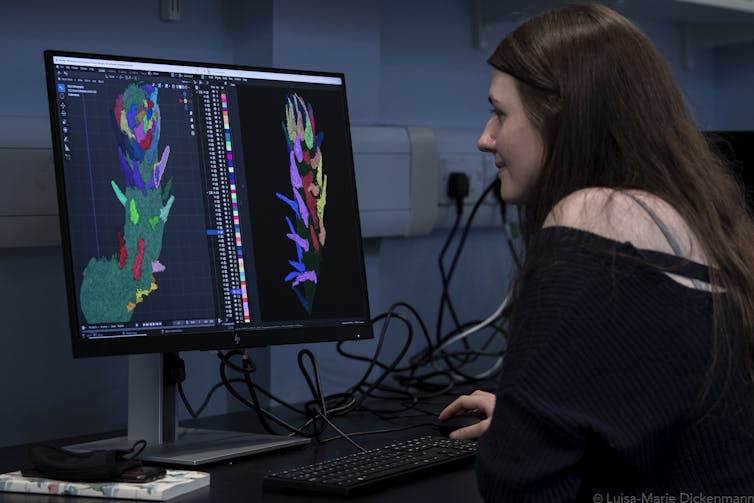
What Are Fibonacci Spirals?
Spirals occur frequently in nature and can be seen in plant leaves, animal shells and even in the double helix of our DNA. In most cases, these spirals relate to the Fibonacci sequence – a set of numbers where each is the sum of the two numbers that precede it (1, 1, 2, 3, 5, 8, 13, 21 and so on).
These patterns are particularly widespread in plants and can even be recognised with the naked eye. If you pick up a pinecone and look at the base, you can see the woody scales form spirals that converge towards the point of attachment with the branch.
At first, you may only spot spirals in one direction. But look closely and you can see both clockwise and anticlockwise spirals. Now count the number of clockwise and anticlockwise spirals, and in almost every case the number of spirals will be integers in the Fibonacci sequence.

This particular instance is not an exceptional case. In a study that analysed 6,000 pinecones, Fibonacci spirals were found in 97% of the examined cones.
Fibonacci spirals are not just found in pine cones. They are common in other plant organs such as leaves and flowers.
If you look at the tip of a leafy shoot, such as that of a monkey puzzle tree, you can see the leaves are arranged in spirals that start at the tip and gradually wind their way round the stem. A study of 12,000 spirals from over 650 plant species found that Fibonacci spirals occur in over 90% of cases.
Due to their frequency in living plant species, it has long been thought that Fibonacci spirals were ancient and highly conserved in all plants. We set out to test this hypothesis with an investigation of early plant fossils.

Non-Fibonacci Spirals In Early Plants
We examined the arrangement of leaves and reproductive structures in the first group of plants known to have developed leaves, called clubmosses.
Specifically, we studied plant fossils of the extinct clubmoss species Asteroxylon mackiei. The fossils we studied are now housed in museum collections in the UK and Germany but were originally collected from the Rhynie chert – a fossil site in northern Scotland.
We took images of thin slices of fossils and then used digital reconstruction techniques to visualise the arrangement of Asteroxylon mackiei’s leaves in 3D and quantify the spirals.
Based on this analysis, we discovered that leaf arrangement was highly variable in Asteroxylon mackiei. In fact, non-Fibonacci spirals were the most common arrangement. The discovery of non-Fibonacci spirals in such an early fossil is surprising as they are very rare in living plant species today.
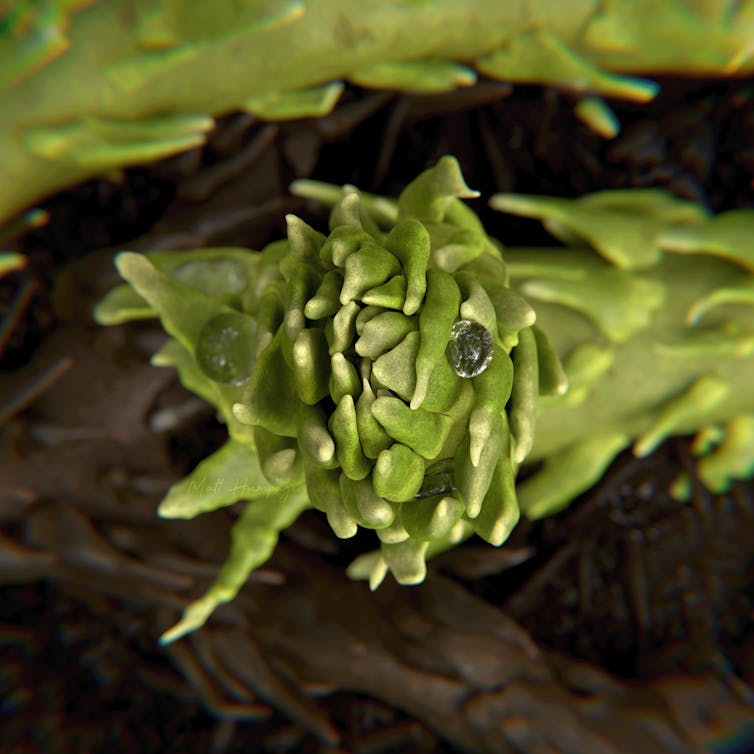
Distinct Evolutionary History
These findings change our understanding of Fibonacci spirals in land plants. They suggest that non-Fibonacci spirals were ancient in clubmosses, overturning the view that all leafy plants started out growing leaves that followed the Fibonacci pattern.
Furthermore, it suggests that leaf evolution and Fibonacci spirals in clubmosses had an evolutionary history distinct from other groups of living plants today, such as ferns, conifers and flowering plants. It suggests that Fibonacci spirals emerged separately multiple times throughout plant evolution.
The work also adds another piece to the puzzle of a major evolutionary question – why are Fibonacci spirals so common in plants today?
This question continues to generate debate among scientists. Various hypotheses have been proposed, including to maximise the amount of light that each leaf receives or to pack seeds efficiently. But our findings highlight how insights from fossils and plants like clubmosses may provide vital clues in finding an answer.![]()
Sandy Hetherington, Plant Evolutionary Biologist, The University of Edinburgh and Holly-Anne Turner, PhD Candidate, Palaeobotany, University College Cork
This article is republished from The Conversation under a Creative Commons license. Read the original article.
Avalon Beach Ladies Probus Club: July 2023 Speaker
 Avalon Beach Ladies Probus Club meets on 1st Tuesday of each month at Club Palm Beach at 10am, followed by a delicious lunch!
Avalon Beach Ladies Probus Club meets on 1st Tuesday of each month at Club Palm Beach at 10am, followed by a delicious lunch!24/7 Registered Nurse Cover And Care Minutes
Boost To Aged Care Workforce Welcomed By Southern Cross Care Qld

- increasing support to make it easier for PALM scheme workers to access their superannuation savings when they return home
- providing access to Medicare for an initial 200 families who will participate in the PALM scheme family accompaniment pilot.
Inquiry Into The Recognition Of Unpaid Carers
- Understanding the value of unpaid care.
- The needs of specific cohorts such as young carers, First Nations carers, LGBTIQA+ carers, and culturally and linguistically diverse carers.
- The meaningful role that flexible workplaces play in unpaid care.
- The government’s broad agenda in relation to the care and support economy, the importance of employment participation, and a strong focus on gender equity.
- Any other related matters, noting that the adequacy of payments for carers is out of scope for this inquiry.
Dementia Australia Awards $95,000 In Funding To Help 12 Communities Become More Dementia-Friendly
- Community Home Australia, Pennant Hills.
- Rotary Club of Gerringong Sunrise Inc, Gerringong.
Do I need a booster vaccine if I recently had COVID? What if I’m not sure what I had?

In early 2021, recommendations about COVID vaccines were pretty straightforward – get two doses, as soon as you are eligible. A year later, we knew getting a third dose was important for protection against the new Omicron variant.
Today, though, the situation is far more complex – new updated vaccines are available, the majority of Australians have likely been infected at least once with an Omicron strain, and waves of infection continue to occur.
So how should you manage and time your booster shots?
Why Do Vaccines Need Boosters?
Vaccines work by training our body’s immune system to react harder, faster, stronger and better when we get infected by a pathogenic virus or bacteria.
Unfortunately, this protective benefit is not permanent and immunity tends to “wane” over time. The extent to which vaccine protection wanes is a function of two main factors.
First, your immune system (in the form of antibodies, memory B cells and T cells) is not infinite, and the levels of vaccine-induced immune responses will gradually decline over time. Second, pathogens circulating in the community can mutate, which enables “escape” from being recognised by the immune system. The more the virus escapes, the less protection the vaccine can give you.
Some Vaccines Need Frequent Boosting, Others Last Forever
Not all pathogens have the same ability to create or tolerate mutations. For viruses that change little (such as measles), your childhood vaccines remain highly protective and you might never need a booster.
In contrast, some viruses can rapidly and dramatically change (looking at you, influenza), quickly rendering our vaccines outdated and making updates necessary.
So, Where Does COVID Fit In?
SARS-CoV-2, the virus that causes COVID, has demonstrated an ability to rapidly change since emerging in 2019. Although the early pandemic in Australia featured vaccine supply constraints, we now lucky to have many different vaccine options.
Recommendations currently favour updated mRNA “bivalent” boosters from Pfizer or Moderna, each containing equal parts of the original virus strain and an Omicron strain.
But the virus continues to change (currently XBB strains are dominant, and further updates to the composition of the vaccine are to be expected in the future (most likely to target XBB.1.5).
That’s Great, But I Recently Had COVID, So …
Are you sure? Queuing for a PCR test seems like a fever dream from the past. Now, many of the RATs stacked in our cupboards are rapidly expiring. Influenza and RSV are back with gusto (and cause similar symptoms).
If you did have confirmed COVID, our research shows the majority of people mount a strong immune response following each infection.
This means that once you recover, your immunity has been “updated” to reflect the virus variant that caused your infection and you will have higher protective antibody levels in your blood.
Well, I Definitely Had Something. What Does That Mean For My COVID Booster?
There are a couple of things to consider here.
Firstly, there is no such thing as “too much” immunity. Beyond the regular side-effects of a vaccine, there are no known additional risks to being re-vaccinated soon after an infection.
On the other hand, getting vaccinated quickly after recovery will not do much to further boost your immunity. Current recommendations are to wait six months after infection or your last dose before seeking another booster.
This allows your immune system time to rest, so that it can be effectively re-activated by vaccination. If you’d prefer to minimise your risk of COVID, and you don’t know what caused a recent illness, “topping up” your immunity via a booster may be the way to go.
How Should We Balance Booster Shots And Infections In The Community?
The short answer is, we need more information and time to figure that out.
Our communities now have high immunity (from both vaccines and infections), so balancing the risks and rewards of COVID boosters is increasingly complex.
Ultimately, your personal health care provider is best placed to offer specific advice. Generally however, those who are vaccinated (with three or more doses), younger (64 and under), and otherwise healthy have the least to gain.
For those who are older (especially over 65s) or who have health complications, regular COVID boosters are likely to be an important tool for staying healthy, especially over the winter season. While we still need more data, multiple studies suggest booster vaccines can reduce the risk of developing long COVID, providing another reason to keep up-to-date.
The Bottom Line
Unfortunately, COVID is among us and likely here for good. But like old mate influenza, we now have effective tools to blunt the impacts of COVID, and even better options will come through the pipeline to unlock further health improvements (like the transformative new vaccines for RSV).
For now, stay tuned to the latest advice from the Australian Technical Advisory Group on Immunisation (ATAGI) about additional vaccine boosters and rest assured scientists and public health officials are still working to better understand how best to maintain high levels of population immunity via regular immunisation.![]()
Adam Wheatley, Laboratory Head, Department of Microbiology and Immunology, The University of Melbourne and Jennifer Juno, Laboratory Head, The Peter Doherty Institute for Infection and Immunity
This article is republished from The Conversation under a Creative Commons license. Read the original article.
Cash could be almost gone in Australia in a decade – but like cheques, who’ll miss it?

Late last year, the Reserve Bank gave 1,000 Australians diaries and asked them to record every payment they made over the course of a week. Of the 13,000 payments, only 17 were with cheques.
It’s been an astounding collapse. Back in 1980 at the start of the credit card era, 85% of non-cash payments were made with cheques. Today it’s less than 0.1%.
Earlier this month, the government announced it was following New Zealand, Denmark, the Netherlands and others, closing our cheque system down by 2030.
Meanwhile, New Zealand is already on to the next thing. Having phased out cheques, it’s now looking at winding down the use of cash.
So how close is Australia now to becoming a cash-free nation?
The Hidden Costs Of Cheques And Cash
Cheques are horrendously expensive to process. The average cost of everything that had to happen to process a cheque exceeds $5 per payment, mostly borne by banks.
But cash is expensive in its own way. The average cost of creating, sorting and trucking all those sheets of plastic and coins exceeds 50 cents per payment, mostly passed on to banks and retailers, and it is soaring as the number of payments plummets.
As recently as 2007, the vast bulk of consumer payments – 69% – were in cash. By 2019 only 27% were in cash. By 2022, after two years of COVID, it was only 13%.
At this rate, it’s hard to be certain how long cash will last.
What Made Cheques So Slow And Costly
For those who’ve never had to write one, cheques are bank-issued pieces of paper on which the owner writes the name of the person they want the bank to pay and the amount. They they hand it to that person, who then hands it to their bank, which then tries to get the money from the payer’s bank.

Behind the scenes, until recently when the electronic transmission of digital images changed things, each bank would collect all the cheques that had been presented to its branches each day and sort them into bags, one for each originating bank.
Then, late at night, its “bag man” would travel to a nondescript city location with a bag for each bank, hand the correct one to each of the other bagmen, and be given bags in return, which the bagman would take back to the bank for signature checking.
When each bank worked out what it owed the other bank, they would usually discover the flows largely cancelled each other out, and then make net payments which would be reflected in the cheque-writer’s account, up to five business days later.
Always expensive, the cost per cheque grew and grew as the number of Australians paying with cheques dwindled to a fraction of what it had been.
How Moving Cash Became A Loss-Making Business
It’s the same sort of story with cash. Although we don’t often think about it, cash costs an awful lot to move, sort and restock.
Printing the notes still makes money – it costs about 32 cents to make each note, whether it’s worth $5 or $100, although making some coins now loses money.
The real expense is in moving notes and coins around, keeping them nearby and restocking banks and cash registers. Aside from payments the Reserve Bank makes to banks for returning damaged notes, the banks (and, through them, the retailers) are expected to pay for the lot.
Until recently that gave the two firms that dominate the business (Linfox Armaguard, and Prosegur, which owns Chubb Security) a pretty good deal.
Except that the volume of cash they’ve carried has dived 47% over the past ten years, 30% of it during COVID.
Both firms say their money-moving arms are incurring “heavy financial losses” and that if they increase their prices much more, retailers might move even further away from cash, pushing their costs even higher.

Last week, the Competition and Consumer Commission allowed them to merge on the condition that they limit their price increases to the consumer index plus 7.5% per year. That increase is so steep as to suggest a death spiral: the more they charge, the less retailers will use cash, the more they’ll have to charge.
The only way out, unless they can make really big efficiencies, or unless the decline in the use of cash stops, would be for the government to return to subsidising the use of cash. It’s hard to see how it could make the case to do that when there are cheaper emerging technologies.
Bank transfers cost a mere fraction of using cash, and pretty soon we’ll be able to use them for everything, via things such as QR codes.
So When Will Cash Go The Way Of Cheques?
A previous federal government has already tried to eliminate the use of cash for transactions worth more than $10,000, as part of its attack on the black economy.
Announced in 2016 by the Turnbull Coalition government, the ban was due to come into force in 2019. But, after delays, in 2020 the Morrison-led Coalition government backed down.
If Australia wants to ban cash (and ban it for small transactions too – cash is now used less than cards for transactions of all sizes) the easiest solution might be simply to wait.
Cards are now the dominant means of exchanging money, and electronic transfers are growing from a small base.
Pure extrapolation would suggest cash has less than a decade to go, but it will probably hang around for longer as an (expensive, little-used) backup that maintains privacy.
Like cheques, cash will probably die gradually, then suddenly. By the time it does, there will be few users left who care.![]()
Peter Martin, Visiting Fellow, Crawford School of Public Policy, Australian National University
This article is republished from The Conversation under a Creative Commons license. Read the original article.
January To March 2023 Aged Care Quality And Safety Commission’s Sector Performance Report
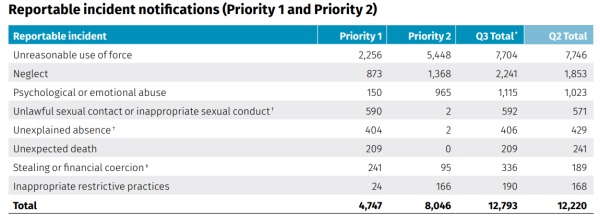
- 958 – monitoring and engagement
- 3 – directed actions to providers
- 33 – investigation by the commission
- 10 – enforceable regulatory action.
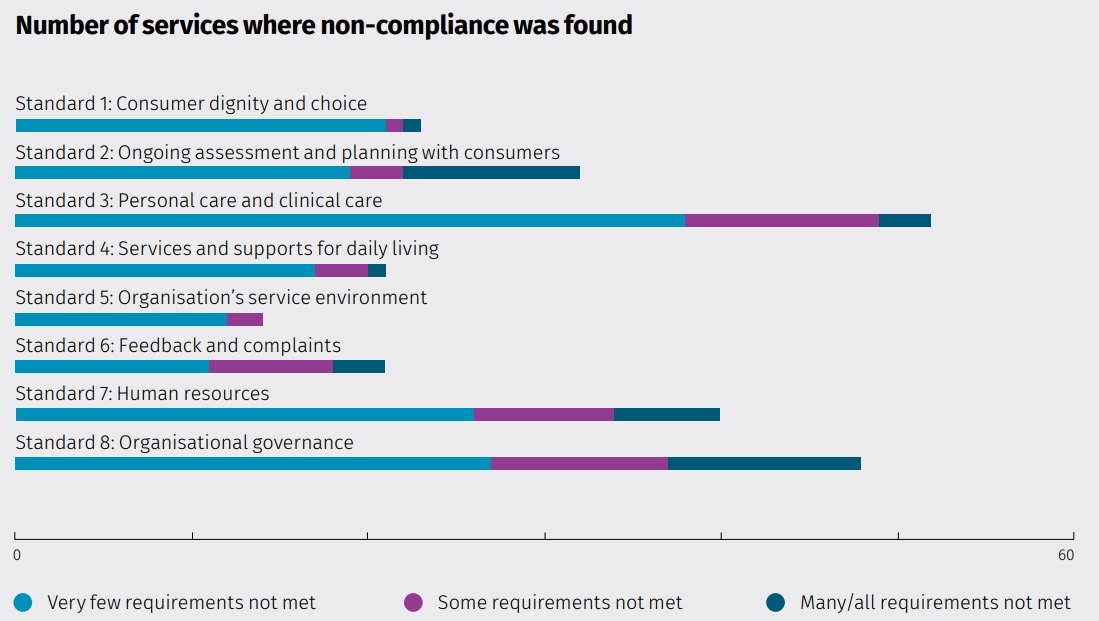
Cheaper Medicines From 60-Day Dispensing
- Cardiovascular disease
- Crohn’s disease
- Gout
- Heart failure
- High cholesterol
- Hypertension
- Osteoporosis
- Ulcerative colitis
60-Day Dispensing Is Good For Patients And It’s Time To Make It Work: AMA
Australian Of The Year – Have Your Say
Can a daily multivitamin improve your memory?

Research Checks interrogate newly published studies and how they’re reported in the media. The analysis is undertaken by one or more academics not involved with the study, and reviewed by another, to make sure it’s accurate.
Don’t we all want to do what we can to reduce the impact of age-related decline on our memory?
A new study suggests a daily multivitamin and mineral supplement is a simple and inexpensive way to help older adults slow the decline in some aspects of memory function.
The new study, which comes from a long-running clinical trial, shows there may be a small benefit of taking a daily multivitamin and mineral supplement for one type of cognitive task (immediate word recall) among well-functioning elderly white people. At least in the short term.
But that doesn’t mean we should all rush out and buy multivitamins. The results of the study don’t apply to the whole population, or to all types of memory function. Nor does the study show long-term benefits.
How Was The Study Conducted?
The overarching COSMOS study is a well-designed double-blind randomised control trial. This means participants were randomly allocated to receive the intervention (a daily multivitamin and mineral supplement) or a placebo (dummy tablet), but neither the participants nor the researchers knew which one they were taking.
This type of study is considered the gold standard and allows researchers to compare various outcomes.
Participants (3,562) were older than 64 for women, and 59 for men, with no history of heart attack, invasive cancer, stroke or serious illness. They couldn’t use multivitamins or minerals (or cocoa extract which they also tested) during the trial.
Participants completed a battery of online cognitive tests at the start of the study (known as baseline), then yearly for three years, of which only three were reported in this paper:
ModRey, measuring immediate recall. Participants were shown “a list of 20 words, one at a time, for three seconds each,” and then had to type the list from memory
ModBent, measuring object recognition. Participants were given 20 prompts with a shape and then had to select the correct match from a pair of similar prompts. After this, they were prompted with 40 shapes in turn, and had to indicate whether each was included in the original 20 or not
Flanker, measuring “executive control”. Participants had to select a coloured block that corresponded to an arrow in a matrix of arrows, which could have the same (or different) colour to the surrounding arrows, and the same (or different) direction as the prompt block.

What Did The Researchers Find?
Of all the tests the researchers performed, only immediate recall (ModRey) at one year showed a significant effect, meaning the result is unlikely to just be a result of chance.
At two and three years, the effect was no longer significant (meaning it could be down to chance).
However they added an “overall estimate” by averaging the results from all three years to arrive at another significant effect.
All the effect sizes reported are very small. The largest effect is for the participants’ immediate recall at one year, which was 0.07 – a value that is generally considered very small without justification.
Also of note is that both the multivitamin and placebo groups had higher immediate word recall scores at one year (compared to baseline), although the multivitamin group’s increase was significantly larger.
In the researchers’ prior study, the increase in word recall scores was described as a “typical learning (practice) effect”. This means they attributed the higher scores at one year to familiarisation with the test.
For some reason, this “learning effect” was not discussed in the current paper, where the treatment group showed a significantly larger increase compared to those who were given the placebo.
What Are The Limitations Of The Study?
The team used a suitable statistical analysis. However, it did not adjust for demographic characteristics such as age, gender, race, and level of education.
The authors detail their study’s major limitation well: it is not very generalisable, as it used “mostly white participants” who had to be very computer literate, and, one could argue, would be quite well-functioning cognitively.

Another unmentioned limitation is the advanced age of their sample, meaning long-term results for younger people can’t be assessed.
Additionally, the baseline diet score for their sample was abysmal. The researchers say participants’ diet scores “were consistent with averages from the US population” but the cited study noted “the overall dietary quality… [was] poor.”
And they didn’t measure changes in diet over the three years, which could impact the results.
How Should We Interpret The Results?
The poor dietary quality of the sample raises the question: can a better diet be the simple fix, rather than multivitamin and mineral supplements?
Even for the effect they observed, which micronutrient from the supplement was the contributing factor?
The researchers speculate about vitamins B12 and D. But you can find research on cognitive function for any arbitrarily chosen ingredient, including selenium, which can be toxic at high levels.
So Should I Take A Multivitamin?
Health authorities advise daily multivitamin use isn’t necessary, as you can get all the nutrients you need by eating a wide variety of healthy foods. However, supplementation may be appropriate to meet any specific nutrient gaps an individual has.
Using a good quality multivitamin at the recommended dose shouldn’t do any harm, but at best, this study shows well-functioning elderly white people might show some additional benefit in one type of cognitive task from using a multivitamin supplement.
The case for most of the rest of the population, and the long-term benefit for younger people, can’t be made.

Blind Peer Review
Clare Collins writes:
I agree with the reviewer’s assessment, which is a comprehensive critique of the study. The key result was a small effect size from taking a daily multivitamin and mineral (or “multinutrient”) supplement on memory recall at one year (but not later time points) and is equivalent to a training effect where you get better at taking a test the more times you do it.
It’s also worth noting the study authors received support and funding from commercial companies to undertake the study.
While the study authors state they don’t believe background diet quality impacted the results, they didn’t comprehensively assess this. They used a brief diet quality assessment score only at baseline. Participants may have changed their eating habits during the study, which could then impact the results.
Given all participants reported low diet quality scores, an important question is whether giving participants the knowledge, skills and resources to eat more healthily would have a bigger impact on cognition than taking supplements. ![]()
Jacques Raubenheimer, Senior Research Fellow, Biostatistics, University of Sydney
This article is republished from The Conversation under a Creative Commons license. Read the original article.
Microbiome: certain gut microbes may warn of Alzheimer’s disease long before the first symptoms begin

What if the microbes in your gut could act as an early warning system, alerting you that you could be developing Alzheimer’s disease? This might sound improbable, but recent research has found certain microbes are more common in those with very early signs of the disease, pointing to a potential new method of diagnosis for a disease that affects millions worldwide.
The gut microbiome is the collection of microbes, which include bacteria, viruses and fungi, in the gut. Having diverse populations of microbes is thought to be important for our overall health. However, in certain circumstances, the gut microbiome can also contain microbes that are harmful to our health.
In Alzheimer’s, two proteins, known as amyloid-beta and tau, accumulate abnormally in the brain. Their presence results in the characteristic memory loss and cognitive decline associated with the disease, with symptoms becoming progressively worse with time.
It’s known that amyloid-beta and tau begin to accumulate long before the onset of Alzheimer’s symptoms. It’s at this stage (known as the “preclinical stage”) that the researchers saw changes in the gut microbiome.
The researchers found distinct differences in the gut microbiome profiles of older people with and without signs of preclinical Alzheimer’s. In those with signs of preclinical Alzheimer’s, the differences in the gut microbiome appeared to be connected to the accumulation of amyloid-beta and tau proteins in the brain.
Doctors currently rely on the results of various diagnostic tests to assess whether someone may have preclinical Alzheimer’s. The researchers combined these results with their participant’s gut microbiome data and put it into a machine learning algorithm, a computer program that can make predictions based on the data that you give it
They found that including the gut microbiome data improved the algorithm’s ability to diagnose preclinical Alzheimer’s accurately. This remained the case even when not all the diagnostic test data was included.
Some of the diagnostic tests for preclinical Alzheimer’s may be unpleasant, such as a lumbar puncture, or rely on expensive imaging technologies, such as magnetic resonance imaging (MRI) scanners, access to which is known to be unequal globally.

The idea of analysing a person’s gut microbiome, which only requires a stool (poo) sample, to assess their risk of developing the disease is appealing. It would offer a non-invasive, more accessible way of identifying those at risk of developing Alzheimer’s at an earlier stage, allowing them more time to plan and prepare for the future.
It should be noted, however, that the improvement found by the study in predicting preclinical Alzheimer’s by including the gut microbiome data was quite modest. So, while analysing gut microbiome data might complement existing methods for diagnosing preclinical Alzheimer’s, it can’t replace them just yet.
Curious Finding
Unexpectedly, some of the species found to be associated with signs of preclinical Alzheimer’s have previously been thought to be beneficial for human health. One of those identified is a bacteria known as Faecalibacterium prausnitzii (F. prausnitzii), which, in a previous study, was found to be more common in the gut microbiome of people without Alzheimer’s compared to those with the disease.
It’s unclear why what are considered to be potentially beneficial microbes were associated with those with symptoms of preclinical Alzheimer’s, as opposed to those who were cognitively healthy.
One explanation might be the stage of the disease. It’s important to recognise that not everyone who has signs of preclinical Alzheimer’s will go on to develop Alzheimer’s itself. There may be changes to the gut microbiome that happen in later stages of the disease, such as the loss of F. prausnitzii.
While it might be tempting to conclude that the gut microbes identified as being associated with signs of preclinical Alzheimer’s are also contributing to developing the disease, the study does not provide any evidence of a cause-and-effect relationship.
However, if a connection can be established, it opens up an exciting possibility that future treatments for Alzheimer’s might target the microbes in our gut.![]()
Catherine Purse, PhD Candidate in Microbiology, Quadram Institute
This article is republished from The Conversation under a Creative Commons license. Read the original article.
Is leaving dog poo in the street really so bad? The science says it’s even worse than you think

What’s that smell? Is that what you think it is? You check your shoes and, sure enough, one is adorned with a sticky, foul-smelling patty of fresh wrongness. You have stepped in a landmine of the canine variety.
We’ve all been there, and we all know footpaths, nature strips, parks, playing fields and front lawns are not good places for dog poo to sit.
Yet, our streets and parks continue to be littered with dog poo. And with the pandemic driving a surge in dog ownership, anecdotal reports suggest the dog poo problem has grown only worse in recent years.
Beyond the obvious unsightliness and the likelihood of making unwanted contact with dog poo, there are some other important reasons to pick up after dogs.
Here’s what you need to know and what the science says about common efforts to deter dogs from pooping on your yard.

Dog Poo Is Linked To Illness, Pollution And Antibiotic Resistance
Dog faeces may contain microorganisms that cause illness in humans such as Salmonella, E. coli, Giardia and internal parasites.
Dog poo can also be a potential reservoir for antibiotic-resistant bacteria, meaning humans could develop bacterial infections that are difficult to treat through contact with dog faeces.
A recent Sydney study also identified dog faeces washed into storm water as a significant contributor to water pollution.
This topic, in spite of its relevance and impact, has received little attention from scientists. Thankfully, however, we have a few brave souls who can say they have studied dog crap for the betterment of humanity.
This research has revealed some patterns in where dog faeces is found in public.

Where Is The Dog Poo Problem More Common?
Dog fouling is significantly more common in parks where dogs are allowed off-leash, and areas close to car parks.
The way dog walkers have traditionally used an area may also be an important factor, with one UK study noting:
availability of bins, path morphology, visibility, and path location are key factors in determining the occurrence of dog faeces.
The same study noted that while most dog walkers do the right thing, some are too “proud to pick up”, while others make contextual judgements about where and when it could be permissible to leave dog waste. Yet others are “disengaged” dog walkers, who “will not pick up even if they are aware of the health and environmental consequences”.
Other research has suggested targeting keeping dogs on-leash between car parks and off-leash areas and providing waste disposal stations on popular dog-walking routes.
This doesn’t help if you have a neighbour who lets their dog out to relieve themselves on the nature strip (or your yard), or people who walk their dogs without carrying waste disposal bags.
And we all love the ones who bag the poop but leave the bag tied to a fence or by a gate.
What About The Old Water-Bottles-On-The Grass Trick?
Dog owners who don’t pick up after their dog can be fined, but it can be hard to catch them in the act, and reporting a neighbour to authorities can often lead to ongoing hostility.
Bottles of water on the grass is a time-honoured strategy to deter dogs, but there is no evidence this is effective and no clear reason why it would be.
Dogs sometimes like to circle and find just the right spot to go, so they may prefer an area that has fewer obstacles to negotiate. Perhaps a yard bristling with lawn ornaments would enjoy some protection. (Interestingly, science suggests dogs may circle around like this to align their body to face north.)
There are commercially available dog deterrents, but little evidence they are effective and under what conditions.
Some believe any strong scent may deter an animal with a very strong sense of smell from lingering long enough to take a dump. But scent travels, so heavy and repeated applications would likely be needed (and this strategy could have unintended side effects on native urban ecosystems).

Educating Dog Walkers Is Key
Aside from providing bags and a bin and enforcing leash laws particularly around carparks close to off-leash areas, research suggests education does help.
Messages emphasising that good neighbours and members of the community diligently pick up after their dogs may be most effective, as people are responsive to social messages.
If you have tried to appeal to your neighbour’s sense of community to no avail, and you’re not keen on a front yard bristling with garden gnomes and flamingos or drenched in possible dog-deterring chemicals, you could try providing bags and a sign promising surveillance.
For all the dog owners out there that do pick up after their dogs, your community thanks you.
The best way to dispose of dog faeces is in the bin. Composting requires high temperatures to neutralise the nasties in dog poop, and home composts are unlikely to get hot enough. And burying it simply allows these microorganisms to build up in the soil.![]()
Melissa Starling, Postdoctoral researcher, University of Sydney
This article is republished from The Conversation under a Creative Commons license. Read the original article.
Thinking of quitting your child’s swimming lessons over winter? Read this first

The weather is getting chilly and the pool is looking less inviting than ever. At this time of year, with cooler temperatures and shorter days, swimming can be the furthest thing from our minds. It’s no wonder during winter many parents pause their child’s swimming lessons.
Many local pools in country areas close during the cooler months, often reopening in spring.
So, does it matter if kids stop swimming lessons over the winter? Here’s what to consider before you pull the plug.
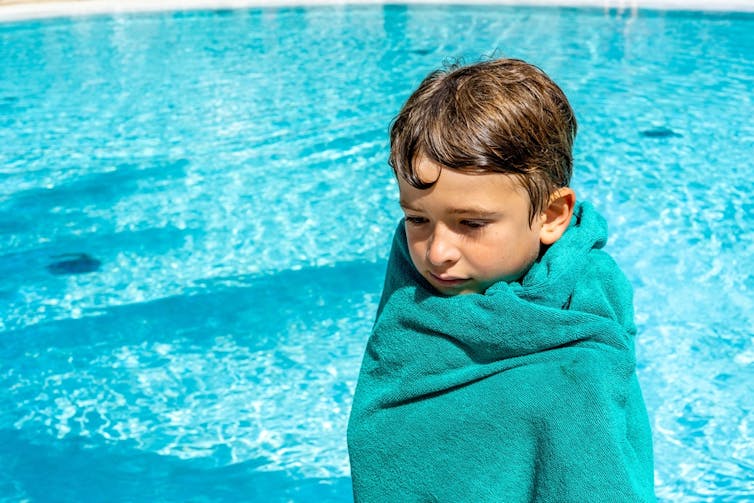
The More Time In The Water, The Better
The first thing to note is that a pause can easily turn into stopping lessons altogether. Or, it can make restarting lessons in summer tricky, as children try to remember skills they haven’t practised in months.
And it’s important to remember drowning risk, particularly for young children, is present 365 days a year.
Almost a third of all drowning deaths of children under five occur in autumn and winter.
Learning to swim is one strategy for parents to reduce a child’s risk of drowning, alongside active supervision, restricting access to water and learning CPR.
However, an estimated 40% of children leave primary school without being able to swim the length of an Olympic swimming pool. Participation in swimming lessons declines significantly after age seven.
That means the younger years represent a valuable time to ensure your child has the skills and knowledge to keep themselves safe in the water.
A 2015 study I co-authored found that, when it comes to children mastering the skill of swimming, the more time in the water the better.
One potential benefit of keeping up with lessons over winter is giving children the opportunity to regularly and continuously hone their water safety skills.
Swimming lessons offer kids other bonuses too, including physical, cognitive and language skill development benefits.
Too Many Missed Swimming Lessons
Ceasing swimming lessons in the cooler months may also mean you risk losing your preferred lesson timeslot.
It may even mean you lose your child’s place altogether, in an industry where demand often outstrips supply and waitlists can be long.
Children’s swimming lessons have also been significantly affected by the COVID pandemic.
Research has warned too many kids have missed swimming lessons due to lockdowns, pool closures, swimming teacher shortages and long waitlists.
There are fears this will lead to a generation of Australian children leaving primary school without the basic skills needed to keep them safe and enjoy the water throughout adulthood.

What About A Summer Intensive?
If you must discontinue swim lessons over winter, consider enrolling your child in a holiday or summer intensive swim course. This is where kids have lessons every day over a week or two. It may give your child the chance to catch up after taking the winter months off.
Given the near record number of drowning fatalities in Australia last financial year, and the disruption to swimming lessons during the COVID-19 pandemic-related lockdowns, it’s important we don’t lose momentum now.
Giving your children every opportunity to learn how to swim is vitally important. It could even save their life one day. ![]()
Amy Peden, NHMRC Research Fellow, School of Population Health & co-founder UNSW Beach Safety Research Group, UNSW Sydney
This article is republished from The Conversation under a Creative Commons license. Read the original article.
Change Food Choices To Increase Chances Of Tackling Global Warming
- Countries with high per capita food emission levels and dominant livestock emissions (mainly from red meat) (North America, Australia, Latin America & Caribbean);
- Developed countries which heavily rely on imports and outsource substantial amounts of food-related emissions (Japan and Europe);
- Rapidly developing countries with substantial emission increase driven by rapid population growth or improved living standards (China, South Asia, Near East & North Africa); and
- Countries with emission-intensive production, mainly with extensive land-use change activities (Brazil, Indonesia, and South and Central African regions).
Climate Action Plans Mobilize Limited Urban Change, Researchers Report
Sweeping election donation and spending reforms recommended by parliamentary committee
Michelle Grattan, University of CanberraCaps on spending and donations for federal elections and “real time” disclosure of donations to parties and candidates are among the sweeping recommendations for reform made by a powerful parliamentary committee.
The Joint Standing Committee on Electoral Matters, in its interim report tabled on Monday, also recommends donation and spending caps apply to third parties and associated entities.
The majority report also urges a new system of increased public funding for parties and candidates, in light of the impact its proposed changes would have on private funding in elections.
Under the reforms proposed, the donation disclosure level would be reduced to $1000. The present threshold (from July 1 last year) is $15,200.
The committee has also said the government should develop legislation “to provide for the introduction of measures to govern truth in political advertising”.
The committee does a review after each election.
In her foreword to the report, the committee chair, Labor’s Kate Thwaites says the evidence it heard allowed the committee “to develop clear goals for reform to increase transparency in election donations and curb the potentially corrupting influence of big money, to build the public’s trust in electoral and political processes, and to encourage participation in our elections”.
The Albanese government is committed to substantial reform on electoral spending and donations. The committee will undertake further evidence and work before its final report to be delivered late in the year.
Electoral reform is likely to become a battlefield between the government and Coalition. In addition the community candidate movement will be concerned that some reforms would disadvantage aspiring new players.
Coalition members of the committee put in a dissenting report, disagreeing with the “caps” on donations and spending as they are proposed, and with other aspects of the majority report.
Opposing spending caps the Coalition dissenting report says: “A spending cap that fails to take into account Labor’s union-funded campaign machine is nothing short of a financial gerrymander”. It also says if any caps on donations or spending are introduced, they should apply to third parties and associated entities, and any spending caps should be lower for third parties and related entities.
The report points out that while there have been reforms in many states and territories to improve transparency and accountability, there has not been substantial reform at the Commonwealth level.
“It is time for the government to reform the Commonwealth system,” the report says. It says the issues are not new and urges reform before the next federal election. Changes should be implemented together.
The report says the aims of the reforms are to improve transparency, reduce “the potentially corrosive influence of big money”, level the playing field for new entrants, ensure integrity and compliance, and allow continued participation in elections from the public, civil society, business, parties and others.
Crossbencher Kate Chaney, a member of the committee, said “imposing caps is complicated. People don’t want big money influencing election outcomes, but they also want to know they have a choice of candidates.
"The major parties have developed an election funding system that embeds them. Only about 0.4% of Australians are members of a major political party and voters want to know about other candidates too. We need to level the election playing field” by addressing party and incumbent advantages, she said.
The report notes the 2022 election saw “the rise of independents who were the recipients of donations from a significant third party - Climate 200, a crowdfunding initiative with over 11,000 Australians who provided donations’ Climate 200 raised about $13 million which was donated to selected independent candidates, Wealthy individuals also donated substantial amounts to Climate 200.”
Special Minister of State Don Farrell said, “The Albanese Government is committed to improving transparency and accountability across our democracy”. It looked forward to the final report. “Electoral reform should always be consultative and bipartisan,” he said.![]()
Michelle Grattan, Professorial Fellow, University of Canberra
This article is republished from The Conversation under a Creative Commons license. Read the original article.
Ashes rivalry is as alive as ever. But when it comes to the economics of cricket, India is in the box seat
Tim Harcourt, University of Technology SydneyThe first test of the 2023 Ashes is well underway at Edgbaston in Birmingham, featuring England’s aggressive “Bazball” style of play (named after New Zealand-born coach Brendan “Baz” McCullum) and a surprise early declaration by the hosts at the end of the first day. This invited an Australian fightback inspired by Usman Khawaja, who notched a 141-run haul before being bowled by paceman Ollie Robinson (whose expletive-laden send-off is making headlines).
England currently leads by 35 runs on the end of day three, and it all sets the scene for an exciting series.
It comes just a week after Australia won the World Test Championship, defeating India in comprehensive style at The Oval in south London.
The Ashes always excites the traditionalists, as the Australia-England rivalry is the oldest in cricket.
But while playing the old enemy for the Ashes is, for many, the pinnacle of Australian cricket, Australia-India is developing as a modern rivalry.
This is significant because when it comes to the economics of cricket, it’s India that’s in the box seat, not England.
India Is The New Cricket Powerhouse
The 2023 season of the Indian Premier League drew more than 500 million viewers, a 32% growth in television ratings on last season.
The very first IPL game of the 2023 season in fact attracted more viewers than the Super Bowl, the climax of the NFL’s American football season and one of the biggest dates on the world sporting calendar.
The first IPL match attracted 130 million viewers, compared with a record 115.1 million for the 2023 Super Bowl.
The 2023 IPL champions the Chennai Super Kings are valued at about US$1.15 billion (A$1.67 billion), according to Forbes in 2022. They’ve been touted as the “Manchester United of the IPL”, and may one day become one of the top global sporting franchises like the Dallas Cowboys (A$11.7 billion) and Real Madrid (A$7.4 billion).
So How Did India Do It?
When T20 took off in England and spread to the cricketing nations, everyone thought test cricket would die. But it didn’t. In fact, it’s stronger than ever.
If anything, it’s the game in between T20 and test cricket, the 50-over game, that’s likely to become obsolete – with only the World Cup played every four years attracting significant attention (although now the T20 World Cup overshadows that too).
India acted fast to surf the T20 wave. The IPL was formed by the Board of Control for Cricket in India (BCCI) following India’s victory in the 2007 World Cup, after a breakaway league had been mooted to break the BCCI’s grip on the game.
According to the BCCI Vice President Lalit Modi, at the time the IPL was
designed to entice an entire new generation of sports fans into the grounds throughout the country. The dynamic Twenty20 format has been designed to attract a young fan base, which also includes women and children
Part of India’s success is its size, overtaking China this year to have the largest population of any country with 1.4 billion people, as well as its economic success in recent decades with a growing middle class. By 2025, India’s middle class will number 583 million, or 41% of the country’s projected population.
This has been supercharged by the digitisation of the Indian economy, with televisions and smart phones giving the average cricket lover access to their favourite teams.
The IPL has attracted the top cricketers from around the world, mainly off the back of private franchises, many of which are owned by billionaires. This gives teams deep pockets when buying players from all over the globe, with the TV broadcast rights topping up IPL coffers too.
This has also boosted women’s cricket, including their pay packets, with the launch of the Women’s Premier League in India earlier this year.
Cricket Diplomacy
It just shows the power of India in world cricket, and more generally the power of sport in today’s global economy.
Indeed, sport is no longer about small talk, but an intrinsic part of the global economy and geopolitics.
I was in India last month hosting the “Cricket, Collaboration and Commonwealth” conference for the University of Technology Sydney (UTS) in New Delhi. There was a robust discussion on the economics of the IPL and the role of “cricket diplomacy” in Australia-India relations.
While I was in New Delhi, Indian Prime Minister Narendra Modi was in Australia speaking to packed houses of India diaspora in Sydney. Modi wanted to build on the momentum of the blossoming India-Australia partnership, after Prime Minister Anthony Albanese visited India in March.
Cricket diplomacy was on display then too, spawning now famous images of Prime Ministers Modi and Albanese on a chariot before the fourth test match in Ahmedabad.
Albanese used the trip to announce a new education deal with India. Nearly 50% of Indians are under the age of 25, and only 21% of Indians aged 25-34 have a tertiary qualification, so there are immense opportunities for Australian universities and TAFEs.
Cricket diplomacy has been central to the Modi-Albanese partnership, which highlights the role of sport in political and economic relationship building.
And the rise of the IPL has boosted India’s ascendancy as a superpower in world cricket. Its economic power has been as important as the improved on-field performance of Team India.
What’s more, the large attendances at The Oval for the ICC World Test Championship and now the raucous crowds at the Ashes shows the supposed death of test cricket has been greatly exaggerated.![]()
Tim Harcourt, Industry Professor and Chief Economist, University of Technology Sydney
This article is republished from The Conversation under a Creative Commons license. Read the original article.
Exposure To Dioxins Can Worsen Thyroid Function
High-Quality Child Care Contributes To Later Success In Science-Math
Clean Sustainable Fuels Made 'From Thin Air' And Plastic Waste
 The researchers, from the University of Cambridge, developed a solar-powered reactor that converts captured CO2 and plastic waste into sustainable fuels and other valuable chemical products. In tests, CO2 was converted into syngas, a key building block for sustainable liquid fuels, and plastic bottles were converted into glycolic acid, which is widely used in the cosmetics industry.
The researchers, from the University of Cambridge, developed a solar-powered reactor that converts captured CO2 and plastic waste into sustainable fuels and other valuable chemical products. In tests, CO2 was converted into syngas, a key building block for sustainable liquid fuels, and plastic bottles were converted into glycolic acid, which is widely used in the cosmetics industry.Crimean-Congo haemorrhagic fever – why this tick-borne virus could become more common in richer countries

Climate change is already having, and will continue to have, a significant effect on global health. This is likely to be greatest in rural poorer populations in sub-Saharan Africa. However, richer countries, such as the UK, will also probably be on the receiving end of emerging infectious disease threats as the country warms.
Infections that are mainly found in the tropics are on the move to new locations. Dengue, a virus transmitted by mosquitoes, is becoming more widely reported in European countries, particularly in some parts of Italy and France. The West Nile virus, which is also spread by mosquitoes, has been common across many states in the US, with typically more than 1,000 cases reported each year.
Another virus shifting to new locations is the Crimean-Congo haemorrhagic fever virus (CCHFV), which is transmitted by ticks. Most cases occur in Africa or Asia, but cases have been reported in several European countries, including Spain, Turkey, Greece, Russia and Ukraine, with recent media reports warning we might see the virus arrive in the UK.
So what is CCHFV, and should we be worried? Let’s take a look.
There are approximately 15,000 cases of CCHFV a year, globally. CCHFV is a serious pathogen – typically between 10-40% of people who contract the virus will die from it.
As the name suggests, CCHFV is part of a group of diseases known as viral haemorrhagic fevers. These are described as causing “severe multi-system syndrome”, meaning multiple organ systems in the body are affected. These infections can also be accompanied by severe bleeding. Other viruses in this group include Ebola, Marburg, dengue, and Rift Valley fever virus.
CCHFV is transmitted by a tick species called the Hyalomma tick. The virus was first identified in the Crimean Peninsula in 1944, with an outbreak in the Congo in 1956 resulting in the modern-day name. To avoid stigma, the linking of pathogen names to the site of the first known outbreaks is no longer practised.
A tick bite is the most common way to contract CCHFV. Though transmission has also occurred after needlestick injuries or from infected blood, meaning there is some risk to healthcare workers.
But there is little sustained transmission between humans, with outbreaks typically relying on the presence of an infected tick. Hyalomma ticks can be found on a range of animals, including livestock and rabbits. Most animals appear to be able to carry the tick and the virus without becoming unwell.
In people infected with CCHFV, symptoms typically start with fever, muscle ache or dizziness, and can rapidly progress within a few days to kidney deterioration or sudden liver failure.
CCHFV is recognised by the World Health Organization (WHO) as a virus where there has been limited research but where the pathogen is considered to be a high threat.
There is no vaccine available, nor any established antiviral treatment. However, ribavirin, a medicine used to treat other viruses such as hepatitis C, has shown some promise.
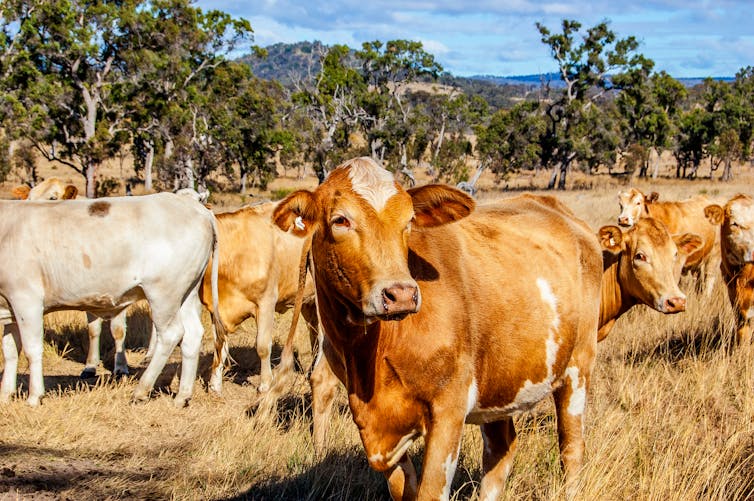
Should We Be Worried?
Within the UK, there have so far only been small numbers of imported cases, where people have contracted the virus while travelling in high-risk areas.
There is ongoing research and surveillance in areas such as marshlands, where ticks and mosquitoes are caught and studied to see if there are any new or evolving threats. The Hyalomma tick is not currently established in the UK, and so the threat, for now, is very low.
Still, there are many other types of ticks in the UK, including those responsible for causing Lyme disease, which are usually found on vegetation. They cannot walk or fly, so the public health advice for protecting against tick bites includes avoiding brushing against vegetation when out for walks, carrying out regular tick checks and using repellents.
In areas where CCHFV is a higher risk, such as during or after an outbreak, hygienic storage of meat is thought to be important, and restrictions around the transport of animals may be introduced.
There is concern from the WHO and other health experts about the global spread of this Hyalomma tick. The wide range of animals on which the tick is found means there is potential for it to become endemic in new communities. The tick has also been detected in long-range migratory birds, and was found in 2018 in Sweden for the first time.
Viral haemorrhagic fevers like CCHFV can cause severe illness and death in some people who become infected. Also, localised outbreaks can have other consequences for poor farming communities, such as the slaughter of their cattle and subsequent loss of trade.
There is unlikely to be a significant number of cases of CCHFV in the UK at any point soon. However, as globalisation increases and climate change continues to alter patterns of disease, it’s plausible that the virus might pose a sustained threat in the future.![]()
Michael Head, Senior Research Fellow in Global Health, University of Southampton
This article is republished from The Conversation under a Creative Commons license. Read the original article.
Disclaimer: These articles are not intended to provide medical advice, diagnosis or treatment. Views expressed here do not necessarily reflect those of Pittwater Online News or its staff.